




Tell us what you like And what would make your stay unforgettable. Enjoy a welcome designed especially for you.
Benefit from personalized offers, Immerse yourself in your Travel Book And enjoy new experiences.


 Geysers of Tatio, in the Andes Mountains of Northern Chile, close to Awasi Atacama, our property in Patagonia.
Geysers of Tatio, in the Andes Mountains of Northern Chile, close to Awasi Atacama, our property in Patagonia.
Welcome to the first edition of our new Travel Book, created to inspire you to embark on your next adventure. Within that simple idea lies a delicious concept: to venture further into the four corners of our beautiful planet, to crisscross the continents, and delve a little deeper. To venture further into another culture and enjoy an authentic immersion into a different way of life. This book is an invitation to do so through our 580 properties–a global family that has grown from an alliance of just eight hotels in France in 1954.
Each Relais & Châteaux property is unique–a breath of fresh air with each new encounter. Each is independently owned, often by families stretching back several generations. But each property shares the same values and has pledged to protect its cultural, culinary and environmental heritage. They are also home to the endless creativity of our chefs, who preserve and reinvent cuisine that honors local produce and at-risk–in some cases almost extinct–processes. All of these values are integral to our vision as an association: to make a better world through cuisine and hospitality.
I am particularly proud that some of our properties in France, Costa Rica, Argentina and elsewhere are laying the foundations for tomorrow’s travel. They show how hospitality can become carbon-neutral, even mitigating the ecological costs of guests’ journeys–a literal breath of fresh air for the planet.

I invite you to discover another side to Venice, to explore unspoiled nature in Norway and to cherish the fragile ecosystems of Hawaii. Travel with us from the bustle of New York to the serenity of the Japanese countryside. Whatever your destination, a Relais & Châteaux hotel will showcase our philosophy on the art of living, while a meal in one of our restaurants can be expected to be a gastronomic spectacle–our chefs hold 340 Michelin stars among them. In both cases, expect precise attention to detail and a profound sense of place.
I am delighted you are reading our Travel Book. It likely means you are already enjoying our hospitality. I hope you appreciate our perspective on the world, and that you are inspired to plan other equally rewarding journeys–to venture further still. Enjoy reading, and Bon Voyage.

French excellence across the world’s oceans and seas
Discover exceptional locations aboard environmentally responsible yachts with a refined design where respect for nature and the art of living take center stage: this is the promise of a unique and authentic PONANT voyage.

Naturally, this philosophy shared by Relais & Châteaux has led to the joint creation of a series of unique gastronomic cruises; the highlight of which are two gala dinners, each hosted by a Relais & Châteaux chef.
For unique recipes, culinary demonstrations, market visits and meetings with local producers, join PONANT and Relais & Châteaux to experience the pinnacle of French excellence at sea, and enjoy authentic, elegant cuisine at its best.

More information on ponant.com
Contact your local travel agent or call +33 4 91 16 16 27
© Studio PONANTMargot-Sib / © PONANTNicolas Matheus8
30 ROAD TRIP Our Routes du Bonheur: Gateways to the World 34 TIME ZONES One Moment, Echoed Around the World 36 AGENDA Culture Diary 2023 42 CEREMONY Time for Tea 46 WELL-BEING Cleanse the Soul: Models of Contentment

52 ITALY Venice and Beyond: Adventures Around the Lagoon 64 SUSTAINABILITY Carbon Neutrality: a Step in the Right Direction 72 USA New York’s Gastronomic Giants Rise Again 82 SPAIN The Balearics: True to Nature 92 HEALTH AND LONGEVITY The Magic Formula for a Life Well Lived 96 WILDERNESS Away from it All 106 FRANCE A Perfect Serving of Savoyard Heritage 114 CREATIVE CULTURE When Hospitality and Art Unite 120 NORWAY Jewel of the Fjords 128 VILLAS BY RELAIS & CHÂTEAUX Personal Hideaway, Hospitality Included 136 MOODBOARD Insights and Influences 144 CROATIA Variations on the Theme of Paradise 152 JAPAN Coast-Conscious: Taking Seafood into a New Era 160 USA Maui: the Life Source 166 HERITAGE New Generations 174 FRANCE The Sustainable Approach of a Modern Master
AWARDS 2023 Trophies
RELAIS & CHÂTEAUX At a Glance
INDEX Our Members Worldwide
 THE SWAG, Waynesville, North Carolina, USA
THE SWAG, Waynesville, North Carolina, USA
Inspiring encounters with 16 new Relais & Châteaux members kindle the desire to travel, with countless more properties to discover. Then adventure comes into sharp focus with our Routes du Bonheur travel itineraries; the contrasts of global tea ceremonies; well-being breaks for mind, body and soul; and a calendar of 2023’s art highlights.
 © JOAO GUIMARAES
© JOAO GUIMARAES
VINES AND OLIVE TREES AS FAR AS THE EYE CAN SEE. Plenty of horses too, because the family that owns this hotel also runs a thoroughbred breeding program. At Herdade da Malhadinha Nova, this 1,100-acre/ 450-hectare farm exudes the fine art of living on the land, mixed with a contemporary approach to rural life. Designed to blend into the surrounding nature, the property combines a sense of space and elegance with exceptional service. Guests can taste wine produced on the estate, while vinotherapy also features at the spa. The setting sun offers a sensational tableau for restaurant guests as it reflects in the swimming pool.

WITH THE RIVER OWENMORE flowing at its feet and a backdrop of forests and dramatic hills, Ballynahinch Castle is more charming than domineering. Amid lush natural surroundings offering a plethora of outdoor activities, this castle in the west of Ireland is a haven of beauty that is difficult to leave. Lose yourself in the cozy comfort of the rooms, relax by the fireplace at the Fisherman’s Pub, admire the vegetable patch in the walled garden and anticipate the mouthwatering and elegant dishes prepared by David Bodas in the gourmet restaurant.

THE DRAMATIC LANDSCAPE OF LAKE GENEVA and the Alps is the perfect pairing for the exacting standards and refined contemporary fare served in Maison Décotterd’s dining room. Located in the prestigious Glion Hotel School at the former Bellevue hotel, Stéphane Décotterd prepares fully local cuisine. Using produce from the surrounding lakes, forests and mountains, he bridges a gap between perfect nature and pure culinary sophistication. This approach has earned his restaurant one Michelin star.

IN THE SHADOW OF THE ROCK OF CASHEL, an exceptional and important medieval site in Ireland, lies another jewel, Cashel Palace, where classicism rubs shoulders with contemporary sophistication. This 300-year-old building has recently been completely restored, in keeping with its original proportions, and renovated to host guests in a bucolic setting where well-tended gardens border lush moorland. Afternoon tea is served by a roaring log fire and young thoroughbreds gallop on the neighboring lawn as you await your appointment at the spa… What more could you want?

 DOMAINE DE PRIMARD, Guainville, France
DOMAINE DE PRIMARD, Guainville, France
THIS 18TH CENTURY RESIDENCE, just 43 miles/70 kilometers from Paris, is set in grounds where charming nature has been tamed by a master of the genre: landscape gardener Jacques Wirtz. The classic lines of Domaine de Primard’s elegant façade contrast with a contemporary approach to interior styling. The same vision is also evident in the new culinary offerings presented by Romain Meder at the fine dining restaurant Les Chemins. Having previously channeled a concept of ‘naturalness’ for the Plaza Athénée in Paris, here Chef Meder pursues a cooking philosophy based on plants, sustainability and seasonality.


of Hotel & Restaurant Purs, which stands in the old town quarter of Andernach on the left bank of the Rhine, prides itself on its no-frills modesty. But interior design by Axel Vervoordt immediately creates a feeling of serenity through a harmony of soft colors, patinated walls and natural materials. The same authenticity applies in the kitchen, where Christian Eckhardt explores the harmony of produce and taste in his top-flight gastronomy, always with a touch of whimsy.
 MICHAEL KÖNIGSHOFER / AUSSEN LARS
MICHAEL KÖNIGSHOFER / AUSSEN LARS


A PRIVATE ISLAND spanning 790 acres/320 hectares, all to yourself; it’s hard to imagine a more wonderful place than this intimate location. It all began with a handful of owners whom, having fallen in love with the island, kept it secret for many years. They would meet in this very private club, recently transformed into a hotel, to revel in the incredible sunsets over the Atlantic. A landscape of white sand, blue sky and aquamarine water is punctuated with greenery that requires constant care. This mission has now been entrusted to Pine Cay, which strives to protect its environment.



THE SWAG, Waynesville, North Carolina, USA
BORDERING THE GREAT SMOKY MOUNTAINS National Park, The Swag has true soul. With breathtaking views over four of North Carolina’s tallest mountains, it is certainly one of the area’s most popular hideaways. Its new owners, a young couple who fell in love with the estate and its unspoiled nature, continue its legacy by combining excellent service with a chic rustic feel that gives guests an opportunity to disconnect from the chaos of urban life.
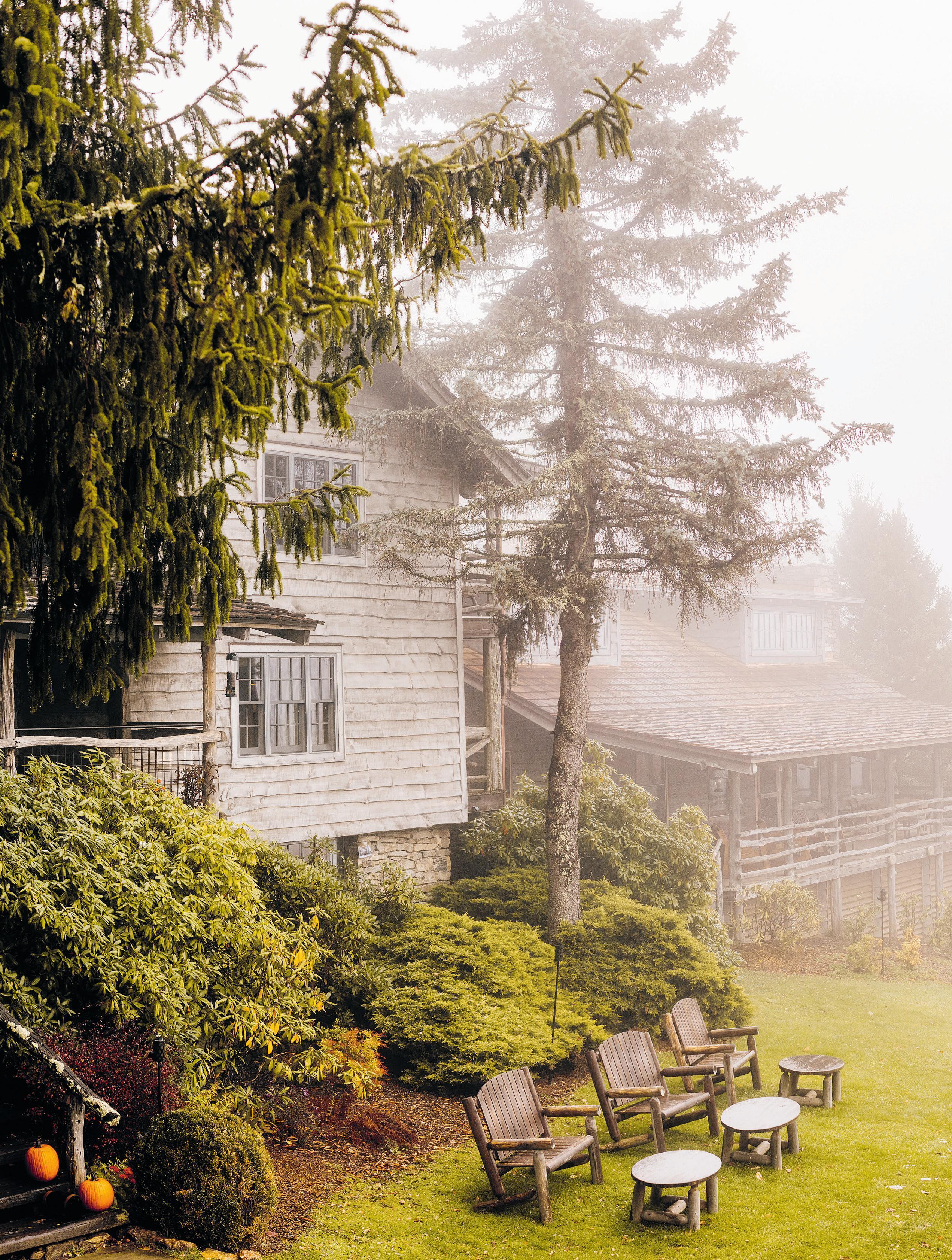 © JACK ROBERT
© JACK ROBERT
AT THE END OF A MAJOR RENOVATION PROJECT carried out with the greatest respect for the original architectural elements, Hôtel Richer de Belleval, in the heart of Montpellier’s old town, has begun writing a new chapter in its history on dual themes of art and gastronomy. In this 17th-century building, listed as a historical monument, the past and present come together: contemporary furniture meets pale stone walls while huge works of art enliven the vast interior spaces. In the kitchen, the famous Pourcel brothers pursue their gastronomic journey through a culinary style that combines terroir and travel at Jardin des Sens, their one Michelin-starred restaurant.

THIS IS THE CANADA THAT DREAMS are made of. StoneHaven Le Manoir stands elegantly in the heart of the Laurentian mountains. A stunning backdrop of natural lakes, forests and mountains contrasts with an elegant Italian garden. Contrast is also found between the different destinies of this beautiful 1908 building, originally created as a private residence before being transformed into a retreat for priests, and now reimagined as a hotel. The precise and elegant cuisine of Éric Gonzalez promises a truly remarkable form of fine dining.


 WEESHUIS GOUDA, Gouda, Netherlands
WEESHUIS GOUDA, Gouda, Netherlands
THERE IS A SLIGHTLY ECCENTRIC CHARM to this former monastery, dating from the 16th century. Today, the interior design of Weeshuis Gouda draws inspiration from the colorful, floral decorations of Gouda Plateel pottery, an institution in the Dutch town of Gouda, and a contemporary take on Art Nouveau, expressing its beauty throughout the hotel. Sitting at a table in the Lizz restaurant or at the COCO bar, the menu developed by the chef of a Michelin-starred restaurant promises an evening of delicious delight.
PREPARE YOURSELF TO BE FULLY IMMERSED in the world of wine. Nestled in the heart of a wine-growing landscape that is recognized as a UNESCO World Heritage Site, the Quinta Nova estate epitomizes the viticulture of the majestic Douro Valley. These historic lands, mentioned in maps dating from 1756, are today permeated both by ancestral know-how and a sense of hospitality, bringing the delights of fine dining and the joys of large family dinners to guests. In the kitchen, André Carvalho works closely with the house oenologist, to create dishes that reflect the terroir of the region. The restaurant, Terraçu’s, is the only one in the Douro Valley affiliated with the Slow Food movement.




STÉPHANIE LE QUELLEC has truly arrived with her new take on Parisian gastronomy. Her talent shines through in every aspect of Restaurant La Scène, from the beauty of the dining room to the elegance of every dish. She demonstrates a freedom that gently deviates from convention, with a culinary tone that takes diners on a journey from Brittany to Provence. Her open-plan kitchen provides an enjoyable spectacle, and rightly so–Restaurant La Scène won two Michelin stars just four months after opening.

FOR PEOPLE LOOKING TO EXPERIENCE the Danish art of hygge (the Scandinavian art of contentment) by the sea, Dyvig Badehotel on the island of Als in southern Denmark is the perfect place to start. With the sound of fishing boats below and the forest in the background, time seems to flow by peacefully and discreetly. The taste of the Baltic Sea influences the menu, with brasserie-style dishes featuring typical Danish stjerneskud sandwiches, as well as more refined cuisine with an emphasis on food and wine pairings.

NAMED FOR A CHAMPION FILLY bred by horse breeder-turned-hotelier Éric Feurtet, this hotel and restaurant in the heart of Burgundy is as rural as it is refined. The 198-acre/80-hectare estate he acquired, including a run-down mansion, has been transformed, restoring the house and installing ponds, an orchard and vegetable garden.
Having created Domaine de Rymska, he placed Jérémie Muller in the kitchen, who presents an ambitious menu. And, of course, there is no shortage of elegant yearlings galloping through the meadows.

 VILLA DELLA PERGOLA, Alassio, Italy
VILLA DELLA PERGOLA, Alassio, Italy
THIS LUSH GARDEN –recently declared the most beautiful private park in Italy–is perched on a hillside overlooking the sea. Here on the Italian Riviera, famous for its picturesque fishing villages, Villa della Pergola cultivates an enchantingly timeless aura. Its panoramic terraces present breathtaking views while its architectural elegance and history add to an inspiring feel. The Michelin-starred restaurant Nove has just opened its doors to Giorgio Pignagnoli, a promising young chef whose authentic cuisine is elevated with citrus fruits, aromatic herbs and edible flowers. These are just some of the reasons that make this destination one of the most magical in Italy.

Relais & Châteaux emerged from the collaboration of eight establishments along a French highway. This path, from Paris to the Mediterranean, was the first Route du Bonheur (Road of Happiness) and would inspire many others, each a new reason to discover another corner of the planet.
Text Olivier BauerIN 1954, when eight family-run properties decided to form a partnership along France’s Nationale 7 highway, a cherished vacation artery and route running north-south from Paris to the French Riviera. Each of the founding properties, located between Paris and Nice, became a charming stop along the way for those traveling the route. It was the beginning of the post-war boom and, with the rapidly expanding road networks, the road trip concept was embraced by consumers. The chance to see novel landscapes and cultures, to embrace the unknown, was in reach. Travelers could live their own versions of the works of Jack Kerouac ( On the Road ) and Bruce Chatwin ( The Songlines ), their own scenes from the movies of Jean-Luc Godard ( Pierrot le Fou ) and Dennis Hopper ( Easy Rider ).
In 1974, following a merger with Châteaux-Hôtels, the combined group was renamed Relais & Châteaux and began to showcase fine dining and its chefs as Relais Gourmands. The association expanded first in France, then around the world. Today, there are 146 Routes du Bonheur across five continents: curated itineraries that invite travelers to discover points of interest and which point them toward their next overnight stop.
Each Route du Bonheur is unique, taking in the food, history, architecture, culture and adventure of a region. They might track through Burgundy’s vineyards, skirt the Rockies or run along the Andes Cordillera. They could set out to discover ancient Polynesian customs, glide along timeless Keralan backwaters in southern India, or be designed for family fun every step of the way. Most take the road less traveled, hugging mountain curves, waterways, ridges and shores, mapped out to be savored in leisurely fashion, honoring the environment and preserving natural resources. Because today, more so than ever, a road trip must put nature first. And, at the heart of each Route du Bonheur, are hospitable and inspiring places to eat and rest, each a world of their own: properties in romantic castles, shady riads, vast American ranches, mansions overlooking Italian hills, traditional riverside ryokans, maharajahs’ palaces, wilderness lodges and more. Above all, these 146 routes provide inspiration to hit the road. You can follow them precisely using your GPS or tweak them to make them your own. With 580 Relais & Châteaux properties scattered across the globe, anyone can create their own itinerary to suit their appetite for adventure. As writer Susan Sontag wrote, “I haven’t been everywhere yet, but it’s on my list.”
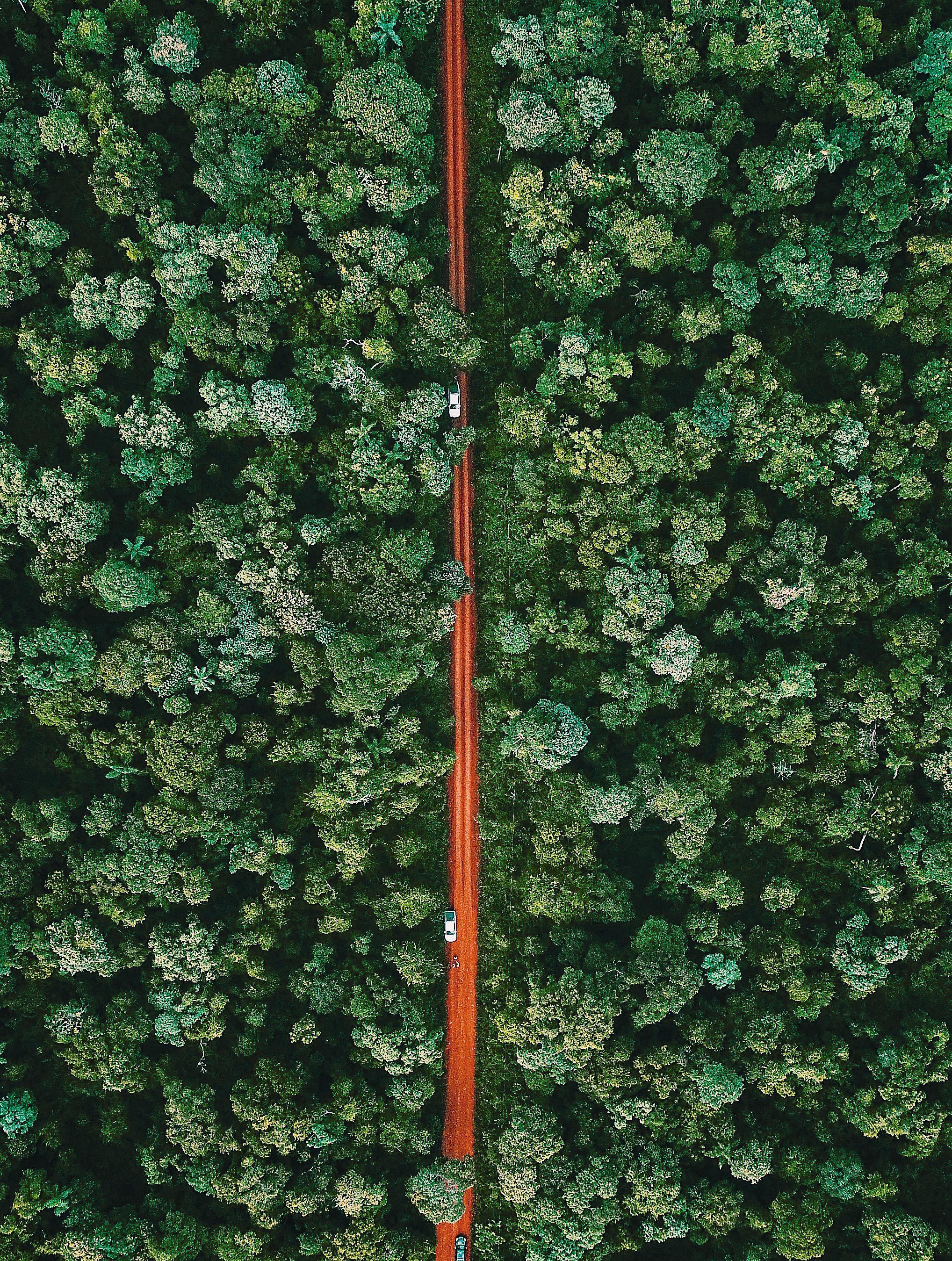

These three epic journeys from our collection of 146 Routes du Bonheur showcase the range and differing styles of the options available.

Some call this territory a ‘last frontier’–from Vancouver to Tofino, travelers become adventurers, exploring forests of giant pine trees, marveling at the Pacific, and experiencing landscapes filled with wildlife–from bears to sea lions and whales. In this untamed paradise, the human heart feels humble yet awakened.
WEDGEWOOD HOTEL & SPA, Vancouver, British Columbia, Canada HASTINGS HOUSE COUNTRY HOUSE HOTEL, Salt Spring Island, British Columbia, Canada WICKANINNISH INN, Tofino, British Columbia, Canada
Your ten-night itinerary in New Zealand

New Zealand: Land of the Long White Cloud
From the volcanoes of Tongariro National Park to Rippon’s little-known vineyards, from Wellington’s art galleries to the exhilaration of Queenstown, and from the majesty of Mount Cook to the charm of Akaroa: the many facets of Māori heritage, New Zealand epic nature and contemporary culture, all form landmarks on this Route du Bonheur.
HELENA BAY LODGE, Hikurangi, New Zealand
THE FARM AT CAPE KIDNAPPERS, Hawkes Bay, New Zealand
WHAREKAUHAU COUNTRY ESTATE, Featherston, New Zealand
OTAHUNA LODGE, Canterbury, New Zealand BLANKET BAY, Glenorchy, New Zealand
Your two-night itinerary in Germany

Abandon the beaten track to discover the bucolic side of Germany on this verdant, nature-rich itinerary. It features a treasure trove of unspoiled countryside and good taste, from the early Rheingau vineyards known for their superb Rieslings to the meandering Rhine and the lush and lovely Lahn Valley, home to forests of ancient legend.
RESTAURANT LAFLEUR, Frankfurt am Main, Germany
BURG SCHWARZENSTEIN, Ortsteil Johannisberg, Germany
HOTEL JAGDHOF GLASHÜTTE, Bad Laasphe, Germany


6:35AM
A YOGA CLASS GATHERS ON THE SHORES OF LAKE ATITLÁN , the deepest in Central America, while the waters are still calm. Around noon, the Xocomil, a fastblowing wind, crosses the lake, whipping up the waves. When performed opposite the three mist-capped volcanoes that dominate the landscape, a salutation to the sun takes on full meaning. Casa Palopó, previously a private residence, is embedded in this magnificent nature, and encourages guests to become equally at one with their surroundings.

CASA PALOPÓ, Santa Catarina Palopó, Guatemala
9:35AM
FARMERS HARVEST PRODUCE ON AN ORGANIC ESTATE. Founded by the Txai Resort Itacaré hotel, the Companions of Txai Institute was developed to protect the way of life of neighboring communities and guide them to use the resources of the Mata Atlântica forest in a sustainable way. The produce grown on this 227-acre/92hectare estate is part of a program that supports local families and strives to make visitors aware how important it is to protect the rich biodiversity of this unique environment.

TXAI RESORT ITACARÉ, Itacaré, Brazil
12:35PM
TIME FOR TEE: PLAYERS TAKE THEIR FIRST SWINGS of the day on the first par-4 hole of the golf course in Palheiro. The challenge? Not getting distracted by the stunning views over the ocean–the course is some 1,640 feet/ 500 meters above sea level. Located in hills to the east of Funchal, the Casa Velha do Palheiro is a peaceful haven, looking down onto the Palheiro Gardens, which contain myriad forest species growing alongside mature camellias and numerous exotics.

CASA VELHA DO PALHEIRO, Funchal, Madeira Island, Portugal
1:35PM
LUNCH IS SERVED: fresh, seasonal products arrive daily from vegetable gardens across France, and small miracles turn them into delectable dishes that almost look too good to eat. Nature takes on a particularly poetic form in this minimalist, two Michelin-starred Parisian restaurant , with dishes adorned with flower petals, leaves, even branches. This is the home of C hef David Toutain, who exercises his gastronomic savoirfaire, creativity and originality, refined over two decades dedicated to taste and technique.
RESTAURANT DAVID TOUTAIN, Paris, France

The sun never sets on Relais & Châteaux. This is a snapshot of activities occurring simultaneously in just a few of our 580 properties: a moment frozen in time.
 Text Sylvie Berkowicz
Text Sylvie Berkowicz
4:35PM
EXCURSIONS TO THE PRISTINE BEACHES of Grande Sœur Island, privately owned by the Château de Feuilles, are reserved for hotel guests.
At this time of day they come face-to-face with a host of rare wildlife, including giant tortoises on the sand, and colorful tropical fish and turtles in crystal clear waters. The property also works to actively preserve biodiversity, by reintroducing and protecting native birds. All tourism is carefully monitored to ensure this little slice of heaven is not exploited.
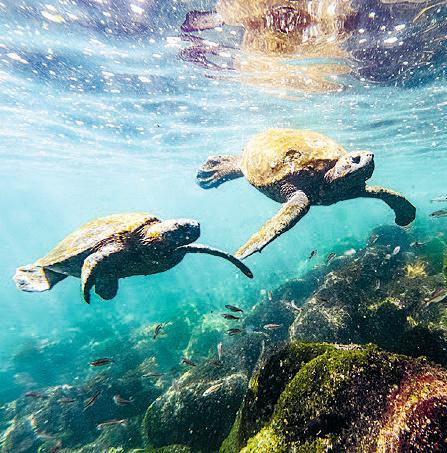
CHÂTEAU DE FEUILLES, Praslin Island, Seychelles
6:05PM
GUESTS RETURN FROM A SAFARI EXPLORING NEIGHBORING VILLAGES , their heads swimming with the people, culture and nature they have encountered. At first the Mihir Garh fort appears in silhouette, but as they grow closer it becomes clear that its architecture was inspired by the villages they passed through: Bishnoi culture permeates the entire region. The property is proud of the deep connections it maintains with the communities that surround it–local artisans were crucial to its very construction.

MIHIR GARH, Jodhpur, India
8:35PM
INSIDE THE HOTEL, THE CACOPHONY OF THE TOWN DIES OUT. This moment marks the start of a gastronomic adventure celebrating Chinese New Year, with guests looking forward to a refined dinner featuring traditional recipes from the region. Close to West Lake in Hangzhou, not far from the city’s main attractions, this hotel and its villas are nestled amid splendid gardens of trees and bamboo. The calm atmosphere is matched by the elegant lines of the buildings reflected in its many ponds.
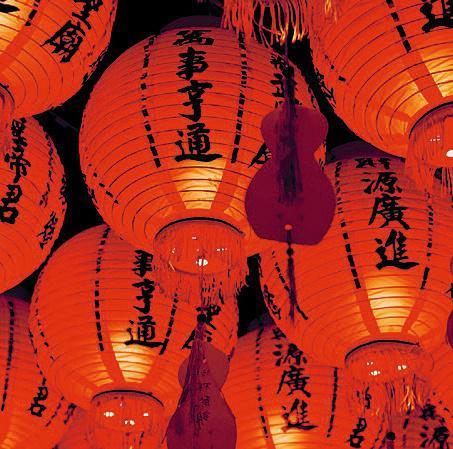
RESTAURANT JIE XIANG LOU AT SEVEN VILLAS, Hangzhou, China
11:05PM
A GOURMET DINNER DRAWS TO A CLOSE. Guests toast each other with one last sip after an exquisite 8-course tribute to the finest ingredients and wines available from both the local Mornington Peninsula region and beyond. As dinner concludes, diners are ushered through the foot of the Sculpture Park and experience the outdoor gallery as it rests solely for you. It is then that you realize that the Laura experience is elevated at every touch point, from the moment you are welcomed, through to the final good-bye.
LAURA AT PT. LEO ESTATE, Merricks, Australia
From New York to Paris, Cape Town and Bangalore, 2023 is set to be an exhilarating year for lovers of art and culture. Here are the global highlights–and the Relais & Châteaux properties perfectly located to soak them up…

Text Ian Belcher
Rijksmuseum, Amsterdam, The Netherlands
February 10 – June 4, 2023
The largest Vermeer exhibition ever staged–the first exhibition of the 17thcentury Dutch master in the history of the Rijksmuseum–includes works loaned from galleries around the world.

Alongside masterpieces such as Girl with a Pearl Earring , The Geographer and Lady Writing a Letter with her Maid , all of which reveal Vermeer’s brilliant use of light, it will display paintings never previously shown to The Netherlands’ public including the newly restored Girl Reading a Letter at the Open Window
WHERE TO STAY:
BIJ JEF, Den Hoorn-Texel, Netherlands
LANDGOED HOTEL HET ROODE KOPER, Leuvenum, Netherlands WEESHUIS GOUDA, Gouda, Netherlands
Across Berlin, Germany
March 2-31, 2023
The 10th edition of the biennial show–Germany’s largest photographic festival–spreads across Berlin and Potsdam’s museums, cultural institutions, galleries, photography schools and project spaces. Some 100-plus exhibitions highlight the work of German and international photographic artists, following a theme of Touch : the desire to establish and maintain connections, with a deeper dive into how photographic works ignite our emotions. The festival kicks off with talks, panel discussions and book presentations, alongside a huge Jubilee exhibition on Berlin’s photography scene.
WHERE TO STAY:
BÜLOW PALAIS, Dresden, Germany
GUTSHAUS STOLPE, Stolpe Bei Anklam, Germany
SCHLOSSHOTEL BURG SCHLITZ, Hohen Demzin, Germany
© VIEW OF HOUSES IN DELFT, JOHANNES VERMEER, C. 1658, GIFT OF H.W.A. DETERDING, LONDON © KULTURPROJEKTE BERLIN, OANA POPAThe Louvre, Paris, France

June 2023 – January 2024
Thanks to a Franco-Italian alliance between two major museums–both former palaces with inherited royal art collections–the Louvre will display 60 great masterpieces from Naples’s Museo di Capodimonte, including works by Caravaggio, Bellini, Titian, Parmigiano and Masaccio. Instead of a standalone exhibition, the works will be woven into the Louvre’s existing collections in the Grande Galerie, Salle de la Chapelle and Le Pavillon de l’Horloge, where drawings will include signed works by Michelangelo and Raphael.
WHERE TO STAY:
HÔTEL SPLENDIDE ROYAL, Paris, France
MARQUIS FAUBOURG SAINT-HONORÉ, Paris, France
RELAIS CHRISTINE, Paris, France
SAINT JAMES PARIS, Paris, France
WHERE TO EAT:
LA SCÈNE, Paris, France
LE GRAND VÉFOUR, Paris, France
LE PRÉ CATELAN, Paris, France

LE TAILLEVENT, Paris, France
LUCAS CARTON, Paris, France
MAISON ROSTANG, Paris, France
PIERRE GAGNAIRE, Paris, France
RESTAURANT DAVID TOUTAIN, Paris, France
RESTAURANT JULES VERNE, Paris, France
AFTER IMPRESSIONISM 1880-1914
National Gallery, London, UK
March 25 – August 13, 2023
Covering the tumultuous decades before the First World War when artists broke with tradition to create a new style of modern art, embracing Expressionism, Cubism and Abstraction, the National Gallery celebrates the achievements of three giants of the era: Paul Cézanne, Vincent van Gogh and Paul Gauguin. Charting their influence on other French and European artists, the exhibition will display over 100 works by painters from Klimt, Kokoschka and Matisse to Picasso, Mondrian and Kandinsky, alongside several sculptures including pieces by Rodin and Claudel.
WHERE TO STAY: 11 CADOGAN GARDENS, London, UK
WHERE TO EAT: BIBENDUM, London, UK
THE INTERNATIONAL AFRICAN AMERICAN MUSEUM
Charleston, South Carolina, USA
January 21, 2023
One of the world’s most anticipated museum openings, the striking IAAM–designed by acclaimed architect Henry Cobb–stands on 18 pillars above Gadsden’s Wharf: formerly a prolific slave trading port. Using storytelling, artifacts and exhibitions, the museum’s nine galleries will examine connections across the African diaspora, the spread of African American culture and influence, and the fight for equality. Helped by its Memorial Garden’s art installations and reflection pool, the IAAM aims to honor the untold story of the African American journey.

WHERE TO STAY:
PLANTERS INN, Charleston, South Carolina, USA

Whitney Museum of American Art, New York City, USA
October 2022 – March 2023
New York is the lead actor in the first exhibition to focus on the artist’s symbiotic relationship with the city he called home for six decades–the setting and inspiration for many of his most celebrated pictures. Amplifying the Whitney’s extensive Hopper collection with loans (and letters, photographs and ephemera from a recently acquired archive) it embraces his early sketches and illustrations of New York, and later paintings in which the city forms the backdrop for his evocative take on urban life.
WHERE TO STAY:
BEDFORD POST, Bedford, New York, USA
GLENMERE MANSION, Chester, New York, USA
WHERE TO EAT:
DANIEL, New York City, USA
ELEVEN MADISON PARK, New York City, USA
GABRIEL KREUTHER, New York City, USA
JEAN-GEORGES, New York City, USA
PER SE, New York City, USA



Cape Town International Convention Centre, Cape Town, South Africa February 17-19, 2023
Africa’s largest contemporary art fair draws together curators, collectors, galleries and art lovers. The 10th anniversary exhibition’s cutting-edge contemporary works will explore the notion of time, including the concept of change that comes with the passing of the months and years, for humans and the world we inhabit. With paintings, installations, textiles and sculptures by African artists from across the continent, including South Africa, Angola and Zimbabwe, Morocco, Uganda and Kenya, it also exhibits works from prestigious galleries in Paris, Milan and Barcelona.
DELAIRE GRAFF LODGES & SPA, Stellenbosch, South Africa ELLERMAN HOUSE, Cape Town, South Africa

Art Gallery of New South Wales, Sydney, Australia

December 3, 2022
Bright, white and washed with dazzling harbor light, the expanded Art Gallery of New South Wales is lauded as Sydney’s most significant cultural development since its opera house opened 49 years ago. The $244 million redevelopment by Pritzker Prize-winning architects SANAA, creates a spectacular new gallery alongside the revitalized historic property, doubling the space for the works of Australian artists from the early 1800s to the present-day, including Frederick McCubbin, Margaret Preston and John Bulunbulun, and a distinguished collection of British Victorian paintings.
TETSUYA’S RESTAURANT, Sydney, Australia
Bangalore, India
December 11, 2022
Clad in utilitarian steel panels, with its enlarged upper levels redolent of an Indian water tank, this striking museum designed by Soumitro Ghosh, the architect behind several Bangalore landmarks, delivers Indian art and culture to the heart of the community. Displayed over five stories, MAP’s 60,000 works–the core of the collection supplied by its founder, Abhishek Poddar–embrace 10 centuries of sculptures, paintings and photographs alongside textiles, tribal pieces and Bollywood memorabilia, deliberately blurring the boundaries between high art and everyday creativity.
WHERE TO STAY: SHREYAS RETREAT, Bangalore, India
CHINA
Across Hangzhou, China June 2023
Laced through galleries, museums and campuses in beautiful Hangzhou alongside UNESCO world heritage-listed West Lake, this exhibition displays thousands of works by the renowned academy’s graduates: from exquisite jewelry to traditional paintings and calligraphy, with others exploring the intersection of art and science.
As a major influence on modern and contemporary Chinese art, the academy has nurtured many famous artists since opening in 1928 and now hosts 10,000 students across four campuses, including stunning Xiangshan, home to the Kengo Kuma-designed Folk Art Museum.


WHERE TO STAY:
CHAPTEL HANGZHOU, Hangzhou, China SEVEN VILLAS, Hangzhou, China
Text Marie-Christine Clément
centuries.
Originally from China, it has traveled all around the world, becoming uniquely embedded in the culture of each different location. Variations in the way the tea ceremony has evolved offer a unique opportunity to understand the nuances, customs, tastes and trends of each society and civilization.
A decorative tray, gold filigree glasses and liquid gushing out in a noisy jet from a pot held high in an outstretched hand: the Moroccan tea ceremony is a richly sensorial experience which symbolizes the hospitality of desert nomads. It was in the 17th century, during the reign of Sultan Moulay Ismaïl, that tea was originally introduced to Morocco. English ambassadors offered it as a gift to the royal court. It was then a rare drink, reserved exclusively for the elite. In 1854, the British, looking for new markets for tea imported from India, turned to Morocco, accessible from Gibraltar. From then on, tea became part of the daily life of the entire population, regardless of social status, not least as Moroccans were already adept at brewing herbs. To perpetuate the history and port tradition of the city of Essaouira, which has seen the transit of all kinds of spices, Ahmed Handour, the chef of l’Heure Bleue Palais, has created the “ Infusion de l’Heure Bleue ” made with tea, roasted barley, star anise, cinnamon, licorice and pepper. A subtle alchemy served at the end of the meal.
HEURE BLEUE PALAIS, Essaouira, Morocco
A dense, dark, black tea dust is mixed with yellow spices said to possess Ayurvedic powers, then cooked and recooked in a saucepan with sweetened condensed milk, a generous spoonful of cinnamon, another of cardamom and one of ginger. Whether on a street corner in Mumbai, or at a chic hotel in Cochin, chai (derived from the Mandarin cha meaning ‘tea’ in Hindi) can be said to be a distillation of Indian history, for palates that enjoy the complex sensations of vibrant spices. Its composition might be said to have been created at once for coffee drinkers in search of a new stimulant, as an energizing mini-meal. The Malabar House was owned at different points in its history, by spice traders and tea traders. Kerala is the land of the Nilgiri tea (aromatic black tea) and spices, the basis of Masala chai tea. It is served in the morning during breakfast or at afternoon tea time under the veranda overlooking the playground.
THE MALABAR HOUSE, Fort Cochin, India
Brought to the English court by a Portuguese princess called Catherine of Braganza, upon her marriage to Charles II in 1661, tea fast established itself as a drink for social occasions. Originally reserved for the aristocracy, it became more popular in 1717, when Thomas Twining decided to expand his coffee house, the Golden Lyon, to open a business selling coffee beans and tea leaves. The establishment was open to all, and especially to women, who hurried
Relais & Châteaux prides itself on preserving culinary tradition, and tea drinking may just be the most traditional custom of all: our properties offer a snapshot of different consumption styles, refined over the
 Heure Bleue Palais
Heure Bleue Palais
 Glenapp Castle
Glenapp Castle
to buy their favorite teas–and so the afternoon tea ritual began.
In the exotic garden pavilions of 18th century Britain, tea and small talk became part of the daily routine. Tea was adorned with fashionable appetizers designed like colorful, creamy jewelry and served whether sweet, with plenty of milk poured first, or just a dash.
At Glenapp Castle, afternoon tea is served in fine crockery along with delicate savouries, traditional Scottish scones with cream and handmade pastries. As you enjoy a cup of Lapsang Souchong from a table overlooking a Victorian greenhouse, it’s just the place to remember those earlier trendsetters.
GLENAPP CASTLE, Ballantrae, UKTwo Japanese Buddhist monks discovered the art of beating tea under the Song Dynasty in China and brought the first tea seeds to Japan hidden in their yellow robes. A frothy drink known as ‘jade foam’ was made by whisking powdered unoxidized green tea leaves (matcha) with a small bamboo whisk. Under the influence of Buddhism, the art of the Cha no Yu tea ceremony became ritualized in the 15th century, with attention paid to every elegant little detail, in an articulation of spiritual grace. The wooden handle of the ladle is gently and elegantly caressed after drawing the spring water; the bowl is turned twice clockwise in a pure, fluid movement and three sips are taken intensely in a state of absolute bliss. This timeless ritual requires complete calm, and each carefully executed movement is considered essential.
At Beniya Mukayu, a haven of peace founded in 1928 in the hot spring town of Yamashiro, the owner Kazunari Nakamichi perpetuates local traditions inherited from previous generations and personally welcomes the guests with a dedicated tea ceremony.

BENIYA
MUKAYU,
Kaga-shi, Japan
Initiated by Buddhist monks who took it from west to east originally during the Tang Dynasty, the traditional Chinese tea ceremony Gong Fu Cha (literally ‘taking time for tea’) reflects the degree of perfection sought at the refined imperial court. With a small clay Yixing teapot or porcelain Zhong , tea is infused by pouring hot water on to dry leaves in short regular motions. As the leaves unfurl, rock oolong tea from the Wuyi mountains, a semi-oxidized tea whose leaves are withered in the sun and then brewed in a warm, humid room, releases flowery and honeyed notes. Reminiscent of orchids that grow in the surrounding trees, it fills out its aromas with roasted, deep notes. Each sip has a different taste, like drops of water in constant movement or clouds continually changing shape as they move across the sky.
The bakery at Yihe Mansions serves wonderful afternoon tea, cakes and cookies. In this Chinese tea house in Nanjing, in a labyrinth of traditional buildings, under red lanterns that tilt back and forth in the breeze, the beautiful lettering on the wall proclaims ‘tea and zen are one and the same’.
YIHE MANSIONS, Nanjing, China

Taking inspiration from local heritage and traditions, these constrasting therapeutic experiences let you dive deep beneath the skin of a destination.
Text Qin Xie

More than flavor and aroma, spices have long been used around the world for medicinal purposes. Cloves, for example, can be used to numb toothache while cinnamon is a known antioxidant. And where better to harness their power than where they’re grown? At the Senses Spa of White Sand Luxury Villas, on the spice island of Zanzibar, an intoxicating blend of local spices is combined with coconut oil to create an invigorating experience designed to improve circulation and boost your immune system. All the magic happens in an open treatment room cooled by a calming sea breeze.
ZANZIBAR WHITE SAND LUXURY VILLAS & SPA, Zanzibar, Tanzania
Onsen bathing: heal in thermal waters


Onsens are synonymous with physical and spiritual well-being in Japan.
Alongside the Shinto belief that by cleansing your body, you also cleanse your soul, there are legends of battleworn samurai who would heal their wounds in their thermal waters.
There is science behind this–research has shown that the heat and dissolved minerals of thermal springs can alleviate pain and soothe skin conditions such as eczema. At Japan’s Tobira Onsen Myojinkan, you can look out onto lush green forest as you soak up the benefits of its outdoor Setsugetsuka bath, all while being serenaded by birdsong.
TOBIRA ONSEN MYOJINKAN, Matsumoto, JapanSeaweed wrap: the ocean’s anti-aging agent
Seaweed is increasingly well-known for its anti-aging properties. Delicious as a culinary ingredient, it’s rich in minerals, antioxidants and amino acids–but it can also be used as a beauty product, helping hydrate and tighten the skin. Where better to take advantage of its beauty superpowers than right by the sea, at Canada’s Sonora Resort? Its seaside mineral wrap begins with an exfoliating scrub that combines local sea kelp with Pacific sea salt to remove dead skin cells. You then enjoy a mineral-rich wrap that hydrates and revitalizes your skin as you relax.

SONORA RESORT, Sonora Island, British Columbia, Canada

Temazcal is an intense spiritual ceremony said to feel like death and rebirth, which is perhaps why it was central to Aztec life. Believed to heal, cleanse and protect, it was used to prepare for battles, and during childbirth.
At its simplest, it’s a sweat lodge: as your heartbeat rises and your pores open, the steam forces toxins out. Often, it’s coupled with medicinal plants and chants, with the extreme physical experience leading the spiritual journey.
At Mexican resort Imanta, you can enjoy a taste of this ancient ritual, with a shaman guiding you every step of the way.
IMANTA PUNTA DE MITA, Higuera Blanca, Mexico © SONORA RESORT / GONZALO GONZALEZ


fitness for mind and body America’s love of hiking was born out of the industrial revolution. As people converged in cities, wide open natural spaces became more and more valued. Recognizing the health benefits afforded by nature, wealthy elites started coming together in outdoor social clubs in the early 1900s: some went on to help establish the country’s first national parks. At Blackberry Mountain, you can choose to hike for a couple of hours or take the whole day to explore its 5,200 acres/2,104 hectares. Its proximity to the Great Smoky Mountains means you can go off-site on guided hikes, taking in dazzling waterfalls and hidden viewpoints.
BLACKBERRY MOUNTAIN, Walland, Tennessee, USA

 BENIYA MUKAYU, Kaga-shi, Japan
BENIYA MUKAYU, Kaga-shi, Japan
A closer look at properties rooted in their regions, chefs overflowing with culinary creativity, and families that share hospitality from one generation to the next. Plus, hotels at the cutting edge of art and culture, and others working toward a more sustainable future. Then a world tour from the bustling energy of New York to the wilds of the Balearic Islands; from Japanese fish markets to Norwegian fjords; from snowcapped peaks in Savoie to the plains of Patagonia.

While visitors to Venice tend not to wander far from the principal island, often venturing only to nearby Murano or Burano, rich rewards await more curious travelers who use the floating city as a base to explore the attractions of the wider Veneto region.
Text Olivier Reneau – Photos Roberta Valerio
Left: A Franciscan friar, a resident of the San Francesco del Deserto island.
This page: Canals of the Sestiere Castello, behind the Londra Palace Venezia.

AGAIN AND AGAIN, the Queen of the Adriatic always offers something new to discover, especially if you allow yourself to roam into its lesser-known areas. For nearly 170 years, the Londra Palace Venezia has had the privilege of overlooking the Riva degli Schiavoni with its 100 iconic windows. It is also located at the gateway to the Sestiere di Castello quarter, full of authentic charm but not always a destination for visitors exploring the main island. The hotel’s director, Alain Bullo, a pure-bred Venetian, knows this part of the city like the back of his hand. Not only was he born at the nearby Pio Ospedale della Pietà, but as a youngster he would often visit his father at work–he was concierge at the very same hotel. Today, he keeps the memories of his early years in Castello alive, from his childhood adventures to his wedding at the Chiesa di San Giovanni in Bragora. As we stroll through the neighborhood, he regales us with stories of its surrounding facets: first to a nearby footbridge, next to admire a hanging garden on a terrace, then to pause in front of Sotoportego dei Preti. “This place commemorates a love story between a fisherman and a mermaid,” he says. “Venice is brimming with such legendary spots.” After an espresso at the Al Leone Bianco bar–named in honor of the feline statues facing it–we head for Burano island by boat to discover the colorful fishermen’s houses and a culinary hidden gem, Trattoria Al Gatto Nero, again named for a cat. “You’ll see, Lucia
and Ruggero Bovo are in a class of their own when it comes to cooking fish,” he says. Without hesitation, he orders a risotto di gò, made with stock prepared using this bony fish; and a plate of moeche, the soft-shelled crabs of the lagoon, leaving no doubt why he frequents this trattoria.
On our return journey, navigating between some of the city’s 117 islands, Alain shares further curiosities gleaned from a lifetime on the lagoon. “San Francesco del Deserto is occupied by a convent that the Franciscans built in tribute to Saint Francis, who lived on the island upon returning from Egypt in 1220.” The place is perfectly calm, with a timeless beauty. Pulling up alongside Sant’Erasmo, he shows us the vineyard that produced the white wine we enjoyed at lunch. Here on Venice’s largest island, known as the city’s ‘kitchen garden’ and well known for its artichokes, the Frenchman Michel Thoulouze planted old-fashioned grape varieties, such as Malvoisie Istrienne, some 20 years ago. “Orto, which is Italian for ‘kitchen garden,’ is the only wine produced here. But what a wine it is, and it paved the way for other wine-making initiatives in the lagoon,” says Alain. He disembarks at the foot of the statue of Victor Emmanuel II that faces the hotel (newly renovated in 2022), but our boat continues westward. In fact, this waterway follows one that Venetian nobles in the 16th century would take to reach their country homes. Back then, the Republic of Venice
Top left: The Londra Palace Venezia overlooking the Riva degli Schiavoni.

Top right: Alain Bullo on the Campo de le Gorne.
Above: The dining room of Do Leoni restaurant, at Londra Palace Venezia.

Bottom left: Ruggero Bovo, chef of La Trattoria Al Gatto Nero.
Bottom right: The colorful facades of houses on Burano island.




This page: Villa Foscari, the only building located along the Brenta designed by architect Andrea Palladio.
Right: Detail of a fresco by Pietro Liberi at Villa Foscarini Rossi.





 VILLA FRANCESCHI, Mira, Italy
© MR MRS PORTER
VILLA FRANCESCHI, Mira, Italy
© MR MRS PORTER
Above left: Villa Franceschi’s façade.
Above right: Flamboyant statuary at Villa Pisani, now officially a museum.

Below left: The owning family of Villa Franceschi: the father Remigio Dal Corso, the chef of the property with his sons Alessandro and Dario.
Below right: A guest room in the Villa Franceschi.
stretched from the lagoon to Padua and the architect Andrea Palladio was making a name as one of the region’s major figures of architectural innovation with his eponymous Palladian Villas, alongside other architects’ equally grandiose visions. For convenience’s sake, many such Villae Veneta were built along the Brenta River. “At the time, no fewer than 150 majestic villas dotted the banks of the Brenta,” says our guide Silvia Vallerin. “The term villa today indicates a luxurious home, but can also mean a farm estate, encompassing arable fields and service buildings.”
Today, some 60 such villas remain. The first one we come across, Villa Foscari, was designed in 1550 by Palladio for the powerful Foscari brothers, who wished to be able to reach Venice quickly from there. Surprisingly, this is the only building constructed directly on the Brenta riverfront that the architect actually designed. Its nickname, Malcontenta, refers to floods that inundate the surrounding land, though some say it refers to a certain Elisabetta Dolfin, who became a recluse there to atone for her infidelity. There is never a shortage of legends around here. Next comes Villa Franceschi, originally the residence of the doge’s goldsmiths, and now a hotel that has sought to preserve the integrity of the architecture. It is also an ideal home base to explore along the Brenta, not least because it has its own boats. Don’t miss Villa Foscarini Rossi, built in the 17th century, featuring frescoes by Pietro Liberi. It also includes a shoe museum that the Rossi family, expert shoemakers, created to showcase collaborations with couture houses such
as Dior, Celine, Saint Laurent, and Loewe, among others. Just a few hundred yards away is the imposing Villa Pisani, built in the first half of the 18th century in honor of Doge Alvise Pisani. To demonstrate the excessive nature of this building, it has 114 rooms simply to commemorate the fact that Pisani was the 114th doge of Venice. Now a national museum, it features an extensive collection of significant artwork, including an impressive ballroom ceiling painted by Tiepolo.
Continuing along the Brenta we quickly reach Padua, and our thoughts turn to food. Here, the city is enthralled by the talents of the celebrated Alajmo family. Since 2003, its Le Calandre restaurant has maintained three Michelin stars. Massimiliano Alajmo–known as Max–was the youngest chef in the entire history of the guide to reach that gastronomic grail, just 28 at the time. The chef is certainly a true genius of the culinary arts–able to reconceive ragù bolognese as a cappuccino or to dare adding licorice to a saffron-infused risotto. However, he attributes the success of this restaurant, and the wider Alajmo group, to his partnership with his older brother Raffaele–known as Raf–and a family history that stretches much further back.
Their grandfather Vittorio, a cheese merchant at the city’s market, paved the way for their parents, Erminio and Rita, to found Le Calandre in 1981.
A few years later, Raf joined his father in the wine cellar, while Max finished his studies and spent all his free time in the kitchen with his mother.
In the early 1990s, a tour of the best

This page: “Like a needle pulling a thread through a series of holes, cuisine connects us to one another̋ – Max Alajmo.
Right: Preparing the Cappuccino Murrina.


restaurants in France (Paul Bocuse, L’Espadon and Le Buerehiesel) was a revelation for the brothers, and they became obsessed with the idea of making Le Calandre one of Italy’s foremost culinary destinations. Before long, the parents allowed their sons to take over and barely ten years later, Le Calandre was named in the World’s 50 Best Restaurants. From Padua, the family brought their unique dynamic to Venice in 2010, taking over Quadri Restaurant directly on Piazza San Marco, and bringing designer Philippe Starck into the adventure to lead a major renovation. Now, the Alajmo touch can

also be found in several other locations across Venice: from the chic Amo bistro inside the T Fondaco dei Tedeschi concept store, to the casual hostaria on La Certosa island and the three restaurants located within the innovative H-Farm agricultural campus on the Venetian mainland, Le Cementine, Amor and Al 4 Pizza. The journey to the campus completes our full-length tour of the lagoon, placing us inland from its northern shores. But as we travel back to the nearby airport we’re leaving with the knowledge that there’s plenty more to discover on a trip to Venice, and the wider Veneto area, next time we’re in the vicinity.
“Having grown up in Udine, just 62 miles/ 100 km away, I have a strong attachment to Venice. My favorite season is late autumn, when fog invades the city and makes the cobblestones shine.”

Left: The Alajmo brothers: Raffaele (left) and Massimiliano.
Right: Designer Philippe Starck has completely revamped the Ristorante Quadri’s baroque ambiance in Venice.

Below: Raw fish with ginger, caviar and octopus liver pâté at restaurant Le Calandre.

Bottom: Sleek decor in Le Calandre’s dining room.

Determined to make every effort to protect our beautiful planet, a growing number of Relais & Châteaux hotels and restaurants are actively working to eliminate their carbon footprints, and helping guests mitigate theirs too–despite the distance they have traveled.
Text Anne-Charlotte de Langhe



THE BETTEI SENJUAN ESTATE LOOKS OUT ONTO THE PEAKS OF MOUNT TANIGAWA , one of the 100 most famous mountains in Japan. Within its walls is practiced omotenashi , the art of Japanese hospitality. In this ryokan in the Kantō region, where contemplation and tranquil well-being rule supreme, each room has a private outdoor bath, the space laid bare as if covered with a carpet of snow, while the library deliberately conceals itself amid tall grasses and the surrounding forest. All is quiet, all is calm. Like a gentle caress. Right down to the environmental concerns of the owner, who leaves his guests to make their own decisions. “ While it is important to us that the people who stay here understand the importance of protecting nature, we consider that the best thing is to guide them along this path as harmoniously as possible ,” says Hidehiro Kubo, with admirable modesty.

Sustainability is nothing new here. But, on the road to carbon neutrality, patience is an important virtue. To date, already three Relais & Châteaux properties have officially managed to achieve this outstanding accomplishment, and about ten other members are working towards certification–seeking to meet their guests’ expectations in terms of luxury, as well as fulfill their environmental responsibilities.
One pioneering member, Awasi hotels, has risen to the carbon neutrality challenge in Chile and Argentina, guided by EcoQualis, a specialist in sustainable development consulting and certification. Awasi’s three lodges make stunning locales for exploring the surrounding natural beauty, and its director, Matías de Cristobal, was adamant they must never adversely affect the integrity of their environments.
“Each site has between 12 and 14 villas, all of them low-impact buildings,” he says. “If they were to be dismantled tomorrow, there would be no visible traces or damage left behind.” Key to this is a mélange of carefully considered refinements to how the sites operate: reducing kitchen waste; using biodegradable cleaning products (including the amenities they give to guests); producing homemade oil and vinegar; avoiding the waste of buffet breakfasts by only serving food to order; installing beehives for honey; providing reusable water bottles, the list goes on… Little by little, Awasi has eliminated products harmful to the atmosphere and biodiversity. In terms of energy, gas has replaced gasoline; the swimming pool is heated using solar energy; and water spouts from a natural spring. The group also preserves 840 acres/340 hectares of native forests in Misiones and Patagonia. Here, it funds and works with NGOs to protect native species, like puma and jaguar, by warding off poachers and stopping land being used for agriculture. These forests absorb more than 10,000 tons of carbon dioxide per year–enough to offset emissions generated by guests’ journeys.
Francisco Ocampo, from carbon consultancy firm EcoQualis, says this challenge–neutralizing not only a hotel’s own emissions, but also those generated by its guests’ journeys–is key to the environmental transformation of the hospitality sector as a whole. “There are various ways of doing that,” he says. “The hotel can be charged directly with the emissions generated by guests’ journeys and then carry out actions aimed at reducing those carbon dioxide emissions–through reforestation initiatives, or by purchasing carbon credits on the international market. Another solution is to set up a compensation policy by factoring a kind of royalty fee into the price of the room, based on existing practise by airlines.” But is it really possible to reduce emissions without compromising on the comfort or expectations of a luxury experience? And can travel to far-flung destinations realistically coexist with going green?

 EOLO Patagonia’s Spirit
EOLO Patagonia’s Spirit
According to Rodrigo Braun, owner of the EOLO hotel, close to the Andes mountain range in Patagonia, these aspirations are not mutually exclusive and there is no need to compromise. “Everyone has their own idea about what luxury is,” he says. “But history has proven that it’s possible to change a lot of things without touching what is essential. We have chosen not to put televisions in the rooms, because they all enjoy panoramic views over the plains and mountains, lakes and glaciers.”
The strategy may not appeal to all guests, but it certainly encourages those seeking ecologically sensitive styles of tourism.
At EOLO, every bit helps: closing air inlets to reduce energy consumption and regulate indoor temperatures; using a local laundry service rather than transporting it all into the town; supporting local craftspeople to protect regional resources and preserve cultures that could otherwise be under threat from less scrupulous competitors. Changing attitudes, especially among young travelers, is driving hotels to seize the initiative of carbon neutrality. “Everything has accelerated with the global pandemic,” says Jairo Quesada, director of Nayara Resorts’ hotels in Costa Rica. “Our guests are showing more and more interest in how we are protecting the environment, sometimes even before they confirm their booking.”
To put these guests at ease, he can point to the fact that Nayara Resorts are collectively home to more than 500 species of birds, which live in a jungle at the foot of the Arenal volcano. Here, the hotel has planted 3,000 trees so far and inaugurated a sloth sanctuary to preserve the vulnerable species’ natural habitat. “Recently, I took a family out to help with one of our reforestation initiatives,” says Jairo . “Teaching children about carbon neutrality, and how green energies are the key to the future of humanity, is a wonderful thing.”
The changes initiated by this journey are also contributing to an evolution of how luxury is defined within hospitality. “Luxury is no longer about chandeliers from Italy or furniture from France,” says Awasi’s Matías de Cristobal. “We have very little furniture from elsewhere and our carpets are made by local craftspeople. Everything is designed according to sustainability criteria. Our goal is not to make guests feel ‘at home’, but for them to feel a profound sense of place.” This approach leaves no room for doubt about the dedication of Relais & Châteaux towards conscious luxury. How properties meet the challenge differs depending on their location and the culture, history and architecture they reflect. The perfect incarnation of Japanese minimalism, Bettei Senjuan already holds the Green Key Certificate. The estate involves the surrounding natural environment in decisions around its energy requirement. Melting snow and a nearby hot spring have been used for several years as sustainable alternatives to supply its prestigious facilities. In Malta, at the 17th century Xara Palace, the only hotel within the city walls of Mdina, its architecture and ancient materials mean the hotel benefits from natural ventilation, incredible light and structural advantages that modern, energy-hungry buildings can only dream about.
Nevertheless, from Chile to Japan, everyone agrees that efforts towards carbon neutrality at the various properties would be fruitless without the active cooperation of the people who work there. “Whatever position they hold, the teams feel genuinely involved and often come to us, of their own accord, to ask what more they could be doing to reduce our carbon footprint,” says Matías de Cristobal from Awasi. “The younger the employees, the more acute their awareness of how important it is to take fast action.”
At Nayara Resorts, Jairo Quesada has set up a special training unit for his staff dedicated to carbon neutrality. “The prerequisite for any type of change is to understand how you can take your own behavior in a new direction,” he says. A core challenge in the journey lies in the kitchen. Carbon neutral-certified properties, and those who aspire to
certification, do whatever they can to find and enhance local produce in order to cut the food miles of each item they source. “The more we are aware of the incredible wealth we have at our fingertips, the more determined we will be to protect it,” says Mauro Colagreco from Mirazur, a three Michelin-starred restaurant on the French Riviera. Two years ago, this famous Mediterranean venue achieved a world-first, having completely eliminated plastic across its operations. It took the team four years of effort and cooperation with suppliers to achieve this objective, having striven to find alternatives that were not only more respectful to the environment, but also more efficient. “We even found a fully compostable plant-based cling film,” says Mauro. The chef’s motivation comes from being a staunch defender of plasticblighted oceans–no surprise, perhaps, given the restaurant’s unrivaled

Mediterrean views. “A gastronomic experience must be something to enjoy and share, something that helps you cultivate a feeling of gratitude towards the land and sea,” he says. “With all the challenges we face around the world, we must now redefine the notion of luxury.” As more hotels and restaurants are determined to walk a path to a better world, it is reassuring that new opportunities are emerging, even if the stakes seem ever higher. Nayara Resorts has become carbon neutral by buying clean energy vouchers that mitigate the environmental effects of guests’ journeys–creating an inspiring new business model for others to emulate. Meanwhile, EOLO in Patagonia has set itself the goal of being completely energy self-sufficient by 2028. “The further we go, the more high-end travel will become inseparable from sustainability,” says Rodrigo Braun.

Do you think it is possible to reconcile environmental responsibility with the desire to enjoy unique hospitality experiences?



The hospitality industry has always been a space for radical innovation in how we live, serve others and enjoy life. The key here is to invite every operation to connect with the social and environmental fabric of their surroundings. Discovering the world’s natural and cultural wonders must now be done with conscious awareness: pleasure with purpose must be one of the pillars of exceptional journeys.

What are the most effective solutions to reverse climate change?
According to Project Drawdown, the three most potent solutions to reverse climate change are reducing food waste, improving family planning and education, and encouraging plantrich diets. These measures would sequester 235.73 gigatonnes of carbon dioxide by 2050–far more than could be achieved by conservation and reforestation, or even switching from fossil fuels to renewables. It is essential to understand that the food system accounts for about a third of global carbon emissions, and food waste alone represents about 8% of all emissions. In comparison, aviation represents about 2.5% of all emissions.
What is the difference between carbon neutrality and net zero emissions?
Net zero means to go beyond mitigating just carbon emissions and includes emissions of all greenhouse gases, such as methane, nitrous oxide and other hydrofluorocarbons. The meat industry, for instance, is a major contributor of methane. It is important to rethink having beef on the menu, if it is not sourced from regenerative farming methods.
“PLEASURE WITH PURPOSE MUST BE ONE OF THE PILLARS OF EXCEPTIONAL JOURNEYS. ”
Charles Michel, food educator and activistNAYARA SPRINGS, La Fortuna de San Carlos, Costa Rica THE XARA PALACE, Mdina, Malta MIRAZUR, Menton, France ©
After the lockdown forced New York’s restaurants to close, the city’s fine dining doyens had to contemplate their very survival. But this is a city that never stops evolving, and while some venues were forced to close their doors forever, others have emerged resplendent.
Text Nathan Thornburgh – Photos Clay Williams
Warm peach with almond and cherry cake, cherry sorbet and frozen vanilla custard, a dessert from Eleven Madison Park.

FROM A CERTAIN PERSPECTIVE, THE QUESTION OF FINE DINING IN NEW YORK IS A QUESTION OF APERTURE: how much of the ungovernable energy of the city do you allow to enter? JeanGeorges Vongerichten at Jean-Georges and Thomas Keller at Per Se went wide open, allowing the life of Columbus Circle to flood in through over-sized windows. Daniel Boulud of Daniel chose to tuck his dining room away and offer something of a refuge, with a jewel box of a dining room set far off the streets, while Daniel Humm at Eleven Madison Park occupies a grand, gallery-like space that is also one step removed from the frenzy outdoors, calmly overlooking the leafy park the restaurant takes its name from. Gabriel Kreuther has a bit of both in his eponymous Midtown restaurant, with a wide outdoor patio across from Bryant Park, combined with a serene interior laced with hints of his home in Alsace.
Five chefs, five Relais & Châteaux restaurants: five distinct visions of fine dining in New York City. They were all changed by the lockdown. Some became more civic-minded, some streamlined their operations, some used the time for research and development. But one thing we can report after spending time with these chefs and eating at their restaurants: they are back. And so is the city they serve.
Gabriel Kreuther: an evolving taste of Alsace in Midtown Lights inspired by the streetlights of his Alsace hometown, Niederschaeffolsheim in France, their ubiquitous stork designs a symbol of Gabriel Kreuther’s homeland. Tiles that nod to Alsatian hearthstones. The leitmotifs of a land far away are threaded throughout his eponymous restaurant. “I always wanted to create my own place,” he says with a laugh. “I just never thought it would be in New York.” But it is, despite the old-world grace notes, the quintessence of a New York restaurant. It starts with the small heresies on the menu. The sturgeon & Sauerkraut tart. The white asparagus cooked in clay with kombu for a gentle wave of umami. Alsace and Bryant Park, of tradition and reinvention: that would have neither sprung to life nor been well
Above: Chef Gabriel Kreuther in his Midtown restaurant, framed by a wall of storks, the symbol of his Alsatian homeland.

Facing page, above: Fresh cherry soup, kataifi tuile, cherry marmalade, lime sherbet and Thai long peppercorn.
Below: Nostalgia and New York technique mix on the plate as well, as with the white asparagus cooked in clay.
CLAY WILLIAMS“New York is my home. I was born and raised here. There is always something new and interesting around every corner. I loved getting into the kitchens with these chefs and seeing how much love goes into creating the best experience for diners.”

accepted in, say, Niederschaeffolsheim. “We are always open to the new,” says Chef Kreuther, “but never going away from quality.” After the pandemic, the challenge of maintaining that quality, and bringing Midtown diners back, were manifold. Also the simple things, like not bumping into each other in the kitchen. “You think a team that worked together for five years could just come back together,” he says. “But things didn’t happen just like that.” As they relearned the ballet of the kitchen, they added delivery, à la carte options, anything for diners’ comfort. They opened one of Midtown’s great sidewalk patios to withstand changing indoor restrictions. And together, along with diners themselves, they relearned what fine dining should be in Midtown Manhattan. And it all leads to this, my favorite bite from my visit: a perfectly balanced summer dish of citrus-cured fluke with avocado, fermented farro and a mandarin vinaigrette. A masterclass in texture and brightness, and not very Alsatian after all.

 GABRIEL KREUTHER, New York City, USA
GABRIEL KREUTHER, New York City, USA
Top: Hiramasa rillettes on an ‘everything’ bagel, with pickled pearl onions and Regiis Ova caviar.

Below: Chef Thomas Keller’s Californian roots are in constant interplay with New York’s fine dining sensibilities.

Per Se: the view from the top Table 35 is the best seat in the house at Per Se, or at least in the salon: it’s essentially a loveseat directly facing the floor-to-ceiling windows, fully enveloped in those signature views across Central Park and beyond. It’s Manhattan as aquarium. “I’ve always wanted to [run] an iconic restaurant in New York City,” says chef and proprietor Thomas Keller. “You can feel the sheer spectacular energy of the city. It’s raining, and you feel the thunder. It’s snowing, and you feel a sense of calm as it falls onto Central Park.” The ties to his French Laundry, 3,000 miles/4,800 kilometers away in California, remain strong. It’s in the
PER SE, New York City, USA
Oysters and Pearls, which will forever be on both menus and which remains a triumph of Chef Keller’s mix of double entendre and flawless execution (the ‘pearls’ are tapioca, of course, and the dish is still every bit the delight of savory silk sabayon it has always been). In the kitchen there’s also a two-way live video feed between the two restaurants, and the daily menus of both are taped to the pass. But being in New York City doesn’t just mean that you can legally serve foie gras (Per Se’s foie ‘pastrami’ would be quite illegal in California). It also means having navigated the pandemic in an urban environment, and now taking part in the surge of renewed energy in a liberated city. Throughout, Keller’s convictions about Per Se never wavered: “ [Fine dining] has a place in New York. It just does. ” As proof, take the success of its newest tasting menu, an upmarket version of the regular prix fixe, featuring classics from Keller’s past and more luxury ingredients. At $850 per person, it is one of the most expensive tasting menus in New York. The view, as always, is included in the cost.
© DAVID ESCALANTE © DEBORAH JONESDANIEL, New York City, USA
Daniel: the details that matter

We have an issue with the lights. We need them dimmed a bit for the photos. From his seat on a banquette in the lounge, Daniel Boulud calls out gently to a staffer who can’t figure out how to adjust them. Boulud directs them remotely, to a panel in another room. “Right after the entrance of the door. On your right, open the door. Second button from the top. Good. Press that.” I had come to talk about duck or lamb or maybe that gorgeous art deco bar. But first, he was giving me a lesson in the details. For a chef whose empire has not only survived the pandemic, but has even grown in its wake–one of the newest in the portfolio is the ambitious Midtown seafood restaurant Le Pavillon Boulud has an absurdly intimate knowledge of his flagship restaurant, from every slight inflection in the changing menu to every light switch. This command of the small things has helped him through the plunge of the pandemic. He went from 825 employees to 15, almost overnight. But then he hired the teams back to cook in ghost kitchens. He partnered with Food1st Foundation which has helped produce thousands of meals for healthcare workers and New Yorkers in need. The return of the restaurant was more difficult: “Fine dining was really challenged,” he says. “because [it] requires a lot of staff. And everyone’s staff had been dispersed.”
Now, they are regaining their full swagger, in a Manhattan that is fast filling up again. I ask what dish is most typical of his style of New York fine dining (discreet, luxurious, hidden away from the stress of the sidewalks). He suggests squab–but not for a play on the city’s ubiquitous native pigeon. Rather, he sources it from a small farm in Pennsylvania, and then the rest is, well, pure Boulud: crusted with black pea and Madagascar pepper, and served alongside small, seasonal Easter Egg radishes, the squab legs stuffed with the liver and cooked in a pastilla with Ataúlfo mango and peewee potatoes. It is decadent but earthy, locally sourced but with an eye to the globe. It is Daniel, and it is good to be back.
Top: Chef Daniel Boulud

his flagship restaurant Daniel on Manhattan’s Upper East Side, relies on creativity and attention to detail to convey his vision of French cuisine to his New York City clientele.
 at
at
This page: King Crab dumplings, Gold Bar squash broth and lemon balm at Jean-Georges.
Facing page: Chef de Cuisine Joseph Rhee puts the finishing touches on Jean-Georges’ signature dish: caviar, sea urchin, crispy potato and yuzu.
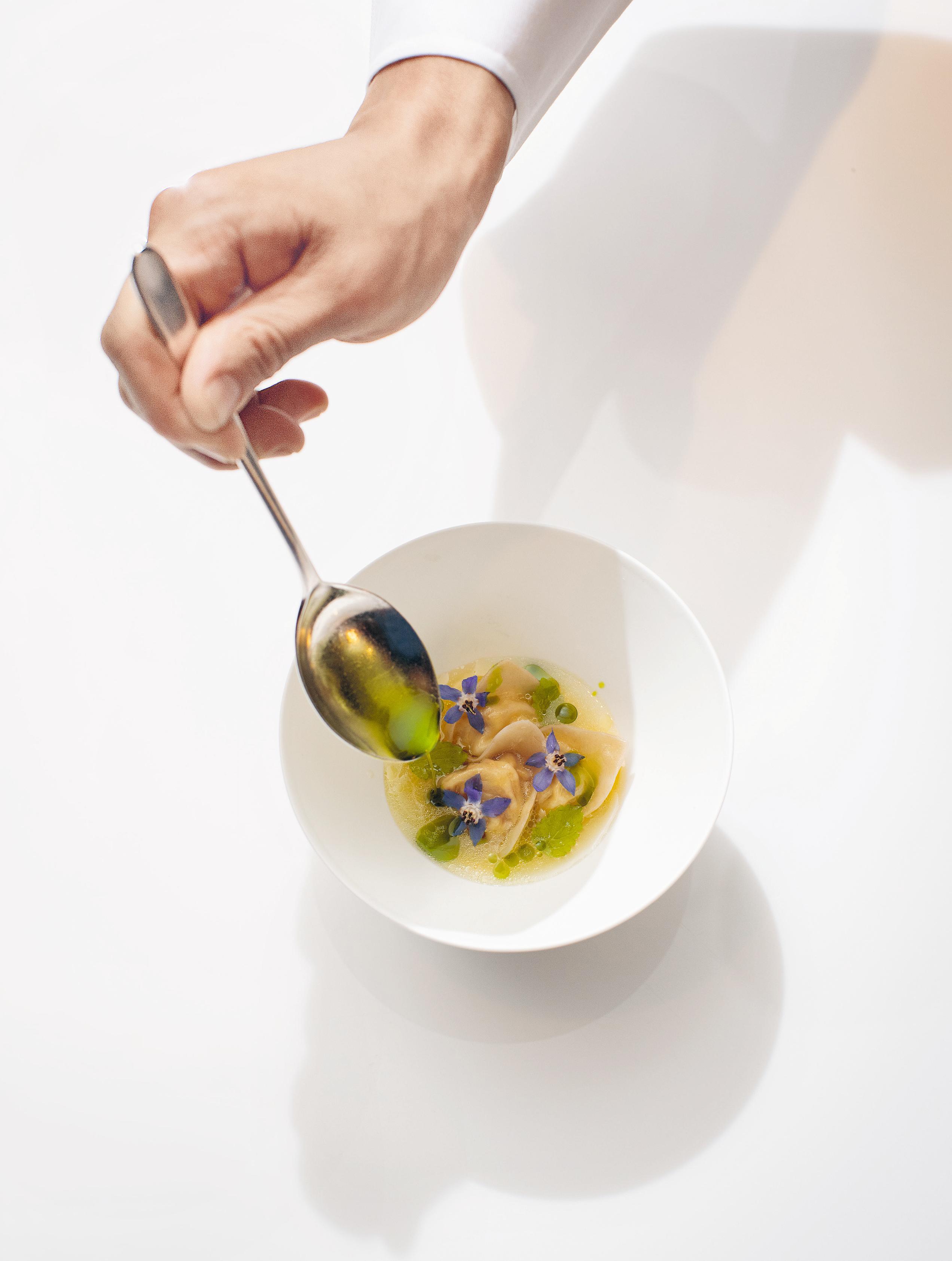

Above: Chef Daniel Humm, in the atrium of Eleven Madison Park, took inspiration from New York’s creative community. For constant reinvention, he decided to transform EMP into a completely plant-based experience.

Right: Sunflower salad with summer beans, epazote and savory.

The New York I fell in love with decades ago was an unhealthy place, a city of chain-smokers, of porterhouse and peated scotch and other scheduled drugs. No wonder people were suspicious of Eleven Madison Park’s new plant-based menu. Being healthy is just not in our culture. But you only need talk to Daniel Humm for a minute to realize that his decision–an earthquake of a resolution that rattled the windows of his business, his reputation, and the entire fine dining world–is driven by many things, but it’s not really about health ( “a side benefit,” he calls it). It’s about the planet, about the pandemic. It’s about having barely survived bankruptcy during lockdown, how they used their kitchen as a commissary to feed hungry New Yorkers until they could reopen.
And as ‘EMP’, as it’s known, tilted toward reopening, chef Humm channeled the artists he counts as friends and mentors in New York. “It’s beyond an inspiring city,” he says. They used the pandemic as a chance to ‘edit’, to strip out the unnecessary elements in life and work. At ‘EMP’, he thought, people come for the experience, not a specific ingredient. So why did he need meat and animal products? “We were stuck in this sort of expectation of what a Michelin-star meal is supposed to be,” he says. “I just was really excited to propose another way.” That other way is off to a strong start. In three bites of the Sunflower with summer beans, I felt I was already in some other country, some imagined place where this was the traditional cuisine. It’s an earthy bar of summer bean, tomato and candied sunflower seeds, topped with sunflower heart that has been sliced thin like an artichoke, then studded with sunflower petals three ways: fresh, crisp and made into a kimchi. That’s this season. What will ‘EMP’ be doing five years from now?
“I know that it will continue to be a work that has a meaning beyond the walls of this restaurant,” says Chef Humm. “With plant-based cooking, we’re now in the second summer season… we have just scratched the surface.”

Jean-Georges: a menu that travels There is something appropriate about the fact that Jean-Georges Vongerichten’s signature restaurant lies in the shadow of the iconic, stainless steel Columbus Circle globe sculpture. Forget the deep Alsatian roots, the classical French training: the food of Jean-Georges is, in a word, global. You could spin that 30-foot/9 meters globe, smush a finger down on it at random, and you’d likely be pointing to a place he’s been, or where he’s planning to go, or perhaps even where he already has one of his 50 or so restaurants. In the shadow of that globe, I’m tasting tonburi , the ‘land caviar’ of Japan’s Akita Prefecture; then a delicate sashimi of sugar snap peas, mint and buttermilk; then caviar heaped on uni heaped on crisp potatoes like a ziggurat of high-end ingredients. If every good menu is an autobiography, this summer, Jean-Georges is definitely telling the story of his years spent in Asia. “The travel really opened my palate and my horizon. Using chilies, lemongrass, ginger, all those ingredients,” Chef Vongerichten
says. “New York was a perfect canvas for that.” If anything, he says, the pandemic has accentuated demand for that kind of European-Asian-American crossover menu. The previous clients left town. “We have a much younger demographic now,” he says. “People are looking for an experience, to really travel with us.”
As the interview wraps, Chef Vongerichten tells me about his next culinary adventure: he was about to head out into Manhattan in search of a different cross-cultural, migratory dish that has become a part of the fabric of the city: a slice of pizza, enjoyed best on the streets.
Above left: Chef JeanGeorges Vongerichten’s flagship restaurant, Jean-Georges, adjacent to Central Park, draws on his Alsatian roots and his years in Asia for its palate.

Above right: Madai sashimi with market peas, lemon balm and buttermilk emulsion.


Mallorca and Menorca, the two largest Balearic Islands, are staking their economic survival on protecting nature and preserving their precious resources and cultural heritage. Though something of a paradigm shift for Mallorca, the most-visited island in the archipelago by some margin, for Menorca it’s more a matter of staying the course.
Text Hélène Huret – Photos Alba Giné

Top: Chef Andreu Segura prepares Arroz Brut, an emblematic dish of Mallorcan gastronomy

Above: Made with a broth of trumpet of death mushrooms and duck bones, Arroz Brut de Son Brull is spiced with cloves, Jamaican pepper, black pepper and nutmeg.

TREES, the road to Pollença in the north of Mallorca winds languidly towards the Serra de Tramuntana, the mountain range that runs along the island’s west side and which is a listed UNESCO World Heritage Site. At the foot of the mountain known as El Puig de Santa Maria stands the imposing Son Brull Hotel & Spa. This massive edifice of golden stone, dotted with dozens of narrow windows, stands out starkly from the surrounding vegetation. Once abandoned for years, the Suau family has restored this former monastery to its former glory.
In the 1960s, tourism began having a swift and profound impact on Spanish society. Mallorcans were abandoning their farming properties and seeking work on the coast. Why till the soil in the blazing sun? The island’s future was unfolding by the sea. Llorenç Suau invested in this nascent industry, working along the Bay of Palma, where all-inclusive hotels were springing up everywhere. He bought his first hotel near Pollença, his second in Alcúdia. But the more tourism spread throughout Mallorca, the more the Suau family bemoaned the island’s loss of authenticity. “We wanted to assert our Mallorcan identity and show guests how rich the local culture is,” says Miquel Suau, one of Llorenç’s three children. While in Switzerland at the Glion hospitality management school, Miquel discovered Relais & Châteaux. The family already embodied the values of the association and, in the 1990s, one of their hotels became the second Relais & Châteaux property in Mallorca. A new idea took root: “Every time we passed Son Brull, we imagined what we could do with it, ” says Miquel. In the late 1990s, the stars aligned and Son Brull came up for sale. Llorenç sold the hotel in Alcúdia, bought the monastery, and turned over management of the project to his children. “ We didn’t want imitation, ” says Miquel. “We restored everything that could be restored, then decided that everything else would be modern.”
The hotel opened to guests in 2003, instantly serving as a model for other hoteliers eager to showcase the real, rural Mallorca. What the Suau family established, nearly 20 years ago, turned out to be the perfect manifestation of an emerging form of agrotourism–one that supports sustainable development. It is exactly this that the Balearic government is now officially promoting in the transition to ‘deseasonalized’, year-round tourism. In 2022, Mallorca joined the United Nations World Tourism Organization (UNWTO) International Network of Sustainable Tourism Observatories: as the island depends entirely on tourism

for its economic survival, it must protect the nature, resources, culture and people that draw those visitors. Expressing a harmonious coexistence of past and present are Son Brull’s four new villas and its spa. The facilities’ contemporary lines and materials, designed in 2018 by architect Carme Pinós, almost seem to vanish into the landscape, beneath roofs covered in Mediterranean plants. While construction was underway, every effort was made to ensure the new additions would operate sustainably. “We modernized the wastewater treatment system and put it underground, so it can be used to water the grounds and plantations,” says Miquel.
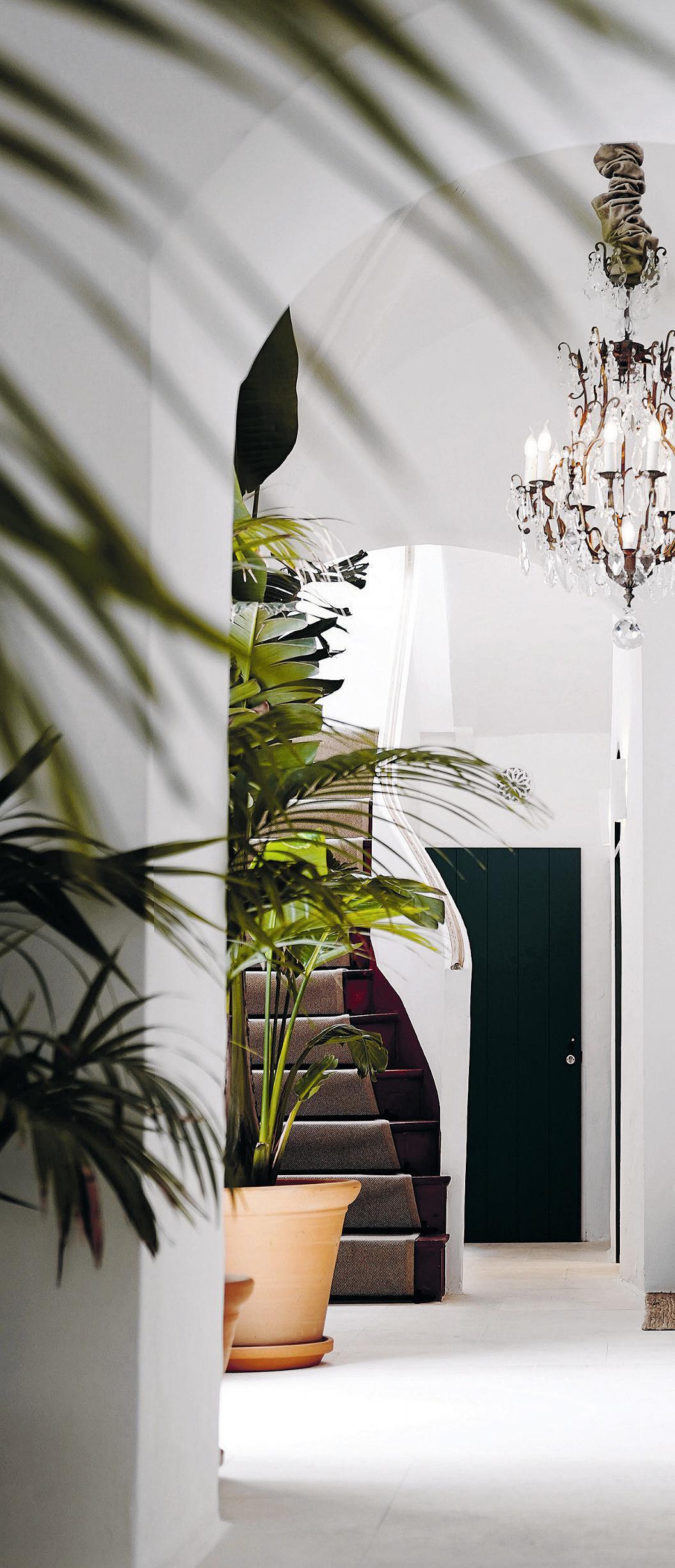
The family also felt it important to preserve the property’s original use: in the 18th century, Jesuits built the monastery on what had once been a farm with olive, lemon, orange and fig trees, grapevines, vegetables and livestock. Today, the hotel still produces its own wine and olive oil, both of which can be tasted at the hotel bar, located in the oil mill–an enormous room home to two long wooden beams responsible for operating the heavy stone press.
The Suau family plans to quadruple the size of the vegetable garden and to plant ramallet tomatoes, a native local variety sold in hand-braided ropes in every market on the island. “The more Mallorcan you are, the more authentic you are, the more original you are,” says Miquel.
In the kitchen, Andreu Segura respects this maxim. Chef Segura, from Pollença himself, has been at Son Brull for six years and spent much of that time reworking island classics. The tumbet, a sort of Mallorcan ratatouille, is served tapas-style, while Arroz Brut, a popular rustic dish, is dressed up with a black-chanterelle broth, a slice of foie gras and short-grain Bomba rice from a nearby farm on the Sa Pobla flatlands less than 10 miles away.
In a reflection of Mallorca’s hunting culture and meatbased cuisine, his signature dish is an earthy interpretation of an island culinary tradition made with lamb: a dish consisting of a brain fritter and tongue with capers. For evening meals, the sommelier suggests wine pairings that represent the diversity of the island’s resurgent winegrowing industry: having been dying in the 1980s, today there are nearly a hundred bodegas, with many replanting native grape varieties such as Callet, Manto Negro and Prensal. The Mallorca-Menorca crossing only takes an hour. So close, yet so different: Menorca is a land of preserved nature, an Eden floating in the Mediterranean, where life is about the simple pleasures of old that are once again highly coveted.


MENORCANS ARE VERY INVOLVED IN PROTECTING THEIR NATURAL TREASURES AND HERITAGE. BEACH CLEANUPS ARE PART OF LOCAL CULTURE.
A dish from the NURA restaurant in Santa Ponsa: Cauliflower Vichyssoise, white asparagus, Menorca prawns, cauliflower pickles, crispy turmeric and pollen fritters.

In Menorca, people swim in quiet coves of turquoise waters, share a paella in the countryside, and walk amidst wild rosemary and dwarf palms to reach deserted beaches. They might tour the island on horseback on the recently restored coastal path, the Cami de Cavalls, before basking in the sun and dining beneath beautiful night skies. Life is slow, still a little untamed, and, for the past few years, deliciously chic. Sustainability has been central to the island’s development for decades. In 1993, Menorca was declared a UNESCO Biosphere for its highly varied ecosystems–wild coves, pine forests, cliffs, lagoons, marshes, dunes, islets and caves. Tourism remains confined to a few coves known as calas, such as Cala Fornells and Cala en Blanes. A swim in the translucent waters of Cala Coves offers a chance to admire the hundred Bronze Age funerary caves dug into the cliffs. Back in 1500BC, Menorca was Spain’s most populous region–the talaiots (watchtowers), taulas (T-shaped megaliths) and caves are remarkably well-preserved vestiges of the era. This prehistoric past, the ‘Talayotic Culture of Minorca,’ is proposed for inclusion on the tentative List of World Heritage of the Spanish State–another way to lend the island lasting protection. At one time someone was tempted to transform the island’s wetlands into marinas, but the population opposed it.

“Menorcans are very involved in protecting their natural treasures and heritage,” says Marc Garrido, concierge at Faustino Gran, a hotel and restaurant in historic downtown Ciutadella. “On this island, people clean their streets and take care of their land. Many non-profit organizations hold big beach cleanups–it’s part of the local culture.” Between Ibiza, the queen of nightlife, and Mallorca, a tourism stronghold, Menorca has been somewhat forgotten by visitor hordes, known only to a few–including connoisseurs who chose to tastefully renovate languishing palaces and forgotten fincas . The Faustino Gran is just one such place. The story begins in the maze of narrow streets of Ciutadella, the island’s former capital, which shelter seignorial palaces, cloisters and convents. In 2014, after years of work, the property opened for business, uniting a 16th-century palace and a former convent adjacent to the cathedral. From the terrace overlooking the patio you can literally touch its stained-glass windows and admire a set of Gothic arches. The dining room makes its home in the garden of the palace’s inner courtyard. In the shade of trees and reeds, the air is cool. “Guests come to experience the sweet life of Menorca,” says Marc. The hotel has three boats for cruising lazily from one cove to another, just as

Above: At the Siempreviva restaurant in Torre Vella, the chef offers grilled fish, paellas and seasonal salads prepared with vegetables from the garden.

Your seven-night itinerary in the Balearics


“I have a deep love for the Balearics, especially Mallorca, which offers a startling contrast between beaches and mountains. In addition to my photographic work, I create ceramics, inspired by local stones, sandy textures, sea waves and serene colors from nature.”
islanders do. The Faustino Gran ‘Casa de Pau’ retreat, near a pristine wild cove, blends into the natural surroundings. The petite property with a gleaming white cottage, swimming pool and vegetable garden won’t be expanding; Menorca has a coastal law that prohibits new construction.
In Menorca, the people and the land have forged a close relationship. Agriculture and livestock are integrated in the landscape: indigenous vermella menorquina red cows graze within nearly 7,000 miles/11,265 kilometers of dry-stone walls. It is this authentic, agricultural Menorca that Domaine de Fontenille invites us to discover and protect. Its owners, Guillaume Foucher and Frédéric Biousse, having finished renovating the Fontenille wine estate, a Relais & Châteaux property in France’s Luberon region, bought two fincas , rural properties, and 740 acres/300 hectares in southern Menorca. One is Santa Ponsa, an elegant country house built in the 17th century around a heavenly garden. The other is Torre Vella, an all-white agricultural building of typical Menorcan architecture. In addition to the remodeling, there was planting, planting and more planting. The charm of Santa Ponsa lies in the luxuriance of its grounds, designed to provide shelter from the summer heat–some 20 acres/8 hectares planted with palm trees, fig trees, cypress, bougainvillea, ficus and agapanthus that descend toward a garden of citrus and pomegranate and the vegetable garden located below the property. The extensive replanting, in consultation with the resident agronomist, helps promote biodiversity–it includes 100 acres/40 hectares of farmland, vineyards, olive groves and mastic trees, and rows of everlasting flower, lavender and rosemary. Ultimately, the estate will produce its own wine, olive oil, and essential oils. All crops are in the process of being certified organic, and both properties manage water resources through wastewater treatment and rainwater recovery systems, which makes crop irrigation possible. The food at Fontenille places local ingredients center-stage. At Torre Vella, it is laid-back and focused on freshness–think gazpacho, salads bursting with green beans or tomatoes, and family-style shared dishes. At NURA, Santa Ponsa’s main restaurant, Albert Riera serves dishes in which local ingredients, prawns and lamb are seasoned with a touch of elsewhere, a nod to the different peoples who have historically inhabited Menorca. Such choice examples of local cuisine, rooted in centuries-old traditions, are exactly why Menorca was named a European Region of Gastronomy in 2022.

There are certain places in the world where people live demonstrably longer than anywhere else. Scientists have been investigating why this is the case, trying to determine the role of genetic, biomedical, nutritional and lifestyle factors–and to understand how we can maintain better health into old age.
Text Sylvie Berkowicz – Photos Florent Tanet – Set Design Ella Perdereau

THE MODERN SCIENTIFIC
INVESTIGATING LONGEVITY is the latest chapter in a story that can be traced back to ancient civilizations, whose magicians and alchemists searched for life-prolonging remedies, the elixir of youth and the secret of immortality itself. Today, armed with scientific data gathered over decades, researchers have been sharing newfound knowledge, formulating hypotheses, and debunking myths and misconceptions to identify exactly how to live a longer, healthier life.
In 1999, when Sardinian physician Gianni Pes first called attention to the exceptional lifespans on his island, many of the professionals who attended his presentation asked for proof. Among them was Belgian demographer Michel Poulain, who decided to go into the field with the Italian. Working together to corroborate the statistics, Poulain used a blue marker to circle areas on a map of Sardinia where life expectancy was longest: the Blue Zone concept was born. Their study allowed them to identify factors thought to contribute to long life, not least because the population was relatively homogenous, with similar genetic characteristics, and many people living their entire lives in the same physical and social environment. Other Blue Zones were identified: Okinawa in Japan, a Seventh Day Adventist community in Loma Linda, California, the Nicoya Peninsula in Costa Rica, and the Greek island of Ikaria, allowing the scientific community to cut through cultural and geographical differences and identify what these populations shared.
Their work revealed something of a magic formula for a long and happy life. The majority of Blue Zone populations live at higher altitudes, which leads to nearly daily physical exercise. They tend to be one-step removed from the commercial hustle of modern life, traditional lifestyles persist and people work into old age, relying more on vegetable gardens than supermarkets. They enjoy close family ties and community solidarity. From 2005, Blue Zones became a popular concept with the public when American writer Dan Buettner published an article on the topic in National Geographic . Amid something of a media frenzy, other scientists focused their attention on other regions and crossreferenced their data with Blue Zones. Over the years, as average life expectancy increased, the size of the elderly population did too, allowing them to refine existing research and draw more precise conclusions. One such demographer was geriatric medicine specialist Jean-Marie Robine. He had monitored Jeanne Calmant, the oldest human on record, corroborating her age as 122 (she died in 1997). Jean-Marie now identified some nuance within some of Poulain and Pes’s conclusions, without completely disavowing their work. “In all of these Blue Zones, the number of centenarian women is hardly extraordinary,” he says. “What is remarkable is the long life expectancy of the men there. Why? Because these are traditional societies where men are treated like kings. The men tip the scales. We know that women live longer, they’re typically the ones who bring the numbers up and the men bring them down. In these zones, the men are in the fresh air tending the flocks and hunting, and the women do everything else! It allows [men] to take it easy, and explains why their life expectancy rivals the women’s and raises the overall average for the region.”
He also cast doubt on the idea that these populations benefited from living apart from the modern world, because free public education and access to healthcare are, in his view, factors that contribute
SILICON
HAVE VOWED TO CRACK THE CODE OF AGING TO CREATE
‘AUGMENTED’ HUMANS.
heavily to long life expectancy. “Since 1946, in France, life expectancy has steadily increased by two months per year thanks to post-war recovery, economic growth, and the development of public education and healthcare systems,” he says. “Since World War II, the number of centenarians has doubled every ten years. Today there are around 30,000 in France.”
A revised description of the magic formula for long life expectancy would be a developed country with access (free, ideally) to healthcare and education, located in a sunny but temperate climate suitable for growing varied crops, in a united community. Moving beyond this formula, Silicon Valley start-ups have vowed to crack the code of aging, using biotechnology, cell reprogramming, regenerative medicine and genetic engineering to increase lifespans to ages never before reached. This work is already underway. But until immortality is within reach, maybe it’s enough to wonder at the beauty of the sunrise, enjoy a mountain hike in fresh air, and savor your homegrown produce.
IN EACH OF THESE TERRITORIES, OR AT LEAST VERY CLOSE, YOU’LL FIND A RELAIS & CHÂTEAUX PROPERTY

benefiting from–and dedicated to preserving–the natural environment that surrounds them, in places where friendly locals co-exist with hotel staff, producers and guests in a genuine spirit of community.
PETRA SEGRETA RESORT & SPA, San Pantaleo, Sardinia, Italy
Sardinia, the island that initiated Gianni Pes’s quest to unravel the mysteries of long life. Nestled in fragrant vegetation on a hillside, Petra Segreta embraces the rustic lifestyle of a nurturing, natural environment. Located off the beaten track, here you can lie low for a calm and peaceful stay.
MYCONIAN COLLECTION , Mykonos, Greece
Mykonos is a neighboring island to Ikaria, one of the places in Europe where people live longest and stay healthy for longer. Discover three properties offering three contrasting styles of living, with beautiful blue panoramas everywhere you look.
THE UZA TERRACE BEACH CLUB VILLAS, Okinawa, Japan
The perfect place to relax and revitalize, to exercise and indulge in self-care, and to enjoy eating local products produced by the island’s unspoiled natural environment.
RANCHO VALENCIA RESORT & SPA, Rancho Santa Fe, California, USA
Welcome to laid-back, California living: people here cultivate a socially and environmentally conscious lifestyle that respects both nature and culture–and the weather is just as sunny as the locals’ disposition.
NAYARA SPRINGS, La Fortuna de San Carlos, Costa Rica
This is the place for reconnecting with lush nature. The verdant environment makes you revitalized, awakens your senses, and makes you feel like you’re in perfect harmony with the world.
Traveling to remote destinations in search of restorative seclusion and unspoiled wilderness does not mean having to sacrifice comfort, hospitality, beautifully designed décor or high-level cuisine. These far-flung locales show you can have it all.
Text Juliet Izon



Read the article ”Five Glamping Spots in North America”



After Alaska and Wyoming, Montana is the least densely populated state in the United States. Exploring its celebrated natural beauty means you’ll generally have plenty of room to roam on your own, enjoying the splendor of your surroundings and the sheer solitude. The Ranch at Rock Creek occupies a sprawling property of verdant meadows and softly rolling foothills in Montana’s ranchland, drawing guests to a bevy of outdoor activities ranging from horseback riding to fly-fishing or archery. Those looking for the most private accommodation should head to one of its classic canvas cabins, which feature high thread count bedding, Western textiles and antique furnishings. In the summer, play pioneer and hitch a Homesteader Wagon to your cabin–each one fits a king bed and twin bunks.

India offers intrepid explorers myriad ways to get up close and personal with exotic animals ranging from flamingos to big cats. One of the most serene and remote places to start your journey is SUJÁN Jawai Camp, located in safarifriendly Rajasthan in northern India. The property consists of 10 tents, all of which feature picture-postcard views and creature comforts like marble tubs and outdoor decks. Guests begin their days with breakfast in the bush, then might track elusive leopards or ride Marwari and Kathiawari horses through the Jawai landscape, before taking an outdoor yoga session and eating dinner under a riot of stars. The property works with communities across Rajasthan to promote biodiversity.
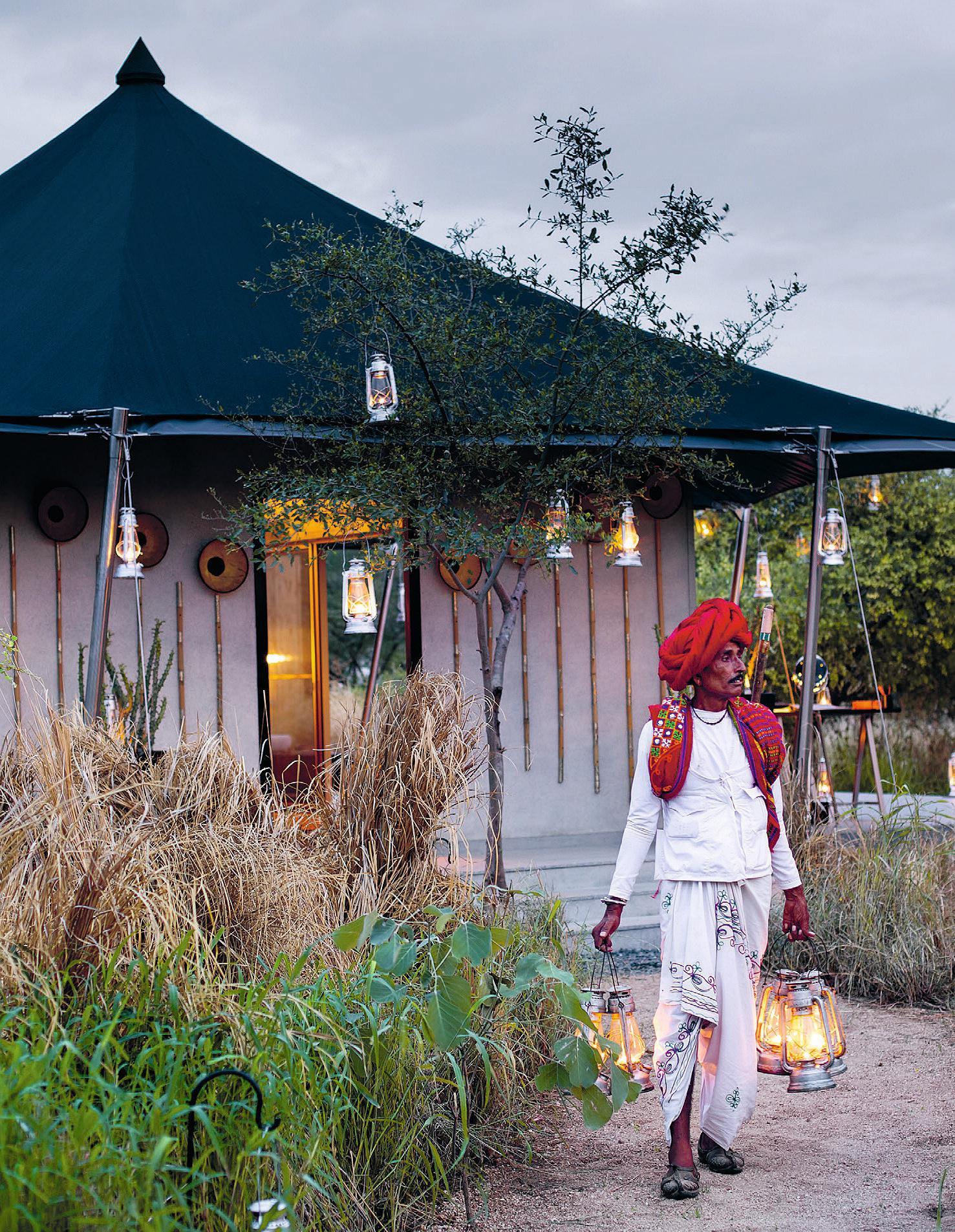
Set amid 130 acres/52 secluded hectares and built in the early 18th century, Chewton Glen is situated in exquisitely maintained gardens and woodlands in Hampshire, just minutes’ walk from the peaceful Solent coastline and the New Forest National Park. Guestrooms and suites are wonderfully serene, but guests looking to experience the ultimate hideaway should book one of the 14 Treehouse Suites. Built like floating pavilions in the treetop canopy, these sky-high lodgings benefit from floor to ceiling windows, wrap-around balconies, free-standing hot tubs, and views over the quiet woodland with the only disturbance being the sound of wild birdsong as you enjoy breakfast delivered by hamper to your very own Treehouse.
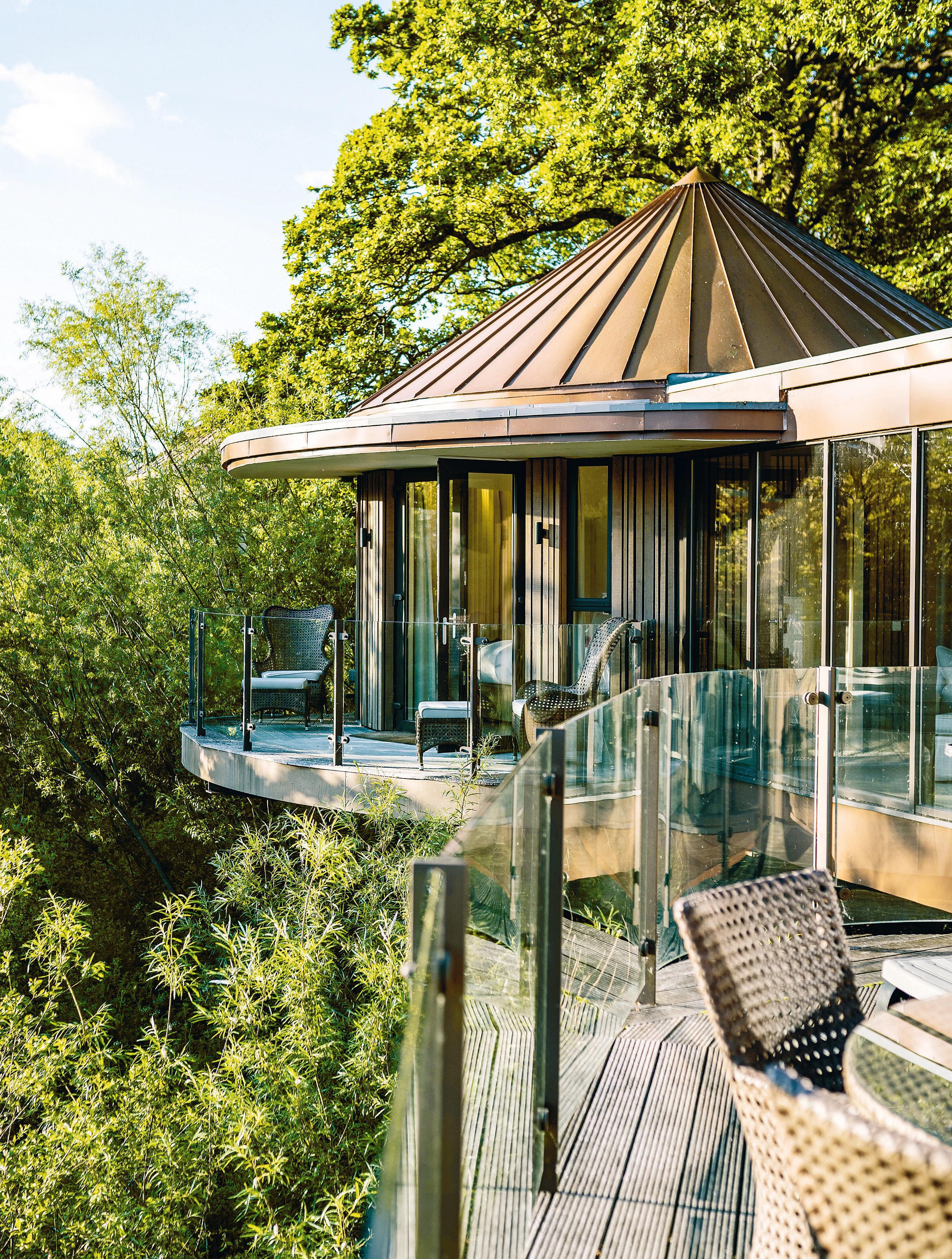 Chewton Glen
Chewton Glen




This original safari camp in existence since 1926, within the acclaimed Sabi Sand Game Reserve, includes three contrasting styles of lodgings, ranging from the leafy Tree Camp to the ultrasecluded Granite Camp, which all feature private plunge pools and sleek, contemporary design. Game drives at Londolozi are some of the most famous in the country, and Londolozi prides itself on its expert trackers’ and private guides’ ability to help guests discover the famed Big Five animals without disturbing their habitats. The property is also well known for its photographic safaris and wilderness wellness healing house. This familyowned and -run operation is socially benevolent and environmentally responsible: its mission is to create a world where wild animals and people coexist in harmony, and with dignity.
With just six tents in this most remote of camps, located on a 77,000-acre/ 31,000-hectare game reserve, the sense of solitude is palpable. While the distance from other humans may be unparalleled, don’t be mistaken that you’ll be alone. The Okavango Delta, where the camp is located, features an incredible mix of diverse natural environments and is home to thousands of animals including elephants, hippopotamuses, lions, cheetahs and leopards. This astounding parade of fauna is visible directly from your elevated tent, which overlooks sprawling floodplains. The camp can also provide private guides and a four-wheel drive vehicle to access this magical parcel of land. All that solitude is balanced by comforts including private swimming pools, indoor and outdoor showers, and environmentally friendly air conditioning units to keep you cool.

For an ultra-private glamping experience, head to this camp inside Kenya’s 35,000-acre/14,000-hectare Olare Motorogi Conservancy. Mara Nyika Camp consists of just five thoughtfully designed tents that feature copper bathtubs, private verandas and roughhewn wood floors. Guests are treated to some of the country’s best wildlife right outside their lodgings, with the growls of big cats echoing in the morning light–the reserve has the largest concentration of big cats in Africa–or herds of zebra galloping in the near distance. The conservancy has the lowest vehicle density in the Maasai Mara, making game drives feel wonderfully exclusive. Staying here also supports the local community: conservation fees help support over 1,000 Maasai families. Each guest has the opportunity to plant a tree in the reserve as part of the Conservation Roots Project.
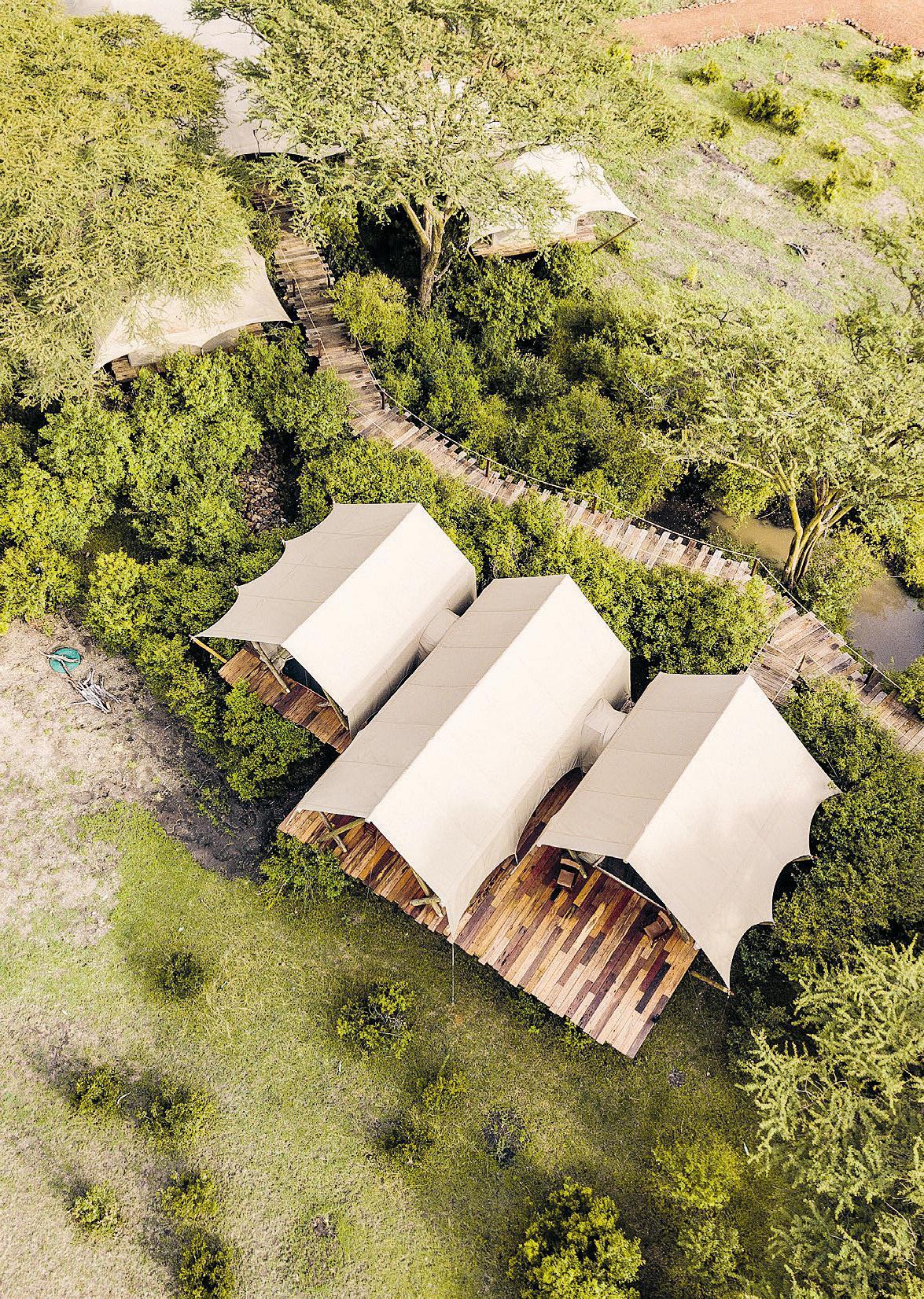
This restaurant and hotel in northern France is led by one of the country’s most innovative chefs, Alexandre Gauthier. While the main structure is over 300-years-old, architect Patrick Bouchain has thoughtfully combined tradition with avant-garde elements. The same can be said for Gauthier’s playful cuisine, where traditional and local ingredients are teased with creativity, both in preparation and flavor. For the most intimate experience, book one of eight garden huts for an overnight stay. Camouflaged in greenery, these cocoons are beautiful and comfortable, with raw materials expected to gain a pleasing patina over time. Deliberately built with televisions hidden under burlap cloths, guests are invited to slow down. “I’m talking to lovers, not businessmen, to disconnect them from their daily lives,” says chef Gauthier.

 La Grenouillère
La Grenouillère
Located in the heart of France’s Les Trois Vallées ski resort, La Bouitte is both a Michelin three-star restaurant and a five-star hotel. Its authentic representation of Savoyard culture has earned it recognition as an Entreprise du Patrimoine Vivant (a Living Heritage Company) by France’s Institut National des Métiers d’Art (National Institute of Crafts).
Text Christian Simenc – Photos Jérôme Galland



THIS IS THE STORY OF AN UNASSUMING RURAL EATERY that became an internationally revered haven of gastronomy. It’s also the story of two self-taught yet virtuoso chefs, René and Maxime Meilleur–a father and son who, over four decades, have formed an inimitable culinary partnership. The story begins in 1976 in the hamlet of Saint-Marcel, at the heart of France’s Savoie region, near the largest ski area in the world, Les Trois Vallées. At an altitude of 4,927 feet/1,502 meters, René Meilleur and his wife Marie-Louise opened a restaurant– “the chalet of their dreams” –where they served simple but generous fondues and raclette dishes. They called it La Bouitte, or ‘little house’ in the local Savoyard dialect, and a regular stream of happy patrons came and went. But one evening in 1981, the couple had a memorable dinner at Paul Bocuse, the eponymous, iconic gourmet restaurant in Collonges-au-Mont-d’Or, near Lyon, that would change their lives. It was a “shock to the taste buds” which sparked an idea. “After that meal, we realized we had to move towards more elaborate and creative dishes, while focusing closely on local produce–lamb from our local farmer, fish from the lake, herbs from the mountains, and so on,” says René. “Little by little, we took out the raclette machines, began serving more elegant dishes and took a brand new approach to our restaurant.”


In 1996, Maxime, who had had a successful career in the French junior biathlon (cross-country skiing and rifle shooting) team, joined his father in the kitchen, somewhat by chance. “I went inside one day to make some crème anglaise and never came out,” he says. A partnership was formed, and experience was shared. At La Bouitte, the family’s ties are strong: Marie-Louise runs the hotel and Delphine, Maxime’s wife, is maître d’hôtel . Maxime quickly learned
the ropes, channeling his athletic abilities of endurance and excellence into this new world. With his father’s guidance, he soon became an effective partner. “When we cook, we are two painters contributing to the same canvas,” says René. “Each one adds their own touch, and we finalize the work together.” The stars did not take long to shine. La Bouitte’s first Michelin star was awarded in 2003. The second came in 2008, before a third–the ultimate accolade–was awarded in 2015. “It’s as if my father and I had reached the top of the mountain, and could enjoy the breathtaking views before us,” says Maxime. “A new life began.” Behind the glass kitchen door, a team in white berets springs into motion, led by René and Maxime. Meilleur means ‘ best ’ in French, so there is no room for error. “There is a kind of authenticity and sincerity in this style of cooking that you just don’t find elsewhere,” says Maxime. “The difficulty is to enhance without distorting.”
Left: The two chefs at La Bouitte, René (left) and Maxime Meilleur.
Below: In the hotel lounge hangs an astonishing collection of bells produced in Chamonix.


Bottom: All staff wear interpretations of traditional Savoyard clothing, designed by Arpin, a well-known local spinning mill.
Right: Perch from lakes across Savoie, served with butter sauce, grilled fishbone jus, vegetables and marsh samphire.

Above: All hands on deck: lunchtime in the kitchen with the brigade of ‘Meilleur’ white berets.

Right: A detail of La Bouitte’s monumental architecture, which includes centuriesold wooden cladding recovered from old sheepfolds.

Ravioli with Reblochon cheese are plunged into onion stock and served with slivers of fried onion rings. Fillet of fera from Lake Geneva is draped in a thin sliver of crusty bread and served with a frothy white wine ( Roussette de Savoie ) butter sauce. One dish has been served at La Bouitte ever since it earned its first star: escalope of pan-fried duck foie gras balanced on a corn cake, infused with local Saint-Marcel honey and a reduction of matured vinegar.
At the end of the menu, an immaculate dessert. Named Lait dans tous ses états (milk in all its forms) it uses milk from sheep, cows and goats, presented in a variety of textures: powder, mousse, yogurt, butter, meringue, sorbet and jam. It couldn’t be more delicious or mouthwateringly nostalgic.
Members of the Meilleur kitchen team are never content with routine excellence, but always strive to come up with new ideas. Like tightrope walkers, René and Maxime can finely balance a Carte Blanche menu with three to eight surprise dishes, combining guest preferences, morning produce arrivals and any new sources of inspiration. Or, as they have been doing for a decade now during their famous wine-tasting evenings, they may create custom compositions that marry beautifully with the terroirs and styles of the wines they showcase. With more than a thousand entries, their cellar may be one of the most varied in the Alps, with vintages dating to 1937. At La Bouitte, any culinary journey inevitably ends by the fireside with something sweet, including cruche cake, based on a recipe by Gisèle, René’s mother. This is just one of myriad nostalgic taste memories the chef has been collecting, since 2018, with the mountain recipes organization ( Conservatoire des Recettes de Montagne ) that he chairs.

Over the years, La Bouitte has gradually unfolded into a wonderful maze of warm and welcoming spaces. The hotel and restaurant is a monumental building with sloping roofs and thick walls–an ode to the region’s traditional architectural heritage. Raw materials–stone or slate roof tiles, blue stone, larch framework and centuries-old timber from former sheepfolds–contribute to its serene atmosphere. Its 15 rooms, including seven suites, echo that mood, decorated in cozy textiles woven at a local spinning mill, while interior design throughout incorporates local folk art from the 17th- to the 19thcenturies. This runs from all types of furniture through to butter molds, portable stoups and ornate chests. A series of bells from prestigious manufacturers in Chamonix rubs shoulders with a collection of plates and pottery found in Haute-Savoie. One of the dining rooms has a splendid Baroque-style painted ceiling decorated with carved cherubs. Even the cheese trolley is a fantastic example of local artisanship. “I find it incredible that people have designed such beautiful things for everyday use,” says René Meilleur.
La Bouitte’s most adventurous guests shouldn’t miss the opportunity to meet in the reception area at 6:30am, in order to climb the nearby mountains in a tracked vehicle to an altitude of 8,800 feet/2,700 meters. There, before the sun comes up, they can admire the opposite view, just below the pink gleams of light known as the Belt of Venus, a thick, curved slate blue line: the shadow of the Earth projected on the atmosphere for just a few minutes. Finally, they can indulge in a delicious breakfast at the summit, savoring the sunrise over the Alps, including Mont Blanc, and descend on the most perfect virgin powder, before the ski lifts have even opened to the public.

LA BOUITTE IS AN ODE TO THE REGION’S CULTURAL HERITAGE.
Left: Blankets and throws woven at a Savoyard mill create a warm and cozy atmosphere.

Above right: In the foreground, the hamlet of Saint-Marcel.

Below: Local artisan heritage is also expressed through elegant tableware.

Right: A hearty welcome awaits–a generous serving of praline brioche.
Meet the Meilleur family, on video

“The late morning light in the restaurant room of La Bouitte is the most beautiful to photograph. The whole team is preparing the lunch service, meticulously, like a ceremony. It’s a treat to capture the details and precise gestures.”
HÔTEL-SPA LA BOUITTE – RESTAURANT RENÉ ET MAXIME MEILLEUR, Saint-Martin-de-Belleville, France


Art enthusiasts around the world are introducing new creative values to the world of hospitality, exhibiting private collections, setting up gallery spaces with professional partners, or inviting artists to display their work. These properties represent a new cultural approach designed to appeal to guests’ discriminating tastes.
Text Olivier Reneau
 Conversation, 2017. Stainless steel by Bert Flugelman © Adagp, Paris, 2022 at the entrance of the restaurant Laura at Pt. Leo Estate.
© RHIANNON TAYLOR
Conversation, 2017. Stainless steel by Bert Flugelman © Adagp, Paris, 2022 at the entrance of the restaurant Laura at Pt. Leo Estate.
© RHIANNON TAYLOR
About an hour’s drive from Melbourne, the long sandy beaches and welcoming wine estates of the Mornington Peninsula make it a popular destination for wine tourism. Pt. Leo Estate covers a 320-acre/130-hectare stretch of the area, on hilly countryside facing Philip Island to the south. As well as being home to a 50-acre/20-hectare vineyard, and renowned for the restaurant, Laura, run by chef Josep Espuga, the property maintains a sculpture park that feature 60 or so works by leading artists from Australia (such as Jane Valentine,
Left: Shrive II, 2008. Cast iron by Antony Gormley.

Right: Untitled, 1999. Stainless steel by Akio Makigawa.
Andrew Rogers, Michael Le Grand) and abroad (Ugo Rondinone, Erwin Wurm, Tony Cragg and Jaume Plensa, whose piece Laura is the namesake of the restaurant). Curation of the works, which are typically on an immense scale, is a job in itself. In fact, it is conducted by Geoffrey Edwards, who used to run the Geelong Gallery (in Geelong, Victoria) and now works as an independent curator. A sculpture trail meanders organically around the property, which was designed by the Jolson firm of architects, in a wandering dialogue with its creative forms.

Left: Pink, 2013. Steel sculpture with electrostatic painting by Aldo Chaparro. La curación de un ciego, 2011. Serigraphy by Jorge Cabieses.

Below: Artwork Untitled, 2009. Pencil on paper by Fernando de la Jara.
”An Arty Haven in Lima”


In Barranco, without a doubt the most beautiful district in the Peruvian capital of Lima, Hotel B retains the feel of a superb Belle-Époque mansion. Here, hospitality and artistic creation make a charming pair. The discreet reception area is a lounge richly furnished with period pieces, and embellished with several works of contemporary art. Gallerist Lucia de la Puente–whose exhibition space is next door to the hotel–and her sister Susana are among the hotel’s owners, and have made a large part of their collection available to guests: more than 300 pieces by Latin American artists including José Tola, Víctor Rodríguez, Miguel Aguirre, Carlos Runcie Tanaka, Aldo Chaparro and many others hang on the walls of the rooms and in common areas. The upstairs living room is like an abundant cabinet of curiosities, while the ground-floor library overflows with art books for guests to peruse. It’s almost like a museum, reserved for a privileged few.
Read the article ”South Africa: Art with Subject”

Morphous, 2014. Bronze with blue patina by Lionel Smit.


Die Dompas Moet Brand! (The Passbook Must Burn!), 2014. Bronze and copper shim by Hank Willis Thomas.
The Helshoogte pass winds through Cape Town’s vineyards, on the road from Stellenbosch to Franschhoek. The Delaire Graff Lodges & Spa estate is nestled at the heart of this spectacular natural environment. The juxtaposition of its precisely laid-out vineyards with the steep craggy mountains that lie beyond creates a landscape that could understandably be described as heavenly. Laurence Graff, owner of the estate, decided to take advantage of this setting to present his personal collection of works by leading South African artists. In the gardens, sculptures by Dylan Lewis, Anton Smit and Lionel Smit bring a naturalistic approach to the concept of statues. The reception and common areas are mainly home to pictorial works (including by William Kentridge, Ndikhumbule Ngqinamb, and Vladimir Tretchikoff, the original Chinese Girl ) but also sculptures (by Kendell Geers, Deborah Bell, Sydney Kumalo), to complete a panorama of South Africa’s art scene.
The Cazes family–owners of the prestigious red wine Château LynchBages, fifth Grand Cru Classé 1855 in the Pauillac appellation–originally established Château Cordeillan-Bages to accommodate their friends, partners and passers-by. Very quickly, it began taking on the character of the hotel as we know it today. Yet it has managed to retain the beautiful soul of a family home, which makes it utterly charming–not least courtesy of the many contemporary paintings that enliven the interior. In fact, Jean-Michel Cazes and his family
display the treasures of their personal collection for guests to enjoy, sharing his passions for art from the second half of the 20th century, notably the avant-garde CoBrA movement. The works, which include paintings by Pierre Alechinsky, Gérard Titus-Carmel, Jean Le Gac and Antoni Tàpies, are regularly hung in different locations around the venue. Since 1989, the Cazes family has also organized exhibitions in the Château Lynch-Bages cellars, in association with the renowned Galerie Lelong & Co. Their latest project featured the works of artist Jan Voss.
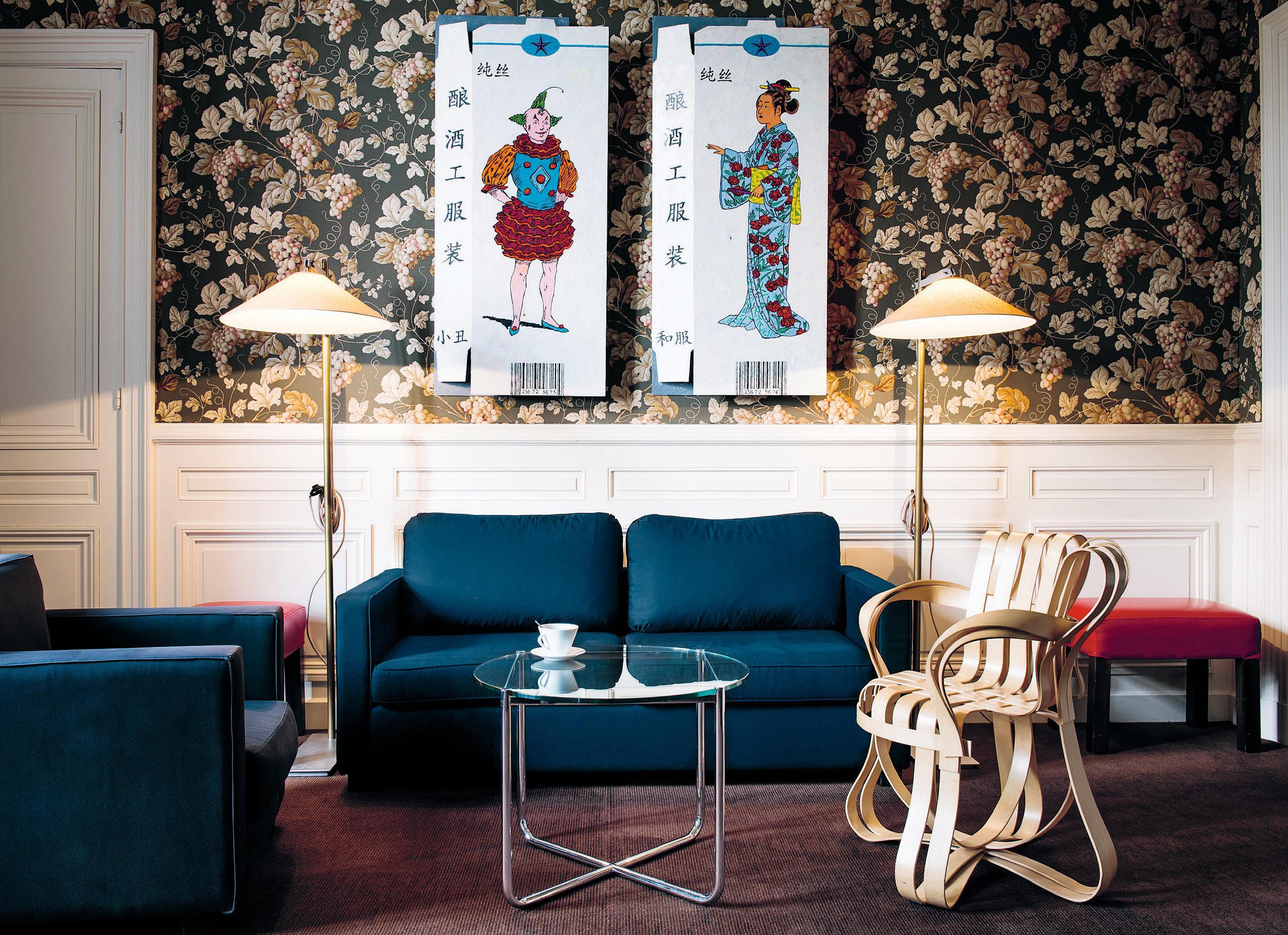

Hotel Union Øye draws on tradition, breathtaking nature and the contributions of an entire village to create an unrivalled homey feel. Here, the story of the local community and the hotel are beautifully intertwined.
Text Per Asbjørn Risnes — Photos Benni Valsson
 Hotel Union Øye is embedded in the local community–and the breathtaking scenery that surrounds it.
Hotel Union Øye is embedded in the local community–and the breathtaking scenery that surrounds it.
THIS IS A DISTINCTLY NORWEGIAN EXPERIENCE. There’s the fjord itself, of course: water-filled valleys carved from hard rock by rivers of ice. Then there are the mountains, with snow on their summits, and waterfalls plunging down their sides. And there are traditional wooden houses, cows, salmon jumping in the river, and unpredictable weather that ruffles your feathers.
Stepping into the Hotel Union Øye, the heritage of 19th-century travel combines with modern comfort and the hospitality of an egalitarian people that always welcomes visitors. As well as a crackling fire, you will feel the embrace of a bygone era as the concierge says: “This will be your best stay ever. The whole village will see to it.” For more than 100 years, the hotel has been fundamental to the community’s economic success.

Manager Mariann Øye considers all visitors her personal guests. No wonder, the hotel was once her family business–she still describes it as “more home than hotel ”. Some 30 years ago, her father, Johan, and his friends, Per Ola Ratvik and Idar Nordang bought the run-down but charming hotel from a Christian organization that had used it for summer camps. They wanted to restore the grand old hotel–which opened in 1891–and draw tourists back to the village, but struggled for decades. Then in 2008, Mariann, who had played in its corridors since she was three, took over as the youngest hotel manager in the country. One year later, when the Flakk family bought the hotel, Mariann came as part of the deal. The acquisition brought economic muscle to develop the hotel and meet the needs of modern guests.

Above: Manager Mariann Øye’s father and his friends founded the modern hotel, and her nine-year-old daughter Athina–already known affectionately as ‘vice CEO’–is looking forward to running it in the future.


Left: A writing desk used by Danish author Karen Blixen: the hotel has named one of its guest rooms after her.

“Together with the Flakk family we saved the hotel, the village, and hopefully the future of tourism in Norway,” says Mariann. The new owners have refurbished the hotel to impeccable standards and taken great pride in the details of the place, furnishing it with antiques, adding a conservatory and guest houses built in the traditional style. The Flakk family, wearing their hearts on their sleeves, have been especially invested in how the hotel can play together with the environment and the whole village. Lately new families have been moving in and settling, expanding the community further. “The hotel has its own soul, but the people who work here have their stories to tell. In a way, they all own the place,” she says “It is more important they know the names of the surrounding mountains than the wines in our cellar. But they need to enjoy performing on the stage that a historic hotel like this is.”
In early 1890, hotel pioneer Adolph Schieldrop, from nearby Alesund, cast his eyes over the hamlet of Øye, deep in the Norang fjord. The demand for accommodation close to the mountains was booming. So he bought two prefabricated houses, and put one up in Geiranger, and one 25 miles/ 40 kilometers away in Øye. He called them both Union hotel.
For decades Øye attracted wealthy travelers: royalty, salmon barons, mountaineers, painters and writers.
The German Kaiser Wilhelm traveled all over the coast in the summers between 1890 and 1908. One of his favorite spots was here in Øye. He left behind two things that still live on: a sincere tradition of taking care of guests, and the love story of Linda, a hotel maid who fell in love with one of the Kaiser’s handsome officers, Fillip. Their affair ended in tragedy after his family did not allow him to break his betrothal in Germany and he drowned himself at sea. A few weeks later Linda was found floating in the fjord. She had found peace–but not quite. Since then, she has been staying in room seven. “She’s a friendly ghost,” says Mariann. “She still wants to do the best for guests.”

The fog blurs the line between the tranquil water and the green hills that run along the Norang fjord. Sigrid Håndlykken carries an inflatable kayak from the boathouse to the beach. “This is the best weather to experience the fjord. No wind, no rain, no glaring sunshine,” she says, handing out life jackets to a couple from New York. “I need to make sure that you float, the water is rather chilling, although I noticed a few hotel guests walking up from the beach in bath robes earlier.” Sigrid was made for this, growing up with her family in Longyearbyen, on the arctic island of Svalbard. Now she works for the hotel as an activities guide, taking guests on bike tours, hiking and kayaking. She does not push them to do the most extreme sports, but takes pride in tailoring the experience to each guest’s pleasure. “ Just be sure to synchronize your paddles ,” Sigrid says.
Summer season hostess Ingrid Marie Myklebust Haaseth had promised a light hike through dense wooded hills–a quest to show us the view over the Norang fjord from a little shed, halfway up the Saksa mountain. If she was still wearing the hotel’s traditional uniform and riding boots, it would have given us a slight advantage. But today, she wears light hiking clothes and sturdy mountain
Left: Union Øye has been refurbished to offer guests every modern comfort alongside its rustic charms and traditions.


Below: Every corner comes packed with memories: many of the staff have long associations with the property stretching back to childhood.

boots, climbs like a goat and walks like this was her backyard. Which, in a way, it is: her grandmother and her great grandmother both worked at the hotel, which she visited from age five. “I still remember the spooky armor in the lobby, but also sitting in the garden with my cousin planning how we would celebrate our weddings here. Now we both work here in summers,” she says. After completing her studies at law school she plans to land a job in Alesund so she can continue to visit her beloved Øye. “Here you go. Quite a nice view, wouldn’t you say?” We step out of the wood and onto the landing in front of a little shed and confront the epic panorama now revealed. This magnificent nature is exactly what the Flakk family hoped to capitalize on when opening a new chapter in the hotel’s history. They wanted to merge the local heritage with modern hotel management, in order to produce accommodation that could compete at the highest international levels.
First, they modernized a former fish warehouse in Alesund into the Brosundet hotel, then built the Storfjord hotel, a few miles further into the fjord it was named after. Next their eyes fell upon a third venture–the Union Øye. “We have traveled a lot, and really appreciate personal service and relaxed luxury. We wanted to bring back all the details–and the spiritual qualities,” says Line Flakk.
“As a kid, I used to go with my travel agent father to visit Norwegian hotels. I judged them by the size of the swimming pool. At Union Øye, the lack of a pool was made up for by the beautiful fjord. I really enjoyed the 19th century interior, and the warm, informal attitude.”
Having made its fortune in biogas and hydrogen, the family is now engaged in climate-friendly projects. The hotel already has a zero-waste, zero-plastic policy. Next, they are venturing into zero-emissions tourism, planning to build hydrogen stations to fuel buses and ferries and providing two black electric Porsches for guests to use. Giving us the keys to one of these, the only warnings from the receptionist were to remember to disconnect the charger and to look out for sleeping sheep. We could choose from pre-installed destinations, for instance to explore the famous Trollstigen mountain road, the Geiranger fjord or the nearby Norang valley. We could also have done the trip on electric or manual bikes, like some of our fellow hotel guests, but the silent push of 400bhp on narrow village roads, in a car with a snow-white conscience, is a pure rush–especially when combined with the breathtaking valley draped in white fog. We return for a four-course meal made from locally sourced produce. The amusebouche is a variation on a traditional Norwegian everyday meal: originally a gratin with cod, macaroni and bechamel sauce with breadcrumbs on top. This little taster has smoked haddock, croutons, and some salmon caviar. “We have world class fish right out of the fjord,” Knut Edvard Kjersem says without modesty. “And now we have world class
locally farmed meat. The beef you had was a Dexter cow grass-fed across the fjord. ” The chef spent his formative years with French chef Alexis Gaulthier from Michelin-starred Gauthier Soho restaurant in London. Knut recently returned to Øye after a few years at the seafood restaurant Sjøbua in Alesund.

“We try to do a formal, but slightly lighter and modern, French style. This goes well with the heritage of kings and adventurers,” he says, adding that they have found a nice, fermented asparagus recipe from the old hotel cookbooks of 1913. “Fermenting was the only way to get asparagus up here all-year round.” Nowadays he can also call on fishmongers to reserve the best 44lbs/20kg of halibut out of the 1,100lbs/500kg being sent south, contact a local cheesemaker or strawberry grower–and there’s rhubarb picked just across the road from the hotel. “So, you enjoy books, huh?” a shady figure in the dimly lit library asks, continuing before I can answer: “I do too, I have a Kindle for hikes up in the mountains, but I love physical books, they are an endangered species.” Audun Haddal wears a backpack, a pair of glasses and a hotel uniform. “I’m the night porter and the hotel librarian,” he says. He runs his finger along a row of books, picking out a first edition of Henrik Ibsen. “Did you know he supposedly wrote his play Brand while staying here?” he asks, before leading us through shelves that cover mostly mountaineering literature, as well as titles by renowned authors and celebrities that have stayed here: Karen Blixen, Knut Hamsun, Sir Arthur Conan Doyle, and Edvard Grieg, to name a few. Our final encounter is with nine-year-old Athina. She does not have to come with her mother to work–she just really likes to. She even aims to take over her mother Mariann’s job as manager sooner or later. Probably sooner, you’d think, watching her tend to guests, serve coffee or tidy up, all while wearing a miniature version of the hotel’s traditional uniform. The employees call her ‘vice CEO’, or vetlesjefen in Norwegian. Last year, she even declared her ambitions on national television, when a TV crew visited the hotel: “I want to be hotel manager one day, and I want an ice rink in the garden!”

Visit Hotel Union Øye in Norway

Left: Chef Knut Edvard Kjersem enjoys access to fresh Norwegian produce, which he deploys in a lighter style of French cuisine.
Right: The definition of getting away from it all: the hotel’s sauna floats on the fjord.

Below: Overlooking the Norang fjord–the destination of a hosted hike guests can take up the Saksa mountain.

 © IL SAN PIETRO DI POSITANO
© IL SAN PIETRO DI POSITANO
Beyond its 580 hotels and restaurants worldwide, Relais & Châteaux offers a meticulously curated collection of 600 villas, spanning five continents, which blend the personalized service of a hotel with the space and seclusion of a private home.
 Text Jancee Dunn
Text Jancee Dunn
THERE
LONGER STAYS, confirmed by several travel advisors, as travelers eagerly make up for lost time. As people seek to reconnect with friends and family, the demand for private vacation homes is higher than ever. Also driving demand is the working from home trend–over 60 percent of employees work remotely at least occasionally now, according to recent studies. It’s little surprise that a new kind of getaway has evolved from the confluence of these trends: long-term, private stays for large groups of family or friends.
For these travelers, a hotel room is not sufficient, but nor does a random rental quite deliver what they crave. While some hotel brands have responded by expanding into the short-term rental market to offer private villas and homes, the Relais & Châteaux collection adheres to the association’s renowned values. A high standard of excellence is a given. Its collection of standalone villas, each with their own entrances, facilities such as kitchens and private gardens–and many with their own pools or other services–have already been subjected to a rigorous selection criteria. Any villa in the collection is guaranteed to be breathtaking. As they are directly connected to the existing properties, they are assured of being an instant immersion into an authentic sense of place, reflecting local architecture, history and heritage–anchored in their environments. Often, they are completely enveloped by lush outdoor spaces, from unspoiled wilderness to meticulously cared-for gardens, for a restorative dose of nature. Add in the opportunity to access housekeeping services, personal chefs, sommeliers and the property’s wine cellar, concierges and cultural excursions whenever you want and the choice of a private vacation home no longer means sacrificing that feeling of being looked after.
The collection encompasses every possible kind of stay–countryside or seaside, desert or mountain. Rather
than a quick trip, these properties offer more of a lifestyle reset–allowing a seamless transition between work, leisure, and family time.
“When it grew evident that travelers were combining work, leisure and family time in novel ways , the property sprang into action,” says Laura McIver, from Rancho Valencia in Rancho Santa Fe, California. “Even before the pandemic, we noticed that multigenerational travel was really picking up. People wanted an environment where they could have their own kitchen, their own bedrooms and their own pool.” Rancho Valencia has chosen to focus on private amenities for the villas. No more worries of not getting enough space for everyone. Some of the private homes on offer have their own golf carts or their own fitness rooms, with Cybex equipment, Peloton bikes, TRX and free weights.
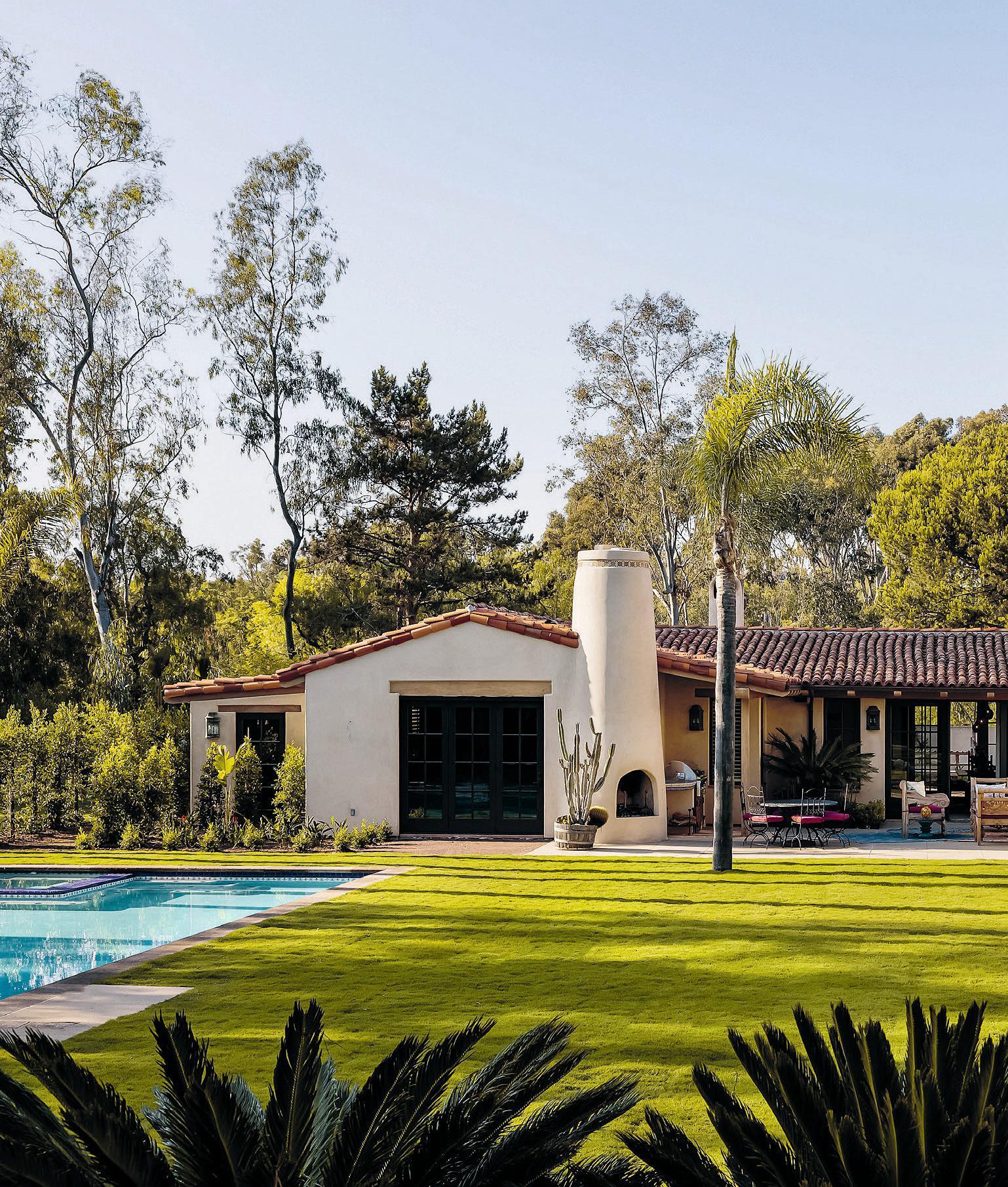



Il San Pietro di Positano’s villa, Palazzo Santa Croce, is a 17th-century baroque palace, perched on a steep hillside with breathtaking view over the bay of Positano. “Our guests expect high standards,” says the hotel’s general manager Andrea Zana. “One key difference between Villas by Relais & Châteaux and other rental villas is that the staff operating in the villa comes from the hotel, and have hotel training whose touch is evident. When potential guests read that the villa is managed by Il San Pietro, expectations are very high, but all the standards required by Relais & Châteaux are guaranteed.”




The needs of different generations, from old to young, are easily met in a private villa, according to Karien Bendle, manager at Ellerman House in Cape Town, South Africa. “At 15 miles/25 kilometers from Cape Town’s airport, our villas are ideal for business travelers, with spacious working desks, ultra-modern architecture and spectacular views. Guests that need to work may do so, under favorable conditions, while the rest of the family enjoys Cape Town,” she says. “For the kids in the group, there are long days by the pool, and enough room for them to be entertained.” At day’s end, the whole group can gather for meals prepared in the villas’ fully-equipped kitchens by a private chef, served on the suspended pool deck.


Séverine Bestenheider-Reynaud, owner of the Hostellerie du Pas de l’Ours in Crans-Montana, Switzerland, points out that “nowadays, people can work from any place as long as they can be reached. They need space, separated rooms and good internet connection.”

As a bonus, she says, “our unique villa reflects the mountain architecture, the ideal ambience to be productive and relax at the same time. This Chalet Villa is perfect for lively and cosy moments by the fireplace.” “People get a home-away-fromhome with the luxury of being taken care of. They can work, spend time with the family and friends, and they don’t have to worry about a thing.”
Very often, villas feature special amenities of their own. “Our seven Country Style Chalets are nestled around a natural pond. Each between 1,600 and 2,000 square feet/150 and 185 square meters of living space and 7,500 square feet/700 square meters ground has a private spa and a living room fireplace,” says Susanne Gräfin von Moltke, co-owner with her husband Klaus of Gut Steinbach Hotel Chalets Spa in Reit im Winkl, Germany. Anchored in nature, the property has a strong sustainability philosophy in the awardwinning cuisine guests can enjoy even when staying in the villas. 80 percent of the food used is coming from a maximum of 50 miles/80 kilometers away.
 GUT STEINBACH HOTEL CHALETS SPA, Reit im Winkl, Germany
© MARTÍN GARDELLIANO / TOBIAS HERTLE
GUT STEINBACH HOTEL CHALETS SPA, Reit im Winkl, Germany
© MARTÍN GARDELLIANO / TOBIAS HERTLE
“Travelers appreciate the services that hotels do best. Because while all Relais & Châteaux villas offer privacy, guests are close enough to the hotels to access any of the facilities and services,” says Nouredine Fardad, General Manager of Château de Berne in Flayosc, France. “They can use everything our hotel provides,” he says. “They want to feel like the hotel belongs to them.” The Château de Berne team is available 24/7 to assist, from organizing a spa day to a wine experience in the heart of a 432-acre/175-hectare vineyard. Many villas can also arrange babysitting, butlers, or meals from the hotel’s Michelin-starred restaurants.


Four chefs share their philosophies towards cuisine and reveal how their creativity has been shaped by their backgrounds, surroundings and relationships.
 Text Olivier Reneau
Text Olivier Reneau
Childhood
“This is me rolling dumplings–‘madeleines de Proust’–with my aunt. My family comes from Ghana as well as the Swabian part of Germany. Dumplings are eaten everywhere in both places.”

RESTAURANT SCHOTE, Essen, Germany

ORIGINALLY FROM GHANA, BUT HAVING GROWN UP IN GERMANY, CHEF NELSON MÜLLER FUSES THE CUISINE OF RESTAURANT SCHOTE, IN ESSEN, GERMANY, WITH THE DIFFERENT CULINARY CULTURES HE HAS ENCOUNTERED.


Farm-to-table “Behind all of my dishes is the principle of good quality food. That means I choose local products from suppliers I trust and ingredients that represent the best of the season. I have also started growing my own vegetables.”
Melting pot
“My dishes always have a classic background with a modern twist–it could be French, German, African or Mediterranean influences. That multicultural approach characterizes everything I prepare.”
Ambient
“I’m inspired by nature, industrial culture, art and sustainability. My restaurant is made with durable materials like wood, marble and brass. We have a living wall, like a small forest; it contrasts with high ceilings with visible pipework. I work with a nearby gallery so you will also find large paintings–at the moment by artist David Uessem.”

CHEF VICKY LAU AT THE HELM OF HER RESTAURANT, TATE DINING ROOM IN HONG KONG, CHEF VICKY LAU, NAMED BEST FEMALE CHEF IN ASIA BY THE ASIA 50 BEST RESTAURANTS IN 2015, MIXES EASTERN AND WESTERN CULINARY AND CULTURAL INFLUENCES.


“During my studies in applied arts, I worked with ceramics a lot. It was my favorite studio where I spent a lot of time. I gave it up because I didn’t really see how I could make a living from it. However, I retained a great sensitivity to the material.”

 TATE DINING ROOM & BAR, Hong Kong
TATE DINING ROOM & BAR, Hong Kong

“My passion for ceramics led me to study its history, especially the Song dynasty, which is very important for this creative practice. It was also during this period that tofu was invented in China. It’s all connected!”

“My daughter, who is 5 years old, is a huge inspiration to me. She loves natural foods and has a very honest taste. She allows me to find the right balance between respect for the raw product and the creative culinary act.”

“All my cooking is guided by umami–the fifth taste after sweetness, sourness, saltiness and bitterness. Seaweed, which brings this flavor, interests me a lot–there are so many varieties, and while it is quite common in Asia, it is still relatively unknown in the west.”

“This is my birthplace, where my roots are, even though I spent a long time living in the United States. Hong Kong is the perfect place to do business. It is a city rich in contrasts, from pure tradition to hyper-modernity.”

Produce “Quality is at the heart of what we do. Through close relationships with our suppliers, we have learned that every step in the supply chain is important to ensure the finest quality. It starts with the nutrition of the soil–being respectful of the environment.”


“We are fortunate to have got to know our suppliers really well. Besides reducing the distance between farms and consumers, this allows us to have timely information about harvests, what’s available and the quantity, so we can adapt our menu to the seasons as best as possible.”






“Something I really like about restaurants is that it’s not just about food. If you want to give the best possible experience you have to take care of hundreds of details: the architecture, the interior design, the tableware, the music, the aromas of the place and many more. I enjoy these aspects because I like to be aware of local artists doing amazing things that we can bring into our projects.”
CHEF ENRIQUE OLVERA INTERNATIONALLY ACCLAIMED CHEF ENRIQUE OLVERA IS ONE OF THE FIGUREHEADS OF ‘NEW MEXICAN CUISINE’. HE DRAWS ON THE FORMIDABLE CULINARY HERITAGE OF HIS COUNTRY TO CREATE A DISTINCT GASTRONOMIC IDENTITY FOR HIS RESTAURANT IN MEXICO CITY.
Everything on point “I think this is the common denominator of everything that inspires me. Las cosas bien hechas, as we say in Spanish–doing everything as best we can. This philosophy is crucial and has guided our work for many years already. It covers everything from our work inside the restaurant, to our relationships with suppliers, and other, less visible aspects, like our impact on the environment and energy consumption.”

“This notion is very much linked to my family and my childhood. The table has always been considered as a place of meeting and exchange around food. For me, it is a great joy to welcome my guests and creating moments to share a feeling of conviviality around the table.”

“Observing nature is a great source of inspiration. We are researching the origins of life in our region with an archaeologist/ anthropologist and an ethnobotanist. Wild plants help us understand the interactions in our local ecosystem. Permaculture and biodynamics are great for raising awareness of living things.”

CHEF MAURO COLAGRECO HAS MADE MIRAZUR A MICHELIN THREE-STAR RESTAURANT, AND IT WAS ALSO NAMED NO. 1 IN THE WORLD’S 50 BEST RESTAURANTS IN 2019. IT IS A MODEL OF SUSTAINABLE DINING, BOTH IN TERMS OF THE LOCAL CUISINE IT SERVES AND ITS SOCIAL COMMITMENTS.

“We are always looking to strengthen social ties by investing in local products and producers, such as artisanal fishing. We strive for local self-sufficiency, to ensure our resiliency in the future.”




“Every day should contribute to building awareness around the need to change our lifestyles. That is why I decided to work with the Plastic-Free Certification start-up. Encouraging our teams and our community, through concrete projects, allows us to spread awareness about biodiversity and to protect our environments.”
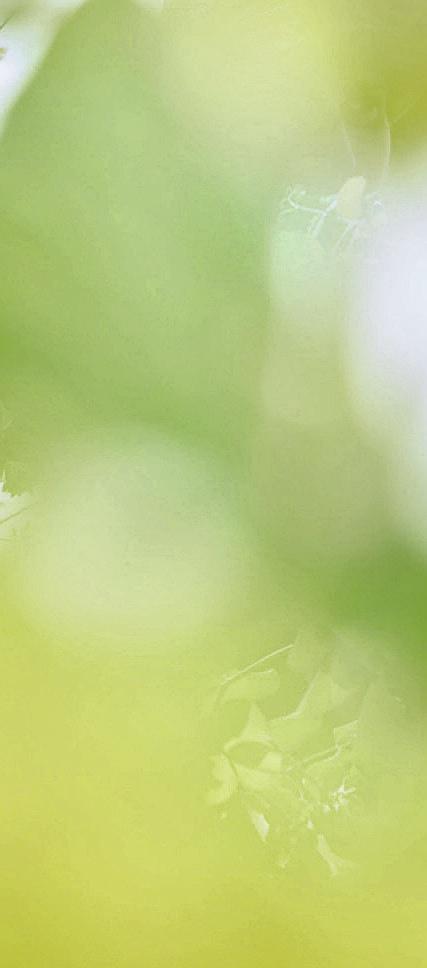
“Traveling is fundamental to my personal and professional enrichment. Meeting other people feeds my open-mindedness and helps me break down borders. I think that accepting differences challenges us, and drives us to become our best selves.”
The clear, warm waters of the Adriatic coast; an epic variety of natural landscapes; a rich cultural history that dates back to the cradle of civilization; and a wonderfully unhurried lifestyle: Croatia has it all. Best of all, this beautiful and unspoiled country still feels relatively undiscovered.
 Text Jonathan Bousfield – Photos SofijaSilvia
Text Jonathan Bousfield – Photos SofijaSilvia
Pine-scented views towards the crystal-clear Adriatic coast, as seen from the estate of Villa Korta Katarina.



 LEŠIĆ DIMITRI PALACE, Korčula, Croatia
LEŠIĆ DIMITRI PALACE, Korčula, Croatia
Above: A relaxing courtyard at the Lešić Dimitri Palace: modern furnishings juxtapose against ancient natural materials.

Left: Bougainvillea in bloom: fragrant flowers create an ever-colorful and changing background.

Far left: Town of mellow stone–a lifestyle in balance with nature.
Croatia’s Dalmatian coast offers both solitude and sociability, and an awesome sense of nature’s power to rejuvenate and inspire. With lush subtropical vegetation giving way to stark limestone wilderness, and with beaches that range from intimate pebbly coves to parasol-covered shores, Dalmatia’s natural beauty is never static. Shifting light turns the sea from blue to green to turquoise. Whispering breezes awaken scents of carob, wild fennel, rosemary and thyme. Pastel greens of olive bushes alternate with the deeper hues of vineyards, cypresses and pines. Wall-hugging cacti sprout vivacious flowers, only to wither and fall after a day or two’s bloom. Yet the seductive appeal of Dalmatia does not just rest solely on its natural beauty. It is also a region of rich cultural heritage, its history shaped by Greeks, Romans, Byzantines and Venetians, as well as the Slav tribes who subsequently coalesced into the Croatian nation.
Spread along Dalmatia’s shores are towns and villages of mellow stone, their gardens sprouting purple spears of bougainvillea, blushing pink oleanders and shimmying palms. Hillsides are streaked with dry-stone walls, the products of centuries of back-breaking toil, when local farmers cleared rocks from the barren scrub to create life-sustaining patches of sheep pasture, olive grove or vineyard. It is often on the islands and peninsulas that Dalmatia’s famously recuperative powers are at their most concentrated: it is here the sea is at its clearest, the serenade of crickets at its strongest, the scent of wild herbs at its most intoxicating, and the pace of life at its most measured. Central to the Dalmatian lifestyle is the idea that life’s pleasures are not to be hurried: from the first coffee of the morning to that final, soul-soothing glass of prošek dessert wine in the evening, the good things in life should be savored, never rushed. Embracing contemporary comforts while showing deep respect for Dalmatian tradition is the Lešić Dimitri Palace in Korčula, the ancient walled town that occupies the eastern tip of the island of the same name. A seventeenth-century aristocratic seat right in the heart of town, this venerable stone building has been artfully transformed into one of Croatia’s leading boutique hotels. Its interiors exude a spirit of globe-trotting adventure, with luxuriant fabrics and furnishings evoking the textures and colors of Venice, Southern Asia and the Far East–as befits a town that was once the home of Marco Polo. Despite the provision of state-of-the-art bathrooms and kitchenettes, the hotel has remained faithful to its heritage, retaining its exposed stonework, odd-shaped nooks and low-ceilinged passageways.
The hotel lies right on one of Korčula’s stepped medieval alleys: a haven of repose set in the midst of a vibrant and historic community. With its castellated turrets and flamboyant cathedral, Korčula is indeed an outstanding museum piece, but it is also full of the contrasts of contemporary life. This is a town where street cats bask outside chic fashion boutiques, children sell seashells on Renaissance piazzas, and local choirs give impromptu performances of traditional, a cappella songs. Further proof of the enduring balance between tradition and innovation comes in the shape of Lešić Dimitri’s restaurant, LD, where the fresh catch hauled in by fishermen from the nearby island of Korčula is transformed with mercurial skill into a unique Adriatic culinary experience. LD’s creations are at their enchanting best when paired with Korčula’s wines: Pošip , the refreshing aromatic white from the inland village of Čara; or Grk , a varietal which only thrives in the sandy-soiled village of Lumbarda and was first cultivated by the ancient Greeks.
Offering a bold architectural statement, one that also blends seamlessly into the local landscape, is a luxury hotel on the island of Hvar. Maslina Resort seeks to be at one with its surroundings. An unapologetically geometric piece of modern design, its outer cladding of wooden slats echoes the slender tree-trunks of the surrounding woodland. While a name already well known to Mediterranean travelers, Hvar remains surprisingly wild, a grey-green ridge of an island with tufts of fragrant lavender lending a purple hue to its stony upper slopes. Swathed in pines and tamarisks, the resort and its cluster of rooms, suites, and villas sit above Maslina Bay, a sheltered spot where locals come to swim, stroll or cycle. With an interior that features local limestone, wood and terracotta floor tiles, there’s an earthiness about the design that keys directly into the elemental beauty of the island landscape. It’s the perfect place to unwind and recharge: spa and fitness facilities emerge from behind intimate walled gardens, and a beach of silky sand lies a mere five minutes along the coastal path. Commitment to the environment is a crucial plank of the resort’s philosophy, and sustainability is more than just a fashionable phrase. Maslina is plastic free, and committed to recycling. Food is seasonal and locally sourced: the resort’s head chef can frequently be seen emerging from Maslina’s organic garden clutching an armful of fresh herbs and vegetables. The hotel is an active player in the Croatian community: local creatives were engaged in designing furnishings and staff uniforms, and local sports teams in nearby Stari Grad were provided with sponsorship.
Top
Above: Sleepy villages nestled in countryside or amid vineyards are a typical part of Hvar’s island landscape.

Right: Mindfulness and relaxation in natural surroundings: a core part of the attraction of Maslina Resort.

 VILLA KORTA KATARINA & WINERY, Orebić, Croatia
VILLA KORTA KATARINA & WINERY, Orebić, Croatia
While offering a soothing air of self-contained seclusion, the resort is within easy distance of Stari Grad, especially if you glide along the coastal path on one of its innovative wooden-framed bicycles. Founded by the ancient Greeks in the 4th century BC, Stari Grad is a town that welcomes visitors but retains its own timeless rhythms, its warren of ancient alleys opening out suddenly into vibrant piazzas filled with potted plants and playing children. The eternal Mediterranean, with its symbiosis of human civilization and natural order, is here in all its power.
Many of the most compelling destinations start out as a personal dream, and Villa Korta Katarina is a prime example. Americans Lee and Penny Anderson discovered southern Dalmatia’s rugged, heart-stopping Pelješac peninsula after taking part in humanitarian missions in nearby Bosnia-Herzegovina. Falling in love with the area, and inspired by its reputation as the source of Croatia’s most highly prized wines, they purchased a stunning art-deco former hotel, and decided to transform it into a winery and luxury residence. It’s an extraordinarily handsome building, rising majestically above the sea. Inside, everything communicates comfort and refinement, the Andersons’ passion for hospitality expressed through discreet but attentive service, rich textiles, and the kind of chairs and sofas that invite deep and thorough relaxation. It’s in the owners’ keenly felt enthusiasm for wine that Korta Katarina’s relationship with the Dalmatian landscape is truly expressed. Cloaked in vineyards, and sitting atop a barrel-filled cellar that has become a laboratory of oenological excellence, the villa has quickly become one of the most prestigious wineries in the country. Key to Pelješac’s wine-producing potential is Plavac mali, the endemic grape variety cultivated tenaciously on the steep slopes of Pelješac’s southern shore. It is the combination of dry stony soil, intense sunshine and salty sea air that produces fruit uniquely rich in flavor. The sweat and toil of the local harvesters, who require agility and stamina to pick their way along the precipitous upper slopes, are additional ingredients in this famously luxuriant, velvety red. Korta Katarina has also enjoyed great success with its dry white Pošip , made from grapes grown on Korčula, and a charming rosé deftly crafted from local reds and whites. Stretching west of Villa Korta Katarina are the glorious sand-and-shingle beaches of Orebić, an underexploited riviera that exudes an easygoing, relaxed charm. Orebić itself is celebrated for the palatial villas built by nineteenth-century ship captains, their walled gardens bursting with oleanders, cacti and palms–a place of calm and meditation that epitomizes the understated luxury of the Dalmatian south.
 SOFIJASILVIA Photographer
SOFIJASILVIA Photographer
“I was born in Pula, in the north of Croatia–and still live there. Driving south gave me the opportunity to rediscover the diversity of the Croatian coast. I was moved by its heritage and richly preserved biodiversity, and was inspired to record it and contribute to its preservation.”

Top left: Terraced gardens at Villa Korta Katarina.
Above: With a soothing palette of pale blue, grey, white and cream, Villa Korta Katarina’s rooms and suites décor is a reflection of the fascinating Pelješac Peninsula.


Left: The stunning pool terrace at Villa Korta Katarina.


While blessed with a culinary culture that celebrates fish, seafood and seaweed, chefs in the land of the rising sun are increasingly concerned about the future viability of beloved oceanic staples and ancient coastal communities. Three chefs from Relais & Châteaux share their vision for a sustainable future.
Text Alena Eckelmann – Photos Nathalie Cantacuzino
A dish at Kashiwaya composed of seabream and tsubasu (young yellowtail) with tofu, wasabi, red sprout from Tade and oba (shiso leaf).

in the Japanese diet for millennia–there is archaeological evidence for this dating back to the fourth century. Undoubtedly this reflects the nation’s 400 inhabited islands and 18,600 miles/30,000 kilometers of coast. Each year the Japanese eat over 50 lbs/23kg of fish and seafood and up to 20 lbs/9kg of seaweed per person: marine products are eaten year-round at home; at izakaya, Japan’s casual eating and drinking outlets; and as part of kaiseki, the country’s most refined cuisine. So embedded are ocean products in Japanese culture they are also offered at Shinto shrines to Japanese deities. But in recent years marine resources have come under threat from global warming, over-fishing and over-harvesting, sparking concerns about future food stocks, and the fate of both Japanese culinary tradition and ancient coastal communities. In turn, this has prompted discussion around how chefs can calm these troubled waters, spreading knowledge about how people can positively impact the health of the ocean. In 2019 our Japanese chefs pledged to work with their Korean counterparts to promote sustainable fishing. They have also publicly committed to uphold ‘Life below Water’, one of the United Nations’ 17 Sustainable Development Goals.

life-and-
Hideaki Matsuo is a keen observer of the oceanic environment and has seen how many coastal areas in Japan have suffered not just from a decrease in seaweed, but often its total disappearance. This is known as isoyake, or sea ‘desertification’. It is partly a direct effect of global warming but is also caused by expanding populations of seaweed-eating fish and sea urchins. “The harvest of wild kelp in southern Hokkaido where I obtain ma kombu has declined sharply,” he says. “In 2021, no wild kelp was harvested at all and the catch was recorded as zero.” This is a problem because Chef Matsuo uses wild ma kombu to make dashi (soup stock) and kelp rolls. He also uses hidaka kombu, another high-quality kelp, in all
dishes except dashi. And while he sources seaweed such as mozuku and nori direct from fisheries, for kelp he must continue to use specialist wholesalers. “Distribution of ma kombu is traditionally very unique and different from the rest of seaweed because it is seen as precious and highly valuable,” he says. He tries to procure two-year-old kelp as it is considered to be of premium quality, whereas one-year-old kelp is regarded as second-class. Twoyear-old kelp dies once before the summer of its first year, but the kelp that grows from its remaining shoots then becomes the bigger and tastier two-year-old kelp. “In recent years, the remaining shoots from first-year kelp have been unable to withstand summer water temperatures and have died out,” he says. As a result, the price of two-year-old kelp has soared, which has helped producers’ incomes, but not halted the overall decline in their number. “There seems no way out. The type and quality of kelp in each region is unique, and local producers depend on it for their livelihoods, so the decline in resources is a direct life-and-death issue for them. I’m currently seeking a way to make dashi without using kelp, while I pay close attention not to waste any kelp in my cooking.”

“In my teens, I traveled to Tokyo alone and gradually fell in love with Japanese culture, including its food. Talking to the chefs, I got an insight into their food philosophy and their perception of the seasons and its ingredients.”

Left: “We want our small actions to have a big impact. The depletion of marine resources is something we must tackle head on.”
– Chef Matsuo.
Right: An arrangement of appetizers all containing seaweed.

Below: In his restaurant, Chef Matsuo uses lesser-known fish such as rockfish, black scabbardfish, or a variety called kasago in Japanese.


Left: Rosy seabass and snow crab with chrysanthemum flower, taro, yuzu and wild sansho.
Right: Wakame and firefly squid sasanishiki risotto.
Below: “As a chef I can connect people’s consciousness and invite them to embrace ocean revitalization.”
– Chef Namae, speaking at the UN’s World Oceans Day event in New York, June 2022.

In addition to its role as an ingredient, seaweed is recognized for absorbing atmospheric carbon and for having the potential to regulate global warming. But scientific findings have already proved a link between higher sea temperatures and negative effects on the survival, growth and re-production of seaweed. Warmer waters also enable predators of seaweed, for example sea urchin, to be active even during winter–a crucial time for Pacific seaweed to mature. Chef Shinobu Namae wanted to observe what was happening with his own eyes and to settle the contradictory opinions
he heard about the state of the ocean.
“Every time I go to a fishing village I hear about a lot of change in the ocean compared to decades before,” he says.
“Are we over-harvesting or are we facing the environmental effects of changing temperatures?”
His solution? Training to become a free diver and setting out to the seabed to investigate for himself. What he immediately witnessed was a devastating decline of seaweed.
Since then he has strived to spread the word about the damage caused, including speaking at the United Nations for World Oceans Day, in June 2022, and the opportunities to reverse the damage–which he has, happily, also witnessed in some communities.
A seaweed educational workshop for children in a coastal community is typical of how he seeks to engage people with the issues. A morning dive is followed by a lecture from a biologist, then a talk with a fisher, before the group gathers to eat his seaweed-themed dishes.
“Through this event we were able to provide the children with a physical and an intellectual connection with the otherwise unseen beautiful seaweed forest in the ocean,” says Chef Namae. “This experience, backed up by evidence, helped instill a sense of wonder about the coastal water world in the children.
“With my cooking, I hope to spark people’s awareness and start the discussion about its importance over delicious dishes containing seaweed.The revitalization of seaweed forests and global warming just cannot be considered separately.”


“Ten or fifteen years ago, chefs used to create menus simply with our guests in mind. Now, just considering the menu is not enough: we have to consider preserving the environment.”
These days, Chef Shinichiro Takagi cannot always get the ingredients he wants. He needs abalone for his restaurant’s signature dish but sometimes it is not on sale in the market because it has not grown enough. That’s just one example–there are many others. The cause? Global warming has altered the timing of when the seasons change and, in turn, when and how oceanic biodiversity reacts, prospers or declines. “The species of seafood we can enjoy in different seasons is changing bit by bit, but over time it is noticeable,” he says. “As a chef, I have to recognize these changes and adapt my cooking and presentation.”
Thinking of the menu in relation to the seasons means trips to the market, to fisheries and distributors are not just about sourcing fish and seafood but staying up to date with what is going on in the ocean. He then passes the news on to guests sitting at the counter of his restaurant. “To learn about the environment by eating good food is fun, and the memory of this experience is much stronger than any social media post,” he says. Most of his guests, for example, do not know that abalone feeds on seaweed, so when seaweed forests diminish, so do the species that depend on them. To maintain abalone stocks, modern means of harvesting them have been outlawed in favour of preserving the old ways. “Our area is well-known for abalone, and it is why guests come to Zeniya,” he says. “Abalone eats seaweed and fresh seaweed grows in spring. In our region we have a regulation that only ama-san (diving women) can collect wild abalone. The local government does not allow scuba divers with oxygen tanks to harvest abalone. This has been in place for more than 50 years.” Being so responsive to the ocean, adapting to what is available, and retaining the human touch to preserve biodiversity on the seafloor all helps ensure the future prospects of traditional communities known as satoumi, literally ‘village and ocean’, where people co-exist with the sea. The hope is they can continue to thrive for centuries to come.
he is based.
Left: “I want my menu to be good not just for the stomach but also for the mind.” – Chef Takagi.

Learn more about ocean health
TO

Left: Chef Tagaki filters freshly made dashi with sheets of kombu and katsuobushi (bonito)




Below: The final preparations of Zeniya’s signature dish.
Bottom left: Abalone steak dashi sauce with Wakame seaweed and ginger.
ZENIYA, Kanazawa-shi, Japan
LEARN ABOUT THE ENVIRONMENT BY EATING IS FUN, AND THE MEMORY OF THIS IS STRONGER THAN ANY SOCIAL MEDIA POST.
A trip to Hawaii rewards the commitment of traveling to this isolated archipelago with a destination abounding in natural wonders. Maui, its second-largest island, offers an unrivaled mélange of landscapes, ecosystems and climates.
 Text Sabine Bouvet – Photos Taja Košir Popovič
Text Sabine Bouvet – Photos Taja Košir Popovič
 Lush, green vegetation surrounds Hotel Wailea in Maui.
Lush, green vegetation surrounds Hotel Wailea in Maui.
AT DAWN, WHEN THE PACIFIC IS STILL WARM FROM ITS SULTRY HAWAIIAN NIGHT, YOU DIVE, PLUNGING INTO THE WELCOMING WAVES . Underwater, you are suddenly surrounded by ancient sounds rising from the depths: the unmistakable song of whales. Here, in Makena, on Maui, they’re so close, just a few hundred yards off the coast. You flip on to your back, head halfsubmerged, to let yourself be lulled by this oceanic melody: a powerful sound bath that the finest retreats and infinite meditations can never equal. This miracle returns every year as the whales come to Maui’s hospitable seas to deliver their young, spend winter swimming with their calves by their sides, before returning to Alaska in the spring. Surrounded by the ocean and quenched by rainfall, Maui is a vast expanse of life. Home to 10 of our planet’s 14 different climates—an incredibly rare characteristic—it’s an island world where some of the driest places on the planet rub shoulders with some of the wettest. In the Hawaiian language the word wai means ‘water’, or ‘life force’, and there are more than 200 words for rain. There is also language to describe how it falls, the noise it makes, its color, intensity, smell, and the effect it has on people.
As global warming becomes a key concern, rain is an increasingly precious source of life. In Maui, there is a water supply like no other: Pu’u Kukui Watershed Preserve–the largest private nature reserve in Hawaii. Pu’u Kukui, the hill of enlightenment, is sacred to elders and the eight rangers who protect the drainage basin. In the past, only chiefs and priests had right of entry. Today, when its guardians take up duty, they offer a prayer in Hawaiian. Because even though it generally rains five times more here than in the Amazon, and even though this immense and impenetrable sponge spanning 9,880 acres/4,000 hectares is forbidden to the public and a haven of biodiversity, it cannot escape the consequences of global warming: in 2020, precipitation was measured at 200 inches/5 meters, barely half the


Left: With her Petals with a Purpose project, Beth Elliott redistributes and recycles hundreds of pounds of flowers from weddings held in Maui.
Below: Through agroforestry and with The Maliko Project, Eddy Garcia has brought the North Shore’s sacred, fertile valley of Maliko Gulch back to life.

typical level. From an altitude of 5,788 feet/1,764 meters, Pu’u Kukui supplies water to one third of the island, including most hotels and resorts on the west coast of Maui. For Hotel Wailea, water conservation is an important issue, not least because it is located in a semi-arid zone, at the gateway to a lava desert. Given the uniqueness of this island, travel takes on a more meaningful dimension: visitors tend to reflect profoundly on their connection to nature. Visitors to Maui are witness to a hundred different ecosystems, at once powerful

yet fragile. It holds a sense of mystery, too. Large sections of the island–deepset valleys, waterlogged mountains, thundering waterfalls–remain inaccessible to humans and fascinating to scientists. With contemplation comes the desire to protect this nourishing land. And you can take action: four prominent local figures invite travelers to become agents of change and sustainability. First, meet Eddy Garcia, a charismatic, uncategorizable character. He is a trailblazing surfer of Pe’ahi, also known as ‘Jaws’ (the surf break off Maui’s
“Maui is my second home–my brother lives there. An ocean lover and advocate of the environment, he introduced me to these inspiring characters who take action.”

A HUNDRED DIFFERENT ECOSYSTEMS. WITH CONTEMPLATION COMES THE DESIRE TO PROTECT THIS LAND.

Left: A heavenly terrace in the lush grounds of Hotel Wailea.
Above: Krista Garcia sources herbs from the Hotel Wailea’s garden.


Right: Fresh, linecaught red snapper served with banana flower, limu (seaweed) and dressed with lilikoi (passion fruit) sauce.
northern shores, renowned for some of the world’s biggest waves); the creator of a solution to transform polystyrene from surfboards into compost using worms that feed on it; and friend and advisor to Yvon Chouinard, founder of the Patagonia brand. Eddy has restored Maliko Gulch ( maliko means ‘to bloom’ in Hawaiian), a formerly fertile valley that had become a landfill, and cleared the waste-clogged river of abandoned cars and wrecked planes so it could flow naturally once again. Today, he hosts farm-to-table dinners there under the stars, along with workshops on recycling, compost, agriculture and more, in a galaxy of inspiring initiatives.

Another man with a mission: Campbell Farrell and his Love the Sea foundation. His goal is to rid the coast of the plastic (from commercial fishing) that ends up there. Supported by an army of volunteers, he organizes cleanup days. Fishing nets, buoys, and other flotsam and jetsam are collected on the beaches or pulled off stretches of coastline accessible only by sea. Local community members and tourists join forces in these commando operations. Then there’s Beth Elliott, who collects hundreds
of pounds of flowers from weddings for Petals with a Purpose. For Maui is one of the world’s leading wedding destinations and therefore home to tremendous plant waste. Beth converts the fleeting life expectancy of these beautiful products into a more lasting futures by dismantling oversized decorations and redistributing flowers to hospitals and senior living facilities. Back at the Hotel Wailea, the talented Krista Garcia is the creative force behind extraordinary dinners. This Californian culinary creator is a true connoisseur when it comes to working with the island’s ingredients, growing her own vegetables at home in Haiku, on the northern coast. A tailor-made, tête-à-tête meal sees her julienne banana flowers, finely chop ginger blossoms, sprinkle her dish with limu (seaweed) and finger lime pearls, or whip up a lilikoi (passion fruit) sauce. Her cooking is a declaration of love to the land of Hawaii.
Five estates: five family stories. Respect for tradition balanced by a contemporary outlook. From within the Relais & Châteaux family, from all corners of the world, we present five hoteliers and restaurateurs eager to pass their passions on to the next generation.
Text Sabine Bouvet

If you were an ingredient or a local plant...
I would be edelweiss. I am a mountain man, that’s where I’m happiest!
If you were a part of the hotel...
I’d be Jägerstube (the Hunter’s Tavern)–it’s our oldest restaurant and where we serve traditional dishes.

If Post Lech Arlberg was a person… She would be a warm and welcoming grandmother who takes care of her guests. Share a memory…

I grew up at the hotel. There was always a big party on New Year’s Eve. When
I was five or six years old, I dressed up as a chimney sweep and hid inside a giant cake. I burst out and gave a rose to all the women there.
When did you start working there?
I had my first experiences in the kitchen at age ten when I used to make cookies. When did you decide to take over?
I have a brother and a sister; I am the youngest. My brother had originally decided to take over the business, and was getting ready for it, but he changed his mind and became a winegrower. I was surprised but happy. I already knew I wanted to work in hospitality. It took me ten years to develop Post Lech, and for it to become the hotel I had always aspired to create.
What values have been passed on to you?
My grandparents taught me there is no perfect situation and that you must deal with whatever comes your way. Never envy others. My parents taught me that if you want a project to be successful, you must put your heart and soul into it.

What object reminds you of your ancestors?
The ibex trophy in the entrance hall. In the 1960s, my grandfather reintroduced this species, even though it had disappeared from our mountains. As its population flourished, he was then the first to be allowed to hunt it again in the 1980s. He always strived to protect the fauna and flora in the valley.
What are today’s challenges?
Globalization is the biggest challenge. People come here from many different countries and cultures, and they often know little about the mountains. It’s up to us to provide them with a real experience. Which of your two daughters will take over from you?
Violeta, the youngest, will be going to L’École Hôtelière de Lausanne, the prestigious hospitality school, just like me.
How do you express your Breton roots?
I love salted butter, the ocean, and I have a nice collection of striped sailors’ jerseys! If you were a part of the hotel…
The ceiling structure above the dining room, which is in the shape of an upturned boat hull. It is bathed in natural light. It is the heart of the house.
If the manor was a person...
It would be Mamina, my grandmother. She turned her private home into a hotel. She must be proud that her son has taken over from her, and that the tradition lives on. Share a memory…
Our games of hide and seek as children, spending winters at the hotel when it was closed to guests, the furniture covered with white sheets, stormy weather outside, creaking beams and a roaring fire in the grate. The manor was our playground.

When did you start working there?
Our parents needed me and my sister Marilou to make up the rooms, wash the dishes and work at reception. That’s what we did for our summer jobs.
When did you start working there full time?
It was a smooth transition. I didn’t intend to take over the hotel. My sister decided to pursue a career as a photographer in New York. I worked in the cosmetics industry in Paris for eight years. My parents began

easing off a little and I wanted to give it a try. I did one season which lasted eight months. But that wasn’t enough to get an idea of how huge the responsibility was. I kept going for a second season and finally quit my other job in May 2014.
What values have been passed on to you?
My grandparents instilled in me a love of fine food, the art of living and good manners. My parents passed on the love of family and work: how important it is to love what you do to find fulfillment. We were never forced to take over the business.


What are your main values?
Human values: kindness, humility, tolerance. We are a small organization in which everyone does their bit. Our maître d’hôtel has been here for twenty years. We are one big family.
What are today’s challenges?
To retain our personalized welcome–it’s a family home, not just a hotel. And to focus on eco-responsible hotel practices, through decisions on sustainability and seasonality in the kitchen.
KAZUNARI NAKAMICHI IS THE OWNER OF BENIYA MUKAYU IN JAPAN. THE RYOKAN (TRADITIONAL JAPANESE INN) HAS BEEN IN HIS FAMILY SINCE 1928, AND HE RUNS IT WITH HIS WIFE, SACHIKO, ASSISTED BY THEIR SONS DAISUKE AND KOSUKE.


If you were a season…
Sachiko: I would like to be spring-when the tender buds and young shoots appear. The seeds have been patiently waiting under the snow. Every year, I am amazed by this magic.
Which part of your hotel reminds you of your ancestors?
Kazunari: The 300-year-old sacred red pine tree in our garden: it is part of our family. When did you decide to take over the ryokan?
Kazunari: My grandparents dreamed of creating their own ryokan, and they opened it in 1928. My grandmother often told me that one day I would be the third generation. In Japan, many family businesses are passed down from generation to generation. What do you want to pass on to the next generation?
Kazunari and Sachiko: Our name Mukayu means ‘richness in emptiness’, a concept rooted in Zen Buddhism which we want to pass on: here, guests can escape the routine of their daily lives, relax, cleanse and rejuvenate their bodies and minds. A stay at Beniya Mukayu is an empty space in a busy schedule book, it is a time filled with freedom precisely because it is empty…
Tell us about your commitment to the environment.
Sachiko: It is crucial that we protect biodiversity. For many years now we have been keeping a record of the flora that grows around the property. We have also designed a Moss Map–more than 30 varieties grow here. We provide these catalogs to guests so they can identify plants they see. If they know more about nature, they are more likely to respect and protect it. Who will take over the ryokan?
Our sons, Daisuke, the eldest, who is accounting and store manager, and Kosuke, the youngest, who is food and beverage manager. They will be the fourth generation. Describe the hospitality of tomorrow.
Sachiko: The Japanese aesthetic is deeply rooted in nature. Looking at Shintoism and Zen Buddhism, one can see that traditionally the Japanese believed that people should live in harmony with nature, not dominate it. We value preserving this heritage, and we want Japanese culture to be accessible to everybody in a modern and international way, thus enriching all our guests’ lives.
Above: Kazunari and Sachiko with their children Daisuke and Kosuke, pictured when they were younger, though now, respectively, the property’s accounting manager and food and beverage manager.


ADELE GARBUTT – DIRECTOR OF CALABASH LUXURY BOUTIQUE HOTEL ON THE ISLAND OF GRENADA IN THE CARIBBEAN. THE VENUE HAS BEEN FAMILY-OWNED SINCE 1987.

In what way do you represent the Caribbean?
People from the Caribbean are very authentic, naturally friendly, relaxed and charming. They are enjoyable to be around.
If you were a part of the hotel…
It would be the Beach Club restaurant. It is a calming place filled with light, fresh air and the gentle sound of the waves.
Share a memory…

Growing up in a hotel is such fun. When we were little, my sisters and I invited all our friends for afternoon tea. And now my daughters do the same.
When did you start working there?
I started helping from the age of 16. Then I worked at the front desk, on reservations. When I was about 25, in 2013, I took up my current position.
What values have been passed on to you?
Hard work. And to love what I do. I wouldn’t do anything else.
Who will take over?
Right now, my sister Beth and I run the hotel with my parents. Later I can see my daughter Isabella taking over. She is only five years old now–we’ll see. Tell us about your commitment to sustainable agriculture.

We have a rainwater collector, and we use solar energy. My sister Bobbie runs the organic farm (100 acres/40 hectares) that has been on our mother’s side of the family since the 1940s. Working on this fertile volcanic land in a respectful way–agroforestry–is one of the pillars of our hospitality vision. We produce coconuts and we are the second biggest nutmeg exporter on the island. The fruit and vegetables we serve at the hotel come either from our farm or from local certified organic producers.
I would like to see the entire hotel industry become more responsible for its impact on the environment. We respect seasonality. When guests complain that they don’t have avocados on their plate here even though they can find them easily in New York or London, we explain that they are not in season on the island. We don’t serve what we don’t grow. A third of all carbon emissions come from global agriculture. If we could halve that impact, it would be a step in the right direction.
If you were a dish or an ingredient... Pepitoria (stew) from my childhood brings back memories of my mother in the kitchen. I grew up in the kitchen.
If you were a season… I would be fall, for the variety and richness of its produce, especially mushrooms.
If Coque was a person…
It would be someone who enjoys discovering new flavors, while maintaining their mastery over those of the past.
At what age did you start helping your parents?
Even when I was only four or five years old my father would take me to the offal market in La Cebada, or I would go to the vegetable garden to pick a red cabbage or potatoes.

A memory…
I see cooking as an expression of life. That vision took shape when I was very young, in the kitchen with my parents. I remember the sound of the mortar, the scent of saffron and bay leaf, the smell of the wood stove. All these things helped cooking become my passion.
What is the secret to working successfully as a family?
Mutual respect and love. My brothers and I complement each other.

Top left: (left to right) Juan Diego, Rafael and Mario Sandoval.

What qualities have been passed on to you?
The importance of sacrifice and giving value to traditions without being afraid of going in new directions. Respect and a taste for a job well done. What do you cook for your children?
I like to have breakfast with them and oversee one of the most important meals in their day. As soon as we can get away, we go to Finca de El Jaral (the family farm) and I cook rice in the open air for my family, adding vegetables from the edible garden. How does it feel to be a Spanish chef today?
Spanish gastronomy has changed how the world eats. It calls upon people’s memories and senses. I am proud to be a Spanish chef. Tell us about your commitment to responsible cooking and agriculture. We strive to be involved in the circular economy as much as possible, and to reduce waste. We are educating our teams, distributors and guests and doing our best to raise awareness.
Challenges for today and the future… Innovation in gastronomy. Taking care of my employees and suppliers. Helping our society to eat healthily.
At Baumanière Hôtel & Spa, founded 70 years ago by owner Jean-André Charial’s grandparents, the chef Glenn Viel expresses his creativity in streamlined, minimalist dishes with powerful, persistent tastes. He is a new ‘friend’ of prestigious watchmaker Blancpain: both share an attachment to craftsmanship, a devotion to quality, an appreciation for terroir and respect for tradition.
Text Eugenio Mailler – Photos Olivier Metzger
 Glenn Viel’s dishes feature contemporary styling and intense flavors.
Glenn Viel’s dishes feature contemporary styling and intense flavors.
THE ALPILLES MOUNTAIN RANGE IS MAGICAL: a combination of the stark beauty of southern France, the stone of its hillsides and buildings, the scent of the scrubland and the dramatically tree trunks twisted by the mistral winds. Only the traveler’s admiring eye can soften this harsh landscape. And yet this setting makes you feel alive, hungry for a new experience.
In this enchanted land, and more precisely here at the foot of Les Bauxde-Provence, in Val d’Enfer—a foreboding name inspired by the shape of the hillsides—Baumanière Hôtel & Spa was established following World War II. With it, a new form of hospitality was born, far from the bustle of cities and major thoroughfares. Baumanière is the same age as Jean-André Charial, owner and maître de maison . In fact, his grandfather founded this property, and he now proudly carries the torch forward in time.
Jean-André’s experience has taught him that success is often found where innovation merges beautifully with tradition. With that in mind, he entrusted
the kitchen to a young chef, Glenn Viel, in 2015. Over the years, the chef and the maître de maison have progressively become in sync. Each is able to stimulate the other creatively, encouraging one another upwards, culminating in 2020 when Glenn became the youngest Michelin three-star chef in France.

“Innovation is our tradition” is also one of the fundamental guidelines of Blancpain, master watchmaker since 1735. It is no coincidence that Glenn is a new “friend” of the prestigious brand.
It is easy to draw a parallel between haute horlogerie and haute cuisine . Both share an attachment to excellence in craftsmanship, a devotion to first-rate ingredients and materials, an appreciation for terroir, the passage of time, and for traditions passed down the generations. These treasured principles firmly unite Glenn Viel and Blancpain. Close-knit and complementary, Glenn and Jean-André are now launching into new endeavors that showcase craftsmanship. Three workshops—bakery, pottery and chocolate-making—are set to open on the estate, in addition to further

Left: Jean-André Charial (left), owner of Baumanière, with Glenn Viel, chef of the Michelin three-star restaurant since 2015.

Top: Restaurant L’Oustau de Baumanière is located in a 17th century farmhouse in one of France’s most beautiful villages.
 Visit Baumanière Hôtel & Spa in France
Visit Baumanière Hôtel & Spa in France

developments in the kitchen garden that supplies vegetables and inspiration to Glenn’s cuisine.
Following the chef into the vegetable patch, we discover a less obvious side of his personality. He shows a passion and curiosity for communing with nature. He expresses the need for time to learn about, and understand, the pace of that life–the rhythm of plants. He is well aware that a kitchen garden marches to its own drumbeat, with a growth that appears random because it depends on thousands of factors; and that harvest time can only come at the precise moment when the vegetables are ready to give the best of themselves.
The green pea, grown on the estate for 50 years, is the signature vegetable of L’Oustau. The progeny of the right soil, showered with attention and gathered just at the right time, thanks to five daily inspections through the rows—as is the tradition in the “nobly-rotted” grapevines of Sauternes—this green pea is a gourmet treat. Glenn prepares it raw, simply seasoned with a dash of olive oil and mint. It shares a plate with Schrenckii caviar. This symbolic dish emphasizes the natural essence of contemporary gourmet cookery: the exceptional product and the product of exception.
During our two days with Glenn, we are impressed by how he manages time, and how he adapts so well to each moment of the day. Contemplative in the garden; attentive to his team, for whom the third star is a source of profound satisfaction; quick and agile when serving time comes; friendly when encountering guests; ready to embark on an adventure such as judging the television show Top Chef; and eager to defend any free time that remains. Beyond the kitchen garden, Glenn’s commitment to sustainability is equally clear, from the two pigs raised on the estate for home-grown meat, to the wheat grown here that will be used to make bread for the restaurant, the beehives and the care taken to avoid waste and reuse scraps. But you really grasp the depth of that commitment when he goes into the time that it takes to set it all up, to learn the other professions he has
introduced. Though his cuisine is intense, immediate and energetic, the chef understands that other times require a change of pace: one that lasts the longterm, the full duration. He might just have picked up a taste for that from being around Jean-André. We’ll conclude with another innovation. This year, for the first time in the history of the house, L’Oustau will remain closed two days a week, even in the high season. The loss of earnings for the establishment will be significant, and a few customers will surely be disappointed, but it is a fair acknowledgment of the needs of the chef’s brigade, and particularly their need to balance professional time with their personal lives. It is an admirable approach to the future of the profession and to development that is sustainable, even in social terms. After all, great innovations often lead to traditions, as we mentioned earlier...
Left: Abundant artichokes from the kitchen garden to the plate.
Below: Small ‘Tendresse’ artichokes, prepared with watercress and black garlic – the dish features in the restaurant’s Springtime vegetable menu.

 AWASI IGUAZU, Puerto Iguazu, Argentina
AWASI IGUAZU, Puerto Iguazu, Argentina
Welcome to an incomparable association: 580 exceptional properties, run by passionate, generous and dedicated independent hoteliers and restaurateurs, across 65 countries and five continents. The collection includes 500 hotel-restaurants and 80 standalone restaurants–comprising the world’s largest network of chefs, with 340 Michelin stars between them–as well as 600 villas.

The 2023 Relais & Châteaux Trophies are presented with partners who share our values and pride in recognizing expertise across a range of fields. They honor achievements from gastronomy to well-being and environmental responsibility, celebrating all those who embody passion for their profession and who inspire others in their discipline.




Highlighting the talents of a new generation of chefs who enchant diners with their creativity, Relais & Châteaux and S. Pellegrino award this year’s Rising Chef Trophy to Saygin Sesli, chef at Museum Hotel in Cappadocia, Turkey.

Leveraging his solid knowledge of Anatolian cuisine, Saygin enhances ancestral Turkish recipes with his unique touch. His commitment to cuisine becomes even clearer when you visit the organic farm he is passionately working to expand despite the region’s arid climate.

Relais & Châteaux and Hennessy are delighted to award the Delicious Career Trophy to Christine Monteil. As manager of the Château de Berne hotel since 2000, she embodies the archetype of the attentive host, attuned to the preferences, habits and needs of her guests, who travel to Château de Berne not only for the exceptional setting, but also for Christine’s warm welcome. The past 22 years have proven her loyalty and strong commitment to her teams and Relais & Châteaux itself.


CASTEL FRAGSBURG, Italy
The 2023 Well-being Trophy, recognizing the savoir-faire of a spa expert and the excellent care they provide for guests, goes to Renate De Mario Gamper, presented by Relais & Châteaux and Orlane. This modern-day alchemist works at Castel Fragsburg in Italy to create and prepare all of the flower- and herb-based beauty elixirs used at Castellum Natura, the first ever alchemistic healing spa. Renate is eager to hand down her knowledge to the spa team, and also offers expert advice to Chef Egon Heiss on how to use medicinal plants within his culinary creations.


Relais & Châteaux, Absolut Elyx and Monkey 47 are delighted to present the Cocktail Trophy to Lukas Gary Andersen. His Strawberry & Honey Punch cocktail takes its inspiration from the Lammefjorden region, located just a few minutes from Dragsholm Slot in Denmark. The sandy soil there produces the best strawberries in the country as well as sweet apples and delicate honey. Combined with Absolut Elyx vodka and a splash of lemon, these local ingredients make for a remarkable and refreshing mixological creation.

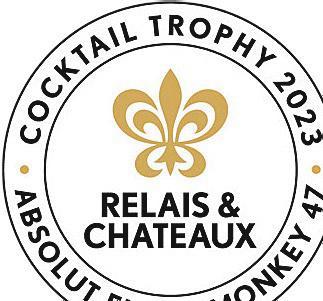
TRIPLE CREEK RANCH, United States
Convinced that unfailing expertise has the power to transform a hotel stay into an unforgettable experience, Relais & Châteaux and Glenmorangie are pleased to award the Savoir-Faire Trophy to Katherine Benitez, Housekeeping Manager at Triple Creek Ranch. Adored by her employees, Katherine has an eye for detail and knows how to create a warm, friendly work environment and bring out the best in every member of her team.





South Africa
Relais and Châteaux and Duval-Leroy award the sustainability trophy to Christopher Goodman and his team. Each with a degree in permaculture, they put their passions to work in conceiving a ‘Conservation Development Model’ for Londolozi Game Reserve in South Africa. Collectively they oversee a futuristic African village, with 39 vegetable gardens, a solar farm, a cuttingedge water treatment plant and a host of new systems for living in sympathy with the planet. They truly embody a modern approach to environmental responsibility.

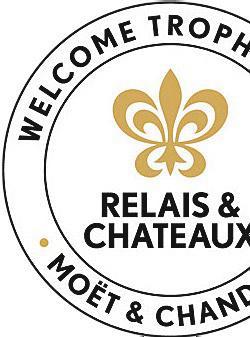
GINEVRA
Driven by the desire to make every moment unique, Relais & Châteaux and Moët & Chandon are pleased to award the 2023 Welcome Trophy to Ginevra Borghi, Front Office Manager at Gallia Palace Beach Golf & Spa Resort in Tuscany, Italy. Her sense of hospitality and her commitment to the values of Relais & Châteaux are unrivaled, as is the care she takes to make every experience an unforgettable moment for guests.


As promoters of committed, ethical cuisine, Relais & Châteaux and Taittinger are pleased to award the 2023 Ethical Cuisine Trophy to Andreas Krolik, chef of the two Michelin-starred Restaurant Lafleur in Germany. A true pioneer when it comes to environmental consciousness, Krolik has incorporated seven entirely vegan dishes, made mostly of regional products, into his menu. His approach to gastronomy is always framed by current environmental and social concerns.



 CHRISTOPHER
© GALLIA PALACE BEACH
© RESTAURANT LAFLEUR
© AMANDA RITCHIE
CHRISTOPHER
© GALLIA PALACE BEACH
© RESTAURANT LAFLEUR
© AMANDA RITCHIE


For her engagement and devotion to others, Relais & Châteaux and Pommery are pleased to award the Woman of the Year Trophy to Aggie Maseko Banda. As Lodge Manager and Partner at Royal Chundu–Luxury Zambezi Lodges in Zambia, Aggie has provided unfailing support for the local community via a wide range of projects. She is also committed to sharing Zambian culture with guests. In 2020, she received We Are Africa’s Shape Africa prize for her initiatives. She has also spent the last two years doing online courses about Zambia for Google, Facebook and Netflix.



In recognition of his commitment to handing down his expertise and knowledge, Relais & Châteaux and Blancpain award the 2023 Heritage Trophy to Tom Coward at Gravetye Manor. This garden is a critical chapter in the history of gardens, and Tom is entirely responsible for the vision and scope of its restoration, underway since 2010. Recognized by national press and his peers as one of the best head gardeners in the United Kingdom, he is regularly invited to speak at conferences in Europe and the United States.


The Relais de Campagne is born: eight properties located between Paris and Nice unite under the slogan ‘La Route du Bonheur’–The Road to Happiness. They would write the first chapter in the history of the association, on the theme ‘Art de Vivre’–The Art of Living.
Relais de Campagne expands outside France with its first European properties.
1974
Relais de Campagne merges with ChâteauxHôtels to become Relais & Châteaux. That same year, the association created Relais Gourmands to highlight gastronomy within its properties.
Relais & Châteaux welcomes its first properties in the USA, Canada and Japan.
Relais & Châteaux is present in 40 countries.
Relais & Châteaux presents its manifesto with 20 commitments to the United Nations, pledging to preserve the world’s cuisines, share its passion for beauty and taste and promote a more humane world.
Relais & Châteaux celebrates its 60th anniversary at Restaurant Georges Blanc with more than 60 chefs.
The association’s 580 properties reopen after the pandemic.
all driven by the same passion, comprise the Relais & Châteaux global landscape. “ The hotelier, the restaurant owner, must let his heart express itself ,” recommended Marcel Tilloy, our first president, 60 years ago. Today, this phrase is still just as relevant.
Europe 66% Americas 21% Asia 8% Africa 3% Oceania 2%
Our employees share the values of Relais & Châteaux, occupying 1,500 different positions, from catering to reception, room/floor service, management and many others. They work together with passion, expertise and a common desire to act for a better world through food and hospitality.
Creators of emotion and artisans of flavor, our chefs are the ultimate manifestation of our commitment to good taste, driving our choice of products, respect for biodiversity and the seasons, and our collaborations with local producers. Through their talent, we are proud to count a great many Michelin-starred restaurants in our network.
Our ‘Routes du Bonheur’ are a distinct part of the Relais & Châteaux identity–a celebration of the nature and gastronomic and cultural pride in each area. These 146 itineraries are all opportunities to take to the road in the name of adventure, of exploration and discovery, linked by our beautiful properties.
Relais & Châteaux offers a meticulously-curated collection of 600 villas, spanning five continents, which blend the personalized service of a hotel with the space and seclusion of a private home. Personal hideaway, hospitality included.
These singular places inspire calm and serenity, where you can soak up the tranquil power of nature to reset and recharge. Pampered by attentive staff, guests discover the delight of a stay where everything has been designed to soothe mind, body and soul.
The accommodations in our unique properties reflect the character and local culture of the community in which they are each embedded.
More than a brand, Relais & Châteaux represents a profound philosophy: to create a better world through cuisine and hospitality
INDEX
BOTSWANA
Duba Plains Camp Okavango Delta
Great Plains Selinda Selinda Reserve
KENYA
Great Plains Mara
Maasai Mara
ol Donyo Lodge Chyulu Hills - Amboseli
MADAGASCAR
Anjajavy le Lodge Ankaranakatra
MAURITIUS
20 Degrés Sud Boutique-hôtel Pointe aux Canonniers
MOROCCO
Château Roslane
El Hajeb (Region of Meknès)
Heure Bleue Palais Essaouira
Hôtel Le Doge Casablanca

Palais Ronsard Marrakech
Riad Fès Fès
Tikida Golf Palace Agadir
Villa des Orangers Marrakech
NAMIBIA
Epako Safari Lodge & Spa Omaruru
REUNION
Blue Margouillat Seaview Hotel Saint-Leu
SEYCHELLES
Château de Feuilles Praslin Island
SOUTH AFRICA
Delaire Graff Lodges & Spa Stellenbosch
Ellerman House Cape Town
Esiweni Luxury Safari Lodge Ladysmith
Jabulani Hoedspruit
Londolozi Game Reserve Kruger National Park
Morukuru Family De Hoop De Hoop Nature Reserve
Zanzibar White Sand Luxury Villas & Spa Zanzibar
ZAMBIA
Royal Chundu – Luxury Zambezi Lodges Livingstone
ZIMBABWE
Tembo Plains Camp Mana Pools Region
HotelRestaurantSpaVilla
Discover our properties in Africa & Indian Ocean



































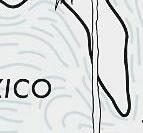




























Aramburu Buenos Aires
Awasi Iguazú Puerto Iguazú
Cavas Wine Lodge Lujan de Cuyo (Mendoza) Chila Buenos Aires
El Colibri Santa Catalina (Córdoba)
EOLO - Patagonia’s Spirit El Calafate, Santa Cruz House of Jasmines Salta
La Bamba de Areco San Antonio de Areco Las Balsas Villa La Angostura
Saint Andrews Gramado Gramado Txai Resort Itacaré Itacaré
Alo Restaurant Toronto, Ontario Auberge Saint-Antoine Québec City, Québec
Hastings House Country House Hotel Salt Spring Island, British Columbia
Langdon Hall Country House Hotel and Spa Cambridge, Ontario
Manoir Hovey North Hatley, Québec Post Hotel & Spa Lake Louise, Alberta
Restaurant Jérome Ferrer par Europea Montreal, Québec Sonora Resort Sonora Island, British Columbia
StoneHaven Le Manoir Sainte-Agathe-des-Monts, Québec Wedgewood Hotel & Spa Vancouver, British Columbia
Wickaninnish Inn Tofino, British Columbia
Calabash Luxury Boutique Hotel
St George’s, Grenada
Eden Roc Cap Cana Punta Cana, Dominican Republic Hôtel Le Toiny Saint-Barthélemy
Pine Cay Pine Cay, Turks and Caicos Islands
Quintessence Hotel Anguilla Secret Bay Portsmouth, Dominica Tiamo Resort Driggs Hill, Bahamas
CHILE
Awasi Atacama San Pedro de Atacama Awasi Patagonia Torres del Paine Clos Apalta Residence Santa Cruz
COLOMBIA
Casa Pestagua Cartagena
El Silencio Lodge & Spa Bajos del Toro Nayara Springs La Fortuna de San Carlos (Arenal Volcano)
Casa Gangotena Quito Hotel del Parque Guayaquil Origin & Theory Galapagos Galápagos Islands Pikaia Lodge Galápagos Islands Zazu Quito
Casa Palopó Santa Catarina Palopó (Lake Atitlan) Villa Bokéh Antigua
MEXICO
Hotel Las Mañanitas Cuernavaca Hotel Solar de las Animas Tequila Huniik Merida
Imanta Punta de Mita Higuera Blanca Pujol Mexico City
• • • • • • • • • • • • • • • • • • • • • • • • • • • • • • • • • • • • • • • •
• • • • • • • • • • • • • • • • • • • • • • • • • • • • • • • • • • • • • • • • • • • • • • •
• • • • • • • • •
• • • • • • • • • • • • • • • •
PERU
Astrid & Gastón Lima
CIRQA Arequipa
Delfin Amazon Cruises Hotel B Lima
Inkaterra La Casona Cusco
Sol y Luna Urubamba (Sacred Valley) Titilaka Puno (Lake Titicaca)
WEST
Addison San Diego, California
Auberge du Soleil Rutherford, California
Canlis Seattle, Washington
Château du Sureau Oakhurst, Yosemite Nat. Park, California
Dunton Hot Springs Dolores, Colorado
Gary Danko San Francisco, California
Hotel Les Mars Healdsburg, California
L’Auberge Carmel Carmel-by-the-Sea, California
Magee Homestead Saratoga, Wyoming
Manresa Los Gatos, California
Meadowood Napa Valley St. Helena, California
Mélisse Santa Monica, California
Quince San Francisco, California
Rancho Valencia Resort & Spa Rancho Santa Fe, California Saison San Francisco, California
SingleThread Farm - Restaurant - Inn Healdsburg, California
The French Laundry Yountville, California
The Inn of the Five Graces Santa Fe, New Mexico
The Little Nell Aspen, Colorado
The Ranch at Rock Creek Philipsburg, Montana
Triple Creek Ranch Darby, Montana
Bedford Post Bedford, New York
Blair Hill Inn Greenville, Maine
Blantyre Lenox, Massachusetts
Camden Harbour Inn Camden, Maine
Canoe Bay Chetek, Wisconsin
Castle Hill Inn Newport, Rhode Island
Chatham Inn Chatham, Massachusetts
Daniel New York City, New York
Eleven Madison Park New York City, New York
Gabriel Kreuther New York City, New York
Glenmere Mansion Chester, New York
Jean-Georges New York City, New York
Lake Placid Lodge Lake Placid, New York
Menton Boston, Massachusetts
Ocean House Watch Hill, Rhode Island
Per Se New York City, New York
The Charlotte Inn Martha’s Vineyard, Massachusetts
The Inn at Hastings Park Lexington, Massachusetts
The Lodge at Glendorn Bradford, Pennsylvania
The Point Saranac Lake, New York
The Wauwinet Nantucket, Massachusetts
Twin Farms Barnard, Vermont
Weekapaug Inn Westerly, Rhode Island
Winvian Farm Morris, Connecticut
SOUTHEAST
Blackberry Farm Walland, Tennessee
Blackberry Mountain Walland, Tennessee
Old Edwards Inn and Spa Highlands, North Carolina
Planters Inn Charleston, South Carolina
Royal Blues Hotel Deerfield Beach, Florida
The Fearrington House Pittsboro, North Carolina
• • • • • • • • • • • • • • • • • • • • • • • • • • • • • • • • • • • • • • • • • • •
• • • • • • • • • • • • • • • • • • • • • • • • • • • • • • • • • • • • • • • • • • • • • • • • • • • • • • • • • •
• • • • • • • • • • • • • •
• • • • • • • • • • • • • • • • • •
The Inn at Little Washington Washington, Virginia
The Ivy Hotel Baltimore, Maryland
The Swag Waynesville, North Carolina
HAWAII
Hotel Wailea Maui, Hawaii
URUGUAY
La Bourgogne Punta del Este
• • • • • INDEX

HotelRestaurantSpaVilla
Discover our properties worldwide
•


















ASIA
CHINA MAINLAND
Chaptel Hangzhou Hangzhou
Ji Pin Court Shanghai
Seven Villas Hangzhou
The Dreamland Resort Zhuhai City
Xitan Beijing Beijing Yihe Mansions Nanjing
HONG KONG
Tate Dining Room & Bar Hong Kong
TAIWAN Villa 32 Taipei
Volando Urai Spring Spa & Resort New Taipei City
INDIA
Ahilya By the Sea Goa
Mihir Garh Jodhpur
Niraamaya Retreats Surya Samudra Thiruvananthapuram Purity Muhamma, Alleppey Shreyas Retreat Bangalore
SUJÁN Jawai Bisalpur
SUJÁN Sher Bagh Ranthambhore
SUJÁN The Serai, Jaisalmer Jaisalmer Svatma, Thanjavur Thanjavur
The Malabar House Fort Cochin
JAPAN
Asaba
Izu, Shizuoka Beniya Mukayu Kaga-shi Bettei Senjuan Minakami
Dominique Bouchet Tokyo Tokyo Gôra Kadan Hakone Hikariya-Nishi Matsumoto
Kanamean Nishitomiya Kyoto
Kashiwaya Osaka
Kobe Kitano Hotel Kobe
L’Effervescence Tokyo La Bécasse Osaka Nishimuraya Honkan Toyooka
Otowa restaurant Utsunomiya Restaurant Molière Sapporo Tenku no Mori Kirishima
• • • • • • • • • • INDEX

The Uza Terrace Beach Club Villas Okinawa Tobira Onsen Myojinkan Matsumoto Wasurenosato Gajoen Kirishima Zeniya Kanazawa-shi
REPUBLIC OF KOREA
Gaon Seoul
SRI LANKA
Cape Weligama Weligama
Ceylon Tea Trails Hatton
Wild Coast Tented Lodge Yala
THAILAND
Restaurant Sühring Bangkok
Discover our properties in Asia
• • • • • • • • • • • • • • • • • • • • • • • • • • • • • • • • • • • • • • • • • • •
• • • • • • • • • • • • •

















PARIS REGION, CHAMPAGNE, HAUTS-DE-FRANCE
22 26



GREAT WEST GREAT SOUTH-WEST






PROVENCE, FRENCH RIVIERA, CORSICA, LANGUEDOC
23 42 36


GREAT EAST
Assiette Champenoise Reims Tinqueux Auberge des Templiers Boismorand Auberge du Jeu de Paume Chantilly Château de Courcelles Courcelles-sur-Vesle
Clarance Hôtel Lille
Domaine de Primard Guainville
Domaine Les Crayères Reims
Hostellerie La Briqueterie Vinay
Hôtel Splendide Royal Paris Paris
La Scène Paris
Le Château de Beaulieu Busnes
Le Grand Véfour Paris
Le Pré Catelan Paris
Le Taillevent Paris
Les Etangs de Corot Ville d’Avray Lucas Carton Paris
Maison Rostang Paris
Marquis Faubourg Saint-Honoré Paris
Pierre Gagnaire Paris
Relais Christine Paris
Restaurant David Toutain Paris
Restaurant Le Jules Verne Paris Saint James Paris Paris
GREAT EAST
Abbaye de la Bussière La Bussière-sur-Ouche
Au Cœur du Village Hôtel & Spa La Clusaz
Au Crocodile Strasbourg
Château d’Adoménil Lunéville
Château de Bagnols Bagnols
Château de Germigney Port-Lesney
Château des Avenières Cruseilles
Château Saint-Jean Montluçon
Domaine de Rymska Saint-Jean-de-Trézy
Flocons de Sel Megève
Georges Blanc Parc & Spa Vonnas
Hameau Albert I er Chamonix-Mont-Blanc
Hostellerie de Levernois Levernois (Beaune)
Hostellerie La Cheneaudière & Spa Colroy-la-Roche
Hôtel Les Barmes de l’Ours Val d’Isère
Hôtel Restaurant Auberge du Père Bise – Jean Sulpice Talloires-Montmin
Hôtel Restaurant Clos des Sens – Laurent Petit Annecy
Hôtel Restaurant La Maison Bleue – Yoann Conte Veyrier-du-Lac Hôtel-Spa La Bouitte – Restaurant René et Maxime Meilleur Saint-Martin-de-Belleville
Jiva Hill Resort Crozet
L’Arnsbourg Restaurant et Hôtel Baerenthal
La Côte Saint Jacques & Spa Joigny
La Maison des Têtes Colmar
La Pyramide Patrick Henriroux Vienne
Le Chabichou Courchevel
Le Chambard Kaysersberg
Le Domaine de la Klauss Montenach
Le Grand Cœur & Spa Méribel
Le Relais Bernard Loiseau – Spa Loiseau des Sens Saulieu
Les Bas Rupts Gérardmer
Les Maisons Marcon Saint-Bonnet-le-Froid
Maison Decoret Vichy
Maison Doucet Charolles
Maison Lameloise Chagny
Restaurant Greuze Tournus
Restaurant Guy Lassausaie Chasselay
Restaurant Le Pré Durtol
Restaurant Pierre Orsi Lyon
Restaurant Saisons Écully Troisgros Ouches
• • • • • • • • • • • • • • • • • • • • • • • • • • • • • • • • • • • • • • • • • • • • • • • • •
• • • • • • • • • • • • • • • • • • • • • • • • • • • • • • • • • • • • • • • • • • • • • • • • • • • • • • • • • • • • •
• • • • • • • • • • • • • • • • • • • • •
• •
Villa Florentine Lyon
Villa René Lalique Wingen-sur-Moder
Anne de Bretagne
La Plaine-sur-Mer
Auberge des Glazicks Plomodiern
Brittany & Spa Roscoff
Castel Clara Thalasso & Spa Bangor (Belle-Île-en-Mer)
Château d’Audrieu Audrieu
Château de Locguénolé Kervignac
Château de Maubreuil Carquefou
Château de Noirieux Briollay
Château Louise de La Vallière Reugny
Domaine de la Bretesche Golf & Spa Missillac
Domaine de Rochevilaine Billiers
Fleur de Loire Blois
Grand Hôtel du Lion d’Or Romorantin-Lanthenay
Hôtel de la Plage Sainte-Anne-la-Palud
La Ferme Saint-Siméon Honfleur
La Grenouillère La Madelaine-sous-Montreuil
Le Castel Marie-Louise La Baule
Le Saint-Delis Honfleur
Les Hautes Roches Rochecorbon
Les Hauts de Loire Onzain (Veuzain-sur-Loire)
Les Maisons de Bricourt Saint-Méloir-des-Ondes Manoir de Lan-Kerellec Trébeurden
LANGUEDOC
Les Baux-de-Provence Cap d’Antibes Beach Hotel Cap d’Antibes Château de Berne Flayosc
Baumanière Hôtel & Spa
Château de Fonscolombe
Le Puy-Sainte-Réparade Château de La Chèvre d’Or Eze-Village Château de Valmer La Croix-Valmer
Coquillade Provence Resort & Spa Gargas
Domaine de Fontenille Lauris
Grand Hôtel de Cala Rossa & Spa Nucca Lecci de Porto-Vecchio Hôtel & Spa du Castellet Le Castellet Hôtel Impérial Garoupe Cap d’Antibes Hôtel Richer de Belleval Montpellier
La Bastide de Saint-Tropez Saint-Tropez
La Bastide Saint-Antoine Grasse
La Bonne Étape Château-Arnoux
La Maison d’Uzès Uzès
La Signoria & Spa Calvi
La Villa Archange Le Cannet
La Villa Calvi Calvi
Le Club de Cavalière & Spa Le Lavandou (Cavalière)
Le Couvent des Minimes Hôtel & Spa L’Occitane Mane
Le Domaine de Verchant Castelnau Le Lez (Montpellier)
Le Domaine du Mas de Pierre Saint-Paul-de-Vence
Le Domaine du Mouflon d’Or Zonza
Le Mas des Herbes Blanches Joucas
Le Petit Nice-Passedat Marseille
Le Phébus & Spa – Villa des Anges Joucas
Le Prieuré Baumanière Villeneuve lez Avignon
Le Saint-Paul Saint-Paul-de-Vence
Les Bergeries de Palombaggia Porto-Vecchio
Maison Pic Valence
Michel Kayser – Restaurant Alexandre Garons
Monte-Carlo Beach Roquebrune-Cap-Martin
Restaurant Mirazur Menton
Tiara Yaktsa Théoule-sur-Mer
Villa Gallici Aix-en-Provence
• • • • • • • • • • • • • • • • • • • • • • • • • • • • • • • • • • • • • • • • • • • • • • • • • • • • • • • • •
• • • • • • • • • • • • • • • • • • • • • • • • • • • • • • • • • • • • • • • • • • • • • • • • • • • • • • • • • • •
• • • • • • • • • • • • • • • • • • • • • • • • •
• • • • • • • •
Brindos Lac & Château
Anglet
Château Cordeillan-Bages Pauillac
Château de Drudas Drudas
Château de la Treyne Lacave
Château de Mercuès Mercuès
Château de Riell Prades
Château Lafaurie-Peyraguey Hôtel & Restaurant Lalique Bommes
Domaine d’Auriac Carcassonne
Hôtel de Pavie Saint-Emilion
Hôtel Parc Victoria Saint-Jean-de-Luz
Hôtel Restaurant En Marge Aureville (Toulouse)
L’Île de la Lagune Thalasso & Spa Saint-Cyprien
L’Auberge Basque Saint-Pée-sur-Nivelle

La Bastide en Gascogne Barbotan-les-Thermes
La Chapelle Saint-Martin Nieul
La Réserve Albi
Le Saint-James Bouliac Bouliac
Le Suquet, Sébastien Bras Laguiole
Le Vieux Logis Trémolat
Les Hortensias du Lac Hossegor
Les Prés d’Eugénie – Maison Guérard Eugénie-les-Bains
Michel Trama Puymirol
Moulin de l’Abbaye Brantôme-en-Périgord
Relais de la Poste Magescq
Restaurant Serge Vieira Chaudes-Aigues
Villa Grand Voile – Restaurant Christopher Coutanceau La Rochelle
HotelRestaurantSpaVilla



















































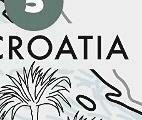











































































































AUSTRIA
Hotel Schloss Dürnstein Dürnstein Hotel Singer Berwang
MÖRWALD Hotel am Wagram Feuersbrunn am Wagram Post Lech Arlberg Lech am Arlberg
SPA-HOTEL Jagdhof Neustift
Taubenkobel Schützen am Gebirge Tennerhof Gourmet & Spa de Charme Hotel Kitzbühel The Amauris Vienna Vienna
Château de Vignée Villers-sur-Lesse
Domaine La Butte aux Bois Lanaken Hotel Franq Antwerp Hotel Heritage Bruges Kasteel van Ordingen Sint-Truiden
Le Chalet de la Forêt Brussels Pastorale Rumst
BULGARIA
Zornitza Family Estate (Melnik Region)
CROATIA
Hotel Bastion Zadar Zadar
Lešić Dimitri Palace Korčula Maslina Resort Stari Grad, Hvar
Meneghetti Wine Hotel & Winery Bale Villa Korta Katarina & Winery Orebić
Dragsholm Slot Hørve Dyvig Badehotel Nordborg
Falsled Kro Millinge


Restaurant Frederikshøj Aarhus Restaurant Kong Hans Kælder Copenhagen Restaurant Lieffroy Nyborg
Bülow Palais Dresden Burg Schwarzenstein Geisenheim
Gutshaus Stolpe Stolpe bei Anklam
Gut Steinbach Hotel Chalets Spa Reit im Winkl Hardenberg BurgHotel Nörten-Hardenberg Hotel & Restaurant Purs Andernach Hotel Bareiss Baiersbronn-Mitteltal Hotel Dollenberg Bad Peterstal-Griesbach Hotel Hohenhaus Herleshausen
Hotel Jagdhof Glashütte Bad Laasphe Hotel Schwarzmatt Badenweiler-Therme Hotel Seesteg Norderney
Landhaus Stricker Tinnum (Sylt Island)
Landromantik Hotel Oswald Kaikenried
Restaurant Lafleur Frankfurt am Main
Restaurant Schote Essen
Schlosshotel Burg Schlitz Hohen Demzin Villa Hammerschmiede Pfinztal-Söllingen
VILLINO Bodolz
WEISSENHAUS Grand Village Resort & Spa am Meer Weissenhaus
Avaton Luxury Hotel & Villas

Chalkidiki
Elounda Mare Hotel Elounda
Myconian Ambassador Thalasso Spa Mykonos
Korali Mykonos
Utopia Resort Mykonos
Ballyfin Demesne
Ballynahinch Castle Recess (Co. Galway)
Cashel Palace Cashel (Co. Tipperary)
Marlfield House Gorey (Co. Wexford)
Park Hotel Kenmare Kenmare (Co. Kerry)
Sheen Falls Lodge Kenmare (Co. Kerry)
Agli Amici dal 1887 Udine
Antica Corona Reale Cervere
Arnolfo Colle Val d’Elsa
Bellevue Hotel & Spa Cogne
Bellevue Syrene 1820 Sorrento
Borgo dei Conti Resort Perugia
Borgo Santandrea Amalfi
Caesar Augustus Capri
Caino Montemerano
Capofaro Locanda & Malvasia Salina, Aeolian Islands, Sicily
Castel Fragsburg Merano
Castello Banfi Wine Resort Montalcino
Castello di Guarene Guarene
Château Monfort Milan
Da Vittorio Brusaporto
Dal Pescatore Santini Canneto sull’Oglio
Don Alfonso 1890 S. Agata sui Due Golfi
Enoteca Pinchiorri Florence
Gallia Palace Beach Golf & Spa Resort Punta Ala
Gardena Grödnerhof Hotel & Spa Ortisei
Grand Hotel Duchi d’Aosta Trieste
Hermitage Hotel & Spa Breuil-Cervinia
Hotel Borgo San Felice Castelnuovo Berardenga
Hotel Il San Corrado di Noto Noto, Sicily
Hotel Plaza e de Russie Viareggio
Hotel Raphaël Rome
Hotel Villa Franceschi Mira
Il Borro San Giustino Valdarno
Il Bottaccio Montignoso
Il Luogo di Aimo e Nadia Milan
Il Pagliaccio Rome
Il San Pietro di Positano Positano
L’Albereta Erbusco
La Meridiana Hotel & Golf Resort Garlenda
La Sommità Relais Ostuni
Le Calandre Sarmeola di Rubano
Locanda Don Serafino Ragusa, Sicily
Londra Palace Venezia Venice
Monaci delle Terre Nere Zafferana Etnea, Sicily
Palazzo Seneca Norcia
Petra Segreta Resort & Spa San Pantaleo, Sardinia
Quadri Restaurant Venice
Relais Il Falconiere & Spa Cortona
Taverna Estia Brusciano
Terra - The Magic Place Sarentino
Villa Abbazia Follina
Villa Cordevigo Wine Relais Cavaion Veronese
Villa Crespi Orta San Giulio
Villa della Pergola Alassio
Villa Fiordaliso Gardone Riviera
LEBANON
Hotel Albergo Beirut
LIECHTENSTEIN
Ballyfin (Co. Laois)
• • • • • • • • • • • • • • • • • • • • • • • • • • • • • • • • • • • • • • • • • • • • • • •
• • • • • • • • • • • • • • • • • • • • • • • • • • • • • • • • • • • • • • • • • • • • • • • • • • • • • • • • • •
• • • • • • • • • • • • • • • • HotelRestaurantSpaVilla
• • • • • • • • • • •
LITHUANIA
Stikliai Hotel Vilnius
LUXEMBOURG
Hôtel Le Place d’Armes Luxembourg
The Xara Palace Mdina
NETHERLANDS
Bij Jef Den Hoorn-Texel Central Park Voorburg Voorburg
Château Neercanne Maastricht
Château St. Gerlach Valkenburg aan de Geul
Landgoed Hotel Het Roode Koper Leuvenum (Ermelo) Restaurant Da Vinci Maasbracht Weeshuis Gouda Gouda
NORWAY
Hotel Union Øye Norangsfjorden
POLAND
Hotel Copernicus Krakow Quadrille Gdynia
PORTUGAL
Bela Vista Hotel & Spa Portimão Belcanto Lisbon Casa da Calçada Amarante
Casa Velha do Palheiro Funchal
Fortaleza do Guincho Cascais
Grand House Vila Real de St. António Herdade da Malhadinha Nova Beja
Quinta Nova Winery House Sabrosa
The Yeatman Vila Nova de Gaia Valverde Hotel Lisbon
Epoque Hotel Bucharest Le Bistrot Français Bucharest
SLOVENIA
Hotel Grad Otočec Otočec Kendov Dvorec Spodnja Idrija
A Quinta da Auga Hotel & Spa Santiago de Compostela
Akelarre – Restaurant & Hotel San Sebastian
Atrio Restaurante Hotel Cáceres
Castillo de Arteaga Gautegiz Arteaga
Echaurren Ezcaray
El Castell de Ciutat La Seu d’Urgell
Faustino Gran Ciutadella de Menorca
Fontenille Menorca - Santa Ponsa Alaior
Fontenille Menorca - Torre Vella Alaior
Heritage Madrid Hotel Madrid
Hotel Neri Barcelona
Hotel Orfila Madrid
La Fonda Hotel Marbella
La Torre del Visco Fuentespalda
La Vella Farga Lladurs
Mas de Torrent Hotel & Spa Torrent
Mirador de Dalt Vila Ibiza
Molino de Alcuneza Sigüenza Palacio de Luces Luces - Lastres (Colunga)
Restaurante Arzak
San Sebastian
Restaurante Coque Madrid
Son Brull Hotel & Spa Pollença
Aïda Hotel & Spa Crans-Montana
Alex Lake Zürich Thalwil
Beau-Rivage Hotel Neuchâtel Bellevue Parkhotel & Spa Adelboden Castello del Sole Beach Resort & Spa Ascona
Chalet Hotel Schönegg Zermatt
Chasa Montana Hotel & Spa Samnaun Domaine de Châteauvieux Genève-Satigny
Grand Hôtel du Lac Vevey
Hostellerie Du Pas de L’Ours Crans-Montana
Hôtel de la Cigogne Geneva
Hotel Restaurant Krone Regensberg Regensberg
Hôtel Victoria Montreux-Glion Hotel Walther Pontresina
In Lain Hotel Cadonau Brail
Le Chalet d’Adrien Verbier
Lenkerhof gourmet spa resort Lenk im Simmental Maison Décotterd Glion
Restaurant de l’Hôtel de Ville Crissier Schlosshotel Chastè Tarasp
Villa Principe Leopoldo Lugano Waldhotel Doldenhorn Kandersteg Walliserhof Grand-Hotel & Spa Saas-Fee
TURKEY
Museum Hotel Nevsehir (Cappadocia)
UNITED KINGDOM
11 Cadogan Gardens Chelsea, London
Airds Hotel & Restaurant Appin
Amberley Castle Amberley Bibendum Chelsea, London
Buckland Manor Buckland (Broadway)
Chewton Glen New Milton
Cliveden House Berkshire
Farlam Hall Hotel & Restaurant Brampton (Cumbria)
Gidleigh Park Chagford
Gilpin Hotel & Lake House Windermere
Glenapp Castle Ballantrae
Grantley Hall Ripon
Gravetye Manor West Hoathly
Hambleton Hall Oakham (Rutland)
Hartwell House Hotel, Restaurant & Spa Buckinghamshire
Kinloch House Blairgowrie (Perthshire)
Longueville Manor St Saviour
Lucknam Park Hotel & Spa Colerne (Bath)
Lympstone Manor Hotel, Restaurant and Vineyard Exmouth
Mallory Court Country House Hotel & Spa Leamington Spa
Palé Hall Bala
The Bath Priory Bath
The Idle Rocks St Mawes
The Vineyard Newbury Thornbury Castle Thornbury
HotelRestaurantSpaVilla
• • • • • • • • • • • • • • • • • • • • • • • • • • • • • • • • • • • • • • • • • • • • • • •
• • • • • • • • • • • • • • • • • • • • • • • • • • • • • • • • • • • • • • • • • • • • • • • • • • • •
• • • • • • • • • • • • • • • • • • • • •
• • • • • • • • • • • • • •
Discover our properties in Europe

TIMOR SEA









BISMARCK SEA SOLOMON SEA CORAL SEA GREAT AUSTRALIAN BIGHT














ARAFURA SEA
TASMAN SEA





























Hentley Farm Restaurant Seppeltsfield
Laura at Pt Leo Estate Merricks
Tetsuya’s Restaurant Sydney
Le Bora Bora Vaitape, Bora-Bora
Le Nuku Hiva Taiohae, Nuku Hiva
Le Taha’a Patio-Taha’a, Tahiti
Blanket Bay Glenorchy
Helena Bay Lodge Hikurangi
Matakauri Lodge Queenstown
Otahuna Lodge Canterbury
The Farm at Cape Kidnappers Hawkes Bay
The Lodge at Kauri Cliffs Matauri Bay
Wharekauhau Country Estate Featherston
HotelRestaurantSpaVilla

Discover our properties in Oceania
• • • • • • • • • •
• • • • • • • • • • • • •
• • • • • •
• • • • • • • • •

 Philippe Gombert
Philippe Gombert
Lars Seifert
Juliette MéhayeLes Digitalistes
Editorial consultant Boris Coridian Project managers Mona Namrooty with Mathilde Costes Art Direction Virginie Oudard Designers Delphine Delastre, Luna Nativel Photo editor Agathe Renaudat Copy editor Ian Cameron Translation Tagline

Olivier Bauer, Ian Belcher, Sylvie Berkowicz, Jonathan Bousfield, Sabine Bouvet, Marie-Christine Clément, Anne-Charlotte De Langhe, Jancee Dunn, Alena Eckelmann, Hélène Huret, Juliet Izon, Eugénio Mailler, Charles Michel, Olivier Reneau, Per Risnes, Christian Simenc, Nathan Thornburgh, Qin Xie

Contributing photographers Nathalie Cantacuzino, Jérôme Galland, Alba Giné, Olivier Metzger, Taja Košir Popovič, SofijaSilvia, Florent Tanet with Ella Perdereau (Set design), Roberta Valerio, Benni Valsson, Clay Williams Maps Marie Bastide Studio
TRAVEL BOOK
is published by Relais & Châteaux® 58-60, rue de Prony, 75017 Paris, France. SIRET 306 446 675 00077 Any reproduction, even in part, is prohibited. Trademarks, utility models and designs registered and protected for Relais & Châteaux® Legal registration in November 2022 content@relaischateaux.com
Photoengraving Compos Juliot Print Management Séverine Breton - Egon Paris Printing MAESTRO – ELCOGRAF Bergame Environmental Features

For Relais & Châteaux, sustainable development is of crucial importance. The production of this publication has, therefore, been strictly controlled in terms of choices and commitments.
In accordance with established case law, Relais & Châteaux® cannot be held liable in the event of involuntary omissions or errors, despite the care exercised and the verifications made in connection with the production of this book.
You can book a stay or an itinerary via our website 24/7 RELAISCHATEAUX.COM
FROM EUROPE & MIDDLE EAST
Austria +43 720 828 018
Belgium +32 2 216 7725
France +33 1 76 49 39 39
Germany +49 69 96 75 91 17
Ireland +353 1 685 9351
Israel +972 72 223 7534
Italy +39 02 6269 0064
Kazakhstan +7 727 350 5459
Luxembourg +352 20 20 42 91
Netherlands +31 20 225 3747 Portugal +351 30 450 0092 Russia* 8 800 707 3841 Spain +34 93 317 66 33 Switzerland +41 22 508 3001 Ukraine +380 89 323 9891
United Arab Emirates* 800 035 703 552 United Kingdom +44 203 519 1967
FROM THE AMERICAS
Brazil* 0800 892 4042
Canada* +1 800 735 2478 Mexico +52 55 5705 1717
United States* +1 800 735 2478 En español** +54 11 4326 3861
FROM ASIA-PACIFIC
Australia +61 283246559
China* 4001 203 186 Hong Kong* 800 905 767 Taiwan* 0080 665 1992 India +91 124 430 9400 Japan* 0800 888 3326 New Zealand +64 98846157 Singapore* 1800 733 2460
South Korea* 00798 8521 0002 Other Asia-Pacific** +65 3158 3022
Please call us at the International Bookings Center in France +33 1 45 72 96 50**
To book your stay, you can also write us at reservation@relaischateaux.com (from Europe-Middle East), rc-usa@relaischateaux.com (from the Americas) or rc-asia@relaischateaux.com (from Asia-Pacific)
Send us an e-mail at commercial@relaischateaux.com or call +33 1 45 72 96 88**
VISIT OUR BOUTIQUE IN PARIS
Come see us for travel ideas, reservations, wedding lists or gift boxes at our boutique 34, avenue de l’Opéra, 75002 Paris, France. Tel. +33 1 45 72 96 88**
#relaischateaux
#deliciousjourneys
Local charges apply to all telephone calls, except where noted. *Toll-free numbers **International charges may apply All rates listed for the properties include service, unless specified: t. (tax), s. (service), s.n.i. (service excluded)
Create you own delicious journeys.



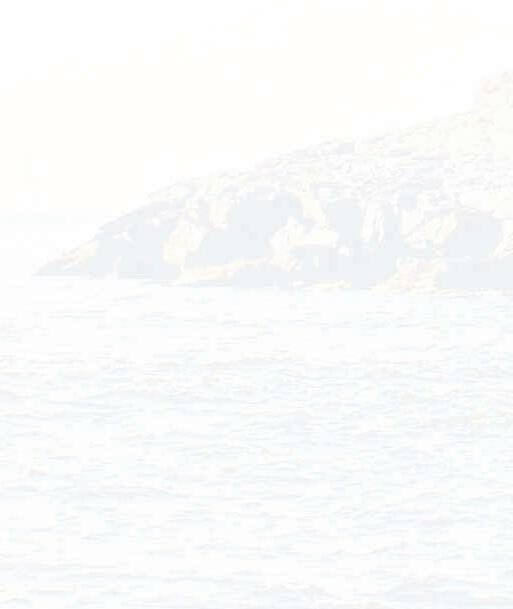



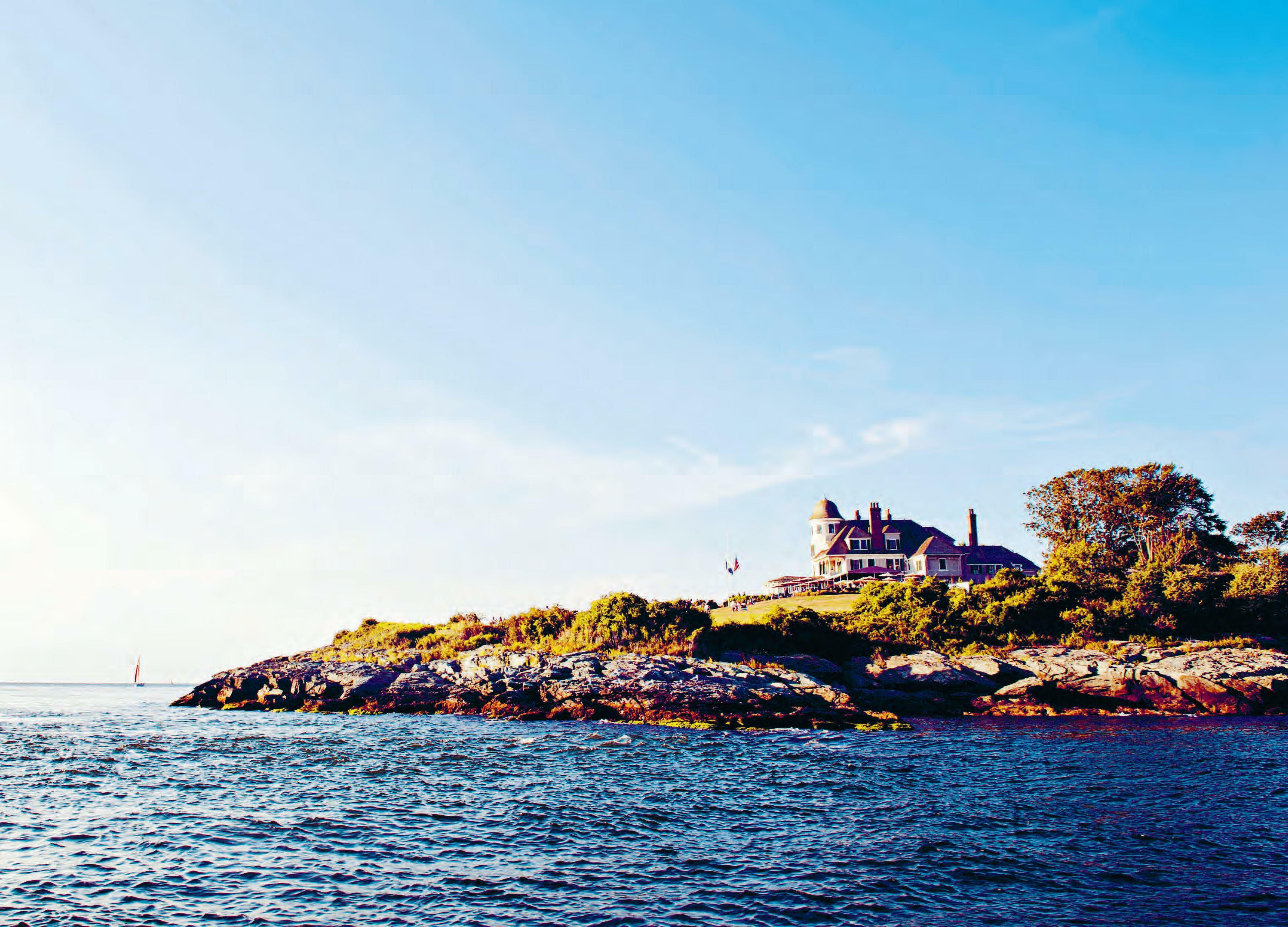
Create your own delicious journeys.


 Castle Hill Inn, Newport, Rhode Island, United States
Castle Hill Inn, Newport, Rhode Island, United States
Relais & Châteaux, established in 1954, is an association of 580 unique hotels and restaurants throughout the world, owned and operated by independent entrepreneurs–most often families–who are passionate about their craft and deeply committed to forging warm, lasting relationships with their guests. Relais & Châteaux properties protect and promote the wealth and diversity of the world’s culinary and hospitality traditions, to ensure they continue to thrive. They are equally dedicated to preserving local heritage and the environment, as articulated in the association’s Vision presented to UNESCO in November 2014.
relaischateaux.com
